

Is Time Travel Possible?
We all travel in time! We travel one year in time between birthdays, for example. And we are all traveling in time at approximately the same speed: 1 second per second.
We typically experience time at one second per second. Credit: NASA/JPL-Caltech
NASA's space telescopes also give us a way to look back in time. Telescopes help us see stars and galaxies that are very far away . It takes a long time for the light from faraway galaxies to reach us. So, when we look into the sky with a telescope, we are seeing what those stars and galaxies looked like a very long time ago.
However, when we think of the phrase "time travel," we are usually thinking of traveling faster than 1 second per second. That kind of time travel sounds like something you'd only see in movies or science fiction books. Could it be real? Science says yes!

This image from the Hubble Space Telescope shows galaxies that are very far away as they existed a very long time ago. Credit: NASA, ESA and R. Thompson (Univ. Arizona)
How do we know that time travel is possible?
More than 100 years ago, a famous scientist named Albert Einstein came up with an idea about how time works. He called it relativity. This theory says that time and space are linked together. Einstein also said our universe has a speed limit: nothing can travel faster than the speed of light (186,000 miles per second).
Einstein's theory of relativity says that space and time are linked together. Credit: NASA/JPL-Caltech
What does this mean for time travel? Well, according to this theory, the faster you travel, the slower you experience time. Scientists have done some experiments to show that this is true.
For example, there was an experiment that used two clocks set to the exact same time. One clock stayed on Earth, while the other flew in an airplane (going in the same direction Earth rotates).
After the airplane flew around the world, scientists compared the two clocks. The clock on the fast-moving airplane was slightly behind the clock on the ground. So, the clock on the airplane was traveling slightly slower in time than 1 second per second.
Credit: NASA/JPL-Caltech
Can we use time travel in everyday life?
We can't use a time machine to travel hundreds of years into the past or future. That kind of time travel only happens in books and movies. But the math of time travel does affect the things we use every day.
For example, we use GPS satellites to help us figure out how to get to new places. (Check out our video about how GPS satellites work .) NASA scientists also use a high-accuracy version of GPS to keep track of where satellites are in space. But did you know that GPS relies on time-travel calculations to help you get around town?
GPS satellites orbit around Earth very quickly at about 8,700 miles (14,000 kilometers) per hour. This slows down GPS satellite clocks by a small fraction of a second (similar to the airplane example above).

GPS satellites orbit around Earth at about 8,700 miles (14,000 kilometers) per hour. Credit: GPS.gov
However, the satellites are also orbiting Earth about 12,550 miles (20,200 km) above the surface. This actually speeds up GPS satellite clocks by a slighter larger fraction of a second.
Here's how: Einstein's theory also says that gravity curves space and time, causing the passage of time to slow down. High up where the satellites orbit, Earth's gravity is much weaker. This causes the clocks on GPS satellites to run faster than clocks on the ground.
The combined result is that the clocks on GPS satellites experience time at a rate slightly faster than 1 second per second. Luckily, scientists can use math to correct these differences in time.

If scientists didn't correct the GPS clocks, there would be big problems. GPS satellites wouldn't be able to correctly calculate their position or yours. The errors would add up to a few miles each day, which is a big deal. GPS maps might think your home is nowhere near where it actually is!
In Summary:
Yes, time travel is indeed a real thing. But it's not quite what you've probably seen in the movies. Under certain conditions, it is possible to experience time passing at a different rate than 1 second per second. And there are important reasons why we need to understand this real-world form of time travel.
If you liked this, you may like:
Is time travel possible? Why one scientist says we 'cannot ignore the possibility.'

A common theme in science-fiction media , time travel is captivating. It’s defined by the late philosopher David Lewis in his essay “The Paradoxes of Time Travel” as “[involving] a discrepancy between time and space time. Any traveler departs and then arrives at his destination; the time elapsed from departure to arrival … is the duration of the journey.”
Time travel is usually understood by most as going back to a bygone era or jumping forward to a point far in the future . But how much of the idea is based in reality? Is it possible to travel through time?
Is time travel possible?
According to NASA, time travel is possible , just not in the way you might expect. Albert Einstein’s theory of relativity says time and motion are relative to each other, and nothing can go faster than the speed of light , which is 186,000 miles per second. Time travel happens through what’s called “time dilation.”
Time dilation , according to Live Science, is how one’s perception of time is different to another's, depending on their motion or where they are. Hence, time being relative.
Learn more: Best travel insurance
Dr. Ana Alonso-Serrano, a postdoctoral researcher at the Max Planck Institute for Gravitational Physics in Germany, explained the possibility of time travel and how researchers test theories.
Space and time are not absolute values, Alonso-Serrano said. And what makes this all more complex is that you are able to carve space-time .
“In the moment that you carve the space-time, you can play with that curvature to make the time come in a circle and make a time machine,” Alonso-Serrano told USA TODAY.
She explained how, theoretically, time travel is possible. The mathematics behind creating curvature of space-time are solid, but trying to re-create the strict physical conditions needed to prove these theories can be challenging.
“The tricky point of that is if you can find a physical, realistic, way to do it,” she said.
Alonso-Serrano said wormholes and warp drives are tools that are used to create this curvature. The matter needed to achieve curving space-time via a wormhole is exotic matter , which hasn’t been done successfully. Researchers don’t even know if this type of matter exists, she said.
“It's something that we work on because it's theoretically possible, and because it's a very nice way to test our theory, to look for possible paradoxes,” Alonso-Serrano added.
“I could not say that nothing is possible, but I cannot ignore the possibility,” she said.
She also mentioned the anecdote of Stephen Hawking’s Champagne party for time travelers . Hawking had a GPS-specific location for the party. He didn’t send out invites until the party had already happened, so only people who could travel to the past would be able to attend. No one showed up, and Hawking referred to this event as "experimental evidence" that time travel wasn't possible.
What did Albert Einstein invent?: Discoveries that changed the world
Just Curious for more? We've got you covered
USA TODAY is exploring the questions you and others ask every day. From "How to watch the Marvel movies in order" to "Why is Pluto not a planet?" to "What to do if your dog eats weed?" – we're striving to find answers to the most common questions you ask every day. Head to our Just Curious section to see what else we can answer for you.
- Skip to main content
- Keyboard shortcuts for audio player

- LISTEN & FOLLOW
- Apple Podcasts
- Google Podcasts
- Amazon Music
- Amazon Alexa
Your support helps make our show possible and unlocks access to our sponsor-free feed.
Paradox-Free Time Travel Is Theoretically Possible, Researchers Say

Matthew S. Schwartz

A dog dressed as Marty McFly from Back to the Future attends the Tompkins Square Halloween Dog Parade in 2015. New research says time travel might be possible without the problems McFly encountered. Timothy A. Clary/AFP via Getty Images hide caption
A dog dressed as Marty McFly from Back to the Future attends the Tompkins Square Halloween Dog Parade in 2015. New research says time travel might be possible without the problems McFly encountered.
"The past is obdurate," Stephen King wrote in his book about a man who goes back in time to prevent the Kennedy assassination. "It doesn't want to be changed."
Turns out, King might have been on to something.
Countless science fiction tales have explored the paradox of what would happen if you went back in time and did something in the past that endangered the future. Perhaps one of the most famous pop culture examples is in Back to the Future , when Marty McFly goes back in time and accidentally stops his parents from meeting, putting his own existence in jeopardy.
But maybe McFly wasn't in much danger after all. According a new paper from researchers at the University of Queensland, even if time travel were possible, the paradox couldn't actually exist.
Researchers ran the numbers and determined that even if you made a change in the past, the timeline would essentially self-correct, ensuring that whatever happened to send you back in time would still happen.
"Say you traveled in time in an attempt to stop COVID-19's patient zero from being exposed to the virus," University of Queensland scientist Fabio Costa told the university's news service .
"However, if you stopped that individual from becoming infected, that would eliminate the motivation for you to go back and stop the pandemic in the first place," said Costa, who co-authored the paper with honors undergraduate student Germain Tobar.
"This is a paradox — an inconsistency that often leads people to think that time travel cannot occur in our universe."
A variation is known as the "grandfather paradox" — in which a time traveler kills their own grandfather, in the process preventing the time traveler's birth.
The logical paradox has given researchers a headache, in part because according to Einstein's theory of general relativity, "closed timelike curves" are possible, theoretically allowing an observer to travel back in time and interact with their past self — potentially endangering their own existence.
But these researchers say that such a paradox wouldn't necessarily exist, because events would adjust themselves.
Take the coronavirus patient zero example. "You might try and stop patient zero from becoming infected, but in doing so, you would catch the virus and become patient zero, or someone else would," Tobar told the university's news service.
In other words, a time traveler could make changes, but the original outcome would still find a way to happen — maybe not the same way it happened in the first timeline but close enough so that the time traveler would still exist and would still be motivated to go back in time.
"No matter what you did, the salient events would just recalibrate around you," Tobar said.
The paper, "Reversible dynamics with closed time-like curves and freedom of choice," was published last week in the peer-reviewed journal Classical and Quantum Gravity . The findings seem consistent with another time travel study published this summer in the peer-reviewed journal Physical Review Letters. That study found that changes made in the past won't drastically alter the future.
Bestselling science fiction author Blake Crouch, who has written extensively about time travel, said the new study seems to support what certain time travel tropes have posited all along.
"The universe is deterministic and attempts to alter Past Event X are destined to be the forces which bring Past Event X into being," Crouch told NPR via email. "So the future can affect the past. Or maybe time is just an illusion. But I guess it's cool that the math checks out."
- grandfather paradox
- time travel

Can we time travel? A theoretical physicist provides some answers
Emeritus professor, Physics, Carleton University
Disclosure statement
Peter Watson received funding from NSERC. He is affiliated with Carleton University and a member of the Canadian Association of Physicists.
Carleton University provides funding as a member of The Conversation CA.
Carleton University provides funding as a member of The Conversation CA-FR.
View all partners
- Bahasa Indonesia
Time travel makes regular appearances in popular culture, with innumerable time travel storylines in movies, television and literature. But it is a surprisingly old idea: one can argue that the Greek tragedy Oedipus Rex , written by Sophocles over 2,500 years ago, is the first time travel story .
But is time travel in fact possible? Given the popularity of the concept, this is a legitimate question. As a theoretical physicist, I find that there are several possible answers to this question, not all of which are contradictory.
The simplest answer is that time travel cannot be possible because if it was, we would already be doing it. One can argue that it is forbidden by the laws of physics, like the second law of thermodynamics or relativity . There are also technical challenges: it might be possible but would involve vast amounts of energy.
There is also the matter of time-travel paradoxes; we can — hypothetically — resolve these if free will is an illusion, if many worlds exist or if the past can only be witnessed but not experienced. Perhaps time travel is impossible simply because time must flow in a linear manner and we have no control over it, or perhaps time is an illusion and time travel is irrelevant.

Laws of physics
Since Albert Einstein’s theory of relativity — which describes the nature of time, space and gravity — is our most profound theory of time, we would like to think that time travel is forbidden by relativity. Unfortunately, one of his colleagues from the Institute for Advanced Study, Kurt Gödel, invented a universe in which time travel was not just possible, but the past and future were inextricably tangled.
We can actually design time machines , but most of these (in principle) successful proposals require negative energy , or negative mass, which does not seem to exist in our universe. If you drop a tennis ball of negative mass, it will fall upwards. This argument is rather unsatisfactory, since it explains why we cannot time travel in practice only by involving another idea — that of negative energy or mass — that we do not really understand.
Mathematical physicist Frank Tipler conceptualized a time machine that does not involve negative mass, but requires more energy than exists in the universe .
Time travel also violates the second law of thermodynamics , which states that entropy or randomness must always increase. Time can only move in one direction — in other words, you cannot unscramble an egg. More specifically, by travelling into the past we are going from now (a high entropy state) into the past, which must have lower entropy.
This argument originated with the English cosmologist Arthur Eddington , and is at best incomplete. Perhaps it stops you travelling into the past, but it says nothing about time travel into the future. In practice, it is just as hard for me to travel to next Thursday as it is to travel to last Thursday.
Resolving paradoxes
There is no doubt that if we could time travel freely, we run into the paradoxes. The best known is the “ grandfather paradox ”: one could hypothetically use a time machine to travel to the past and murder their grandfather before their father’s conception, thereby eliminating the possibility of their own birth. Logically, you cannot both exist and not exist.
Read more: Time travel could be possible, but only with parallel timelines
Kurt Vonnegut’s anti-war novel Slaughterhouse-Five , published in 1969, describes how to evade the grandfather paradox. If free will simply does not exist, it is not possible to kill one’s grandfather in the past, since he was not killed in the past. The novel’s protagonist, Billy Pilgrim, can only travel to other points on his world line (the timeline he exists in), but not to any other point in space-time, so he could not even contemplate killing his grandfather.
The universe in Slaughterhouse-Five is consistent with everything we know. The second law of thermodynamics works perfectly well within it and there is no conflict with relativity. But it is inconsistent with some things we believe in, like free will — you can observe the past, like watching a movie, but you cannot interfere with the actions of people in it.
Could we allow for actual modifications of the past, so that we could go back and murder our grandfather — or Hitler ? There are several multiverse theories that suppose that there are many timelines for different universes. This is also an old idea: in Charles Dickens’ A Christmas Carol , Ebeneezer Scrooge experiences two alternative timelines, one of which leads to a shameful death and the other to happiness.
Time is a river
Roman emperor Marcus Aurelius wrote that:
“ Time is like a river made up of the events which happen , and a violent stream; for as soon as a thing has been seen, it is carried away, and another comes in its place, and this will be carried away too.”
We can imagine that time does flow past every point in the universe, like a river around a rock. But it is difficult to make the idea precise. A flow is a rate of change — the flow of a river is the amount of water that passes a specific length in a given time. Hence if time is a flow, it is at the rate of one second per second, which is not a very useful insight.
Theoretical physicist Stephen Hawking suggested that a “ chronology protection conjecture ” must exist, an as-yet-unknown physical principle that forbids time travel. Hawking’s concept originates from the idea that we cannot know what goes on inside a black hole, because we cannot get information out of it. But this argument is redundant: we cannot time travel because we cannot time travel!
Researchers are investigating a more fundamental theory, where time and space “emerge” from something else. This is referred to as quantum gravity , but unfortunately it does not exist yet.
So is time travel possible? Probably not, but we don’t know for sure!
- Time travel
- Stephen Hawking
- Albert Einstein
- Listen to this article
- Time travel paradox
- Arthur Eddington

Faculty of Law - Academic Appointment Opportunities

Operations Manager

Senior Education Technologist

Audience Development Coordinator (fixed-term maternity cover)

Lecturer (Hindi-Urdu)
A Student Just Proved Paradox-Free Time Travel Is Possible
Now we can all go back to 2019.

- This follows recent research observing that the present is not changed by a time-traveling qubit.
- It's still not very nice to step on butterflies, though.
In a peer-reviewed paper, an honors undergraduate student says he has mathematically proven the physical feasibility of a specific kind of time travel. The paper appears in Classical and Quantum Gravity .
University of Queensland student Germain Tobar, who the university’s press release calls “prodigious,” worked with UQ physics professor Fabio Costa on this paper . In “ Reversible dynamics with closed time-like curves and freedom of choice ,” Tobar and Costa say they’ve found a middle ground in mathematics that solves a major logical paradox in one model of time travel. Let’s dig in.
The math itself is complex, but it boils down to something fairly simple. Time travel discussion focuses on closed time-like curves (CTCs), something Albert Einstein first posited. And Tobar and Costa say that as long as just two pieces of an entire scenario within a CTC are still in “causal order” when you leave, the rest is subject to local free will.
“Our results show that CTCs are not only compatible with determinism and with the local 'free choice' of operations, but also with a rich and diverse range of scenarios and dynamical processes,” their paper concludes.
In a university statement, Costa illustrates the science with an analogy:
“Say you travelled in time, in an attempt to stop COVID-19's patient zero from being exposed to the virus. However if you stopped that individual from becoming infected, that would eliminate the motivation for you to go back and stop the pandemic in the first place. This is a paradox, an inconsistency that often leads people to think that time travel cannot occur in our universe. [L]ogically it's hard to accept because that would affect our freedom to make any arbitrary action. It would mean you can time travel, but you cannot do anything that would cause a paradox to occur."
Some outcomes of this are grouped as the “ butterfly effect ,” which refers to unintended large consequences of small actions. But the real truth, in terms of the mathematical outcomes, is more like another classic parable: the monkey’s paw. Be careful what you wish for, and be careful what you time travel for. Tobar explains in the statement:
“In the coronavirus patient zero example, you might try and stop patient zero from becoming infected, but in doing so you would catch the virus and become patient zero, or someone else would. No matter what you did, the salient events would just recalibrate around you. Try as you might to create a paradox, the events will always adjust themselves, to avoid any inconsistency.”
While that sounds frustrating for the person trying to prevent a pandemic or kill Hitler, for mathematicians, it helps to smooth a fundamental speed bump in the way we think about time. It also fits with quantum findings from Los Alamos , for example, and the way random walk mathematics behave in one and two dimensions.
At the very least, this research suggests that anyone eventually designing a way to meaningfully travel in time could do so and experiment without an underlying fear of ruining the world—at least not right away.

Caroline Delbert is a writer, avid reader, and contributing editor at Pop Mech. She's also an enthusiast of just about everything. Her favorite topics include nuclear energy, cosmology, math of everyday things, and the philosophy of it all.
.css-cuqpxl:before{padding-right:0.3125rem;content:'//';display:inline;} Pop Mech Pro .css-xtujxj:before{padding-left:0.3125rem;content:'//';display:inline;}

The U.S. Has Built an Unstoppable Microwave Weapon

China Could Rule the Seas With This New Tech

The Truth About Walt Disney’s Frozen Head
Smart Home Tech To Automate Your Morning Routine

Repair Stripped Threads with Professional Results

Our Tried-and-True Drywall Repair Hacks

Immortality Is Possible if We Beat One Physics Law

The F-22 Raptor Has Clawed Back From the Brink
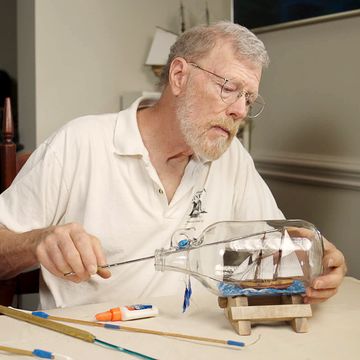
Watch a Master Craftsman Create a Ship in a Bottle

The Army Has a Plan to Kill Drones

Inside the Final Minutes of a Horrible Train Wreck
Time travel: Is it possible?
Science says time travel is possible, but probably not in the way you're thinking.

Albert Einstein's theory
- General relativity and GPS
- Wormhole travel
- Alternate theories
Science fiction
Is time travel possible? Short answer: Yes, and you're doing it right now — hurtling into the future at the impressive rate of one second per second.
You're pretty much always moving through time at the same speed, whether you're watching paint dry or wishing you had more hours to visit with a friend from out of town.
But this isn't the kind of time travel that's captivated countless science fiction writers, or spurred a genre so extensive that Wikipedia lists over 400 titles in the category "Movies about Time Travel." In franchises like " Doctor Who ," " Star Trek ," and "Back to the Future" characters climb into some wild vehicle to blast into the past or spin into the future. Once the characters have traveled through time, they grapple with what happens if you change the past or present based on information from the future (which is where time travel stories intersect with the idea of parallel universes or alternate timelines).
Related: The best sci-fi time machines ever
Although many people are fascinated by the idea of changing the past or seeing the future before it's due, no person has ever demonstrated the kind of back-and-forth time travel seen in science fiction or proposed a method of sending a person through significant periods of time that wouldn't destroy them on the way. And, as physicist Stephen Hawking pointed out in his book " Black Holes and Baby Universes" (Bantam, 1994), "The best evidence we have that time travel is not possible, and never will be, is that we have not been invaded by hordes of tourists from the future."
Science does support some amount of time-bending, though. For example, physicist Albert Einstein 's theory of special relativity proposes that time is an illusion that moves relative to an observer. An observer traveling near the speed of light will experience time, with all its aftereffects (boredom, aging, etc.) much more slowly than an observer at rest. That's why astronaut Scott Kelly aged ever so slightly less over the course of a year in orbit than his twin brother who stayed here on Earth.
Related: Controversially, physicist argues that time is real
There are other scientific theories about time travel, including some weird physics that arise around wormholes , black holes and string theory . For the most part, though, time travel remains the domain of an ever-growing array of science fiction books, movies, television shows, comics, video games and more.

Einstein developed his theory of special relativity in 1905. Along with his later expansion, the theory of general relativity , it has become one of the foundational tenets of modern physics. Special relativity describes the relationship between space and time for objects moving at constant speeds in a straight line.
The short version of the theory is deceptively simple. First, all things are measured in relation to something else — that is to say, there is no "absolute" frame of reference. Second, the speed of light is constant. It stays the same no matter what, and no matter where it's measured from. And third, nothing can go faster than the speed of light.
From those simple tenets unfolds actual, real-life time travel. An observer traveling at high velocity will experience time at a slower rate than an observer who isn't speeding through space.
While we don't accelerate humans to near-light-speed, we do send them swinging around the planet at 17,500 mph (28,160 km/h) aboard the International Space Station . Astronaut Scott Kelly was born after his twin brother, and fellow astronaut, Mark Kelly . Scott Kelly spent 520 days in orbit, while Mark logged 54 days in space. The difference in the speed at which they experienced time over the course of their lifetimes has actually widened the age gap between the two men.
"So, where[as] I used to be just 6 minutes older, now I am 6 minutes and 5 milliseconds older," Mark Kelly said in a panel discussion on July 12, 2020, Space.com previously reported . "Now I've got that over his head."
General relativity and GPS time travel

The difference that low earth orbit makes in an astronaut's life span may be negligible — better suited for jokes among siblings than actual life extension or visiting the distant future — but the dilation in time between people on Earth and GPS satellites flying through space does make a difference.
Read more: Can we stop time?
The Global Positioning System , or GPS, helps us know exactly where we are by communicating with a network of a few dozen satellites positioned in a high Earth orbit. The satellites circle the planet from 12,500 miles (20,100 kilometers) away, moving at 8,700 mph (14,000 km/h).
According to special relativity, the faster an object moves relative to another object, the slower that first object experiences time. For GPS satellites with atomic clocks, this effect cuts 7 microseconds, or 7 millionths of a second, off each day, according to the American Physical Society publication Physics Central .
Read more: Could Star Trek's faster-than-light warp drive actually work?
Then, according to general relativity, clocks closer to the center of a large gravitational mass like Earth tick more slowly than those farther away. So, because the GPS satellites are much farther from the center of Earth compared to clocks on the surface, Physics Central added, that adds another 45 microseconds onto the GPS satellite clocks each day. Combined with the negative 7 microseconds from the special relativity calculation, the net result is an added 38 microseconds.
This means that in order to maintain the accuracy needed to pinpoint your car or phone — or, since the system is run by the U.S. Department of Defense, a military drone — engineers must account for an extra 38 microseconds in each satellite's day. The atomic clocks onboard don’t tick over to the next day until they have run 38 microseconds longer than comparable clocks on Earth.
Given those numbers, it would take more than seven years for the atomic clock in a GPS satellite to un-sync itself from an Earth clock by more than a blink of an eye. (We did the math: If you estimate a blink to last at least 100,000 microseconds, as the Harvard Database of Useful Biological Numbers does, it would take thousands of days for those 38 microsecond shifts to add up.)
This kind of time travel may seem as negligible as the Kelly brothers' age gap, but given the hyper-accuracy of modern GPS technology, it actually does matter. If it can communicate with the satellites whizzing overhead, your phone can nail down your location in space and time with incredible accuracy.
Can wormholes take us back in time?
General relativity might also provide scenarios that could allow travelers to go back in time, according to NASA . But the physical reality of those time-travel methods is no piece of cake.
Wormholes are theoretical "tunnels" through the fabric of space-time that could connect different moments or locations in reality to others. Also known as Einstein-Rosen bridges or white holes, as opposed to black holes, speculation about wormholes abounds. But despite taking up a lot of space (or space-time) in science fiction, no wormholes of any kind have been identified in real life.
Related: Best time travel movies
"The whole thing is very hypothetical at this point," Stephen Hsu, a professor of theoretical physics at the University of Oregon, told Space.com sister site Live Science . "No one thinks we're going to find a wormhole anytime soon."
Primordial wormholes are predicted to be just 10^-34 inches (10^-33 centimeters) at the tunnel's "mouth". Previously, they were expected to be too unstable for anything to be able to travel through them. However, a study claims that this is not the case, Live Science reported .
The theory, which suggests that wormholes could work as viable space-time shortcuts, was described by physicist Pascal Koiran. As part of the study, Koiran used the Eddington-Finkelstein metric, as opposed to the Schwarzschild metric which has been used in the majority of previous analyses.
In the past, the path of a particle could not be traced through a hypothetical wormhole. However, using the Eddington-Finkelstein metric, the physicist was able to achieve just that.
Koiran's paper was described in October 2021, in the preprint database arXiv , before being published in the Journal of Modern Physics D.

Alternate time travel theories
While Einstein's theories appear to make time travel difficult, some researchers have proposed other solutions that could allow jumps back and forth in time. These alternate theories share one major flaw: As far as scientists can tell, there's no way a person could survive the kind of gravitational pulling and pushing that each solution requires.
Infinite cylinder theory
Astronomer Frank Tipler proposed a mechanism (sometimes known as a Tipler Cylinder ) where one could take matter that is 10 times the sun's mass, then roll it into a very long, but very dense cylinder. The Anderson Institute , a time travel research organization, described the cylinder as "a black hole that has passed through a spaghetti factory."
After spinning this black hole spaghetti a few billion revolutions per minute, a spaceship nearby — following a very precise spiral around the cylinder — could travel backward in time on a "closed, time-like curve," according to the Anderson Institute.
The major problem is that in order for the Tipler Cylinder to become reality, the cylinder would need to be infinitely long or be made of some unknown kind of matter. At least for the foreseeable future, endless interstellar pasta is beyond our reach.
Time donuts
Theoretical physicist Amos Ori at the Technion-Israel Institute of Technology in Haifa, Israel, proposed a model for a time machine made out of curved space-time — a donut-shaped vacuum surrounded by a sphere of normal matter.
"The machine is space-time itself," Ori told Live Science . "If we were to create an area with a warp like this in space that would enable time lines to close on themselves, it might enable future generations to return to visit our time."
Amos Ori is a theoretical physicist at the Technion-Israel Institute of Technology in Haifa, Israel. His research interests and publications span the fields of general relativity, black holes, gravitational waves and closed time lines.
There are a few caveats to Ori's time machine. First, visitors to the past wouldn't be able to travel to times earlier than the invention and construction of the time donut. Second, and more importantly, the invention and construction of this machine would depend on our ability to manipulate gravitational fields at will — a feat that may be theoretically possible but is certainly beyond our immediate reach.

Time travel has long occupied a significant place in fiction. Since as early as the "Mahabharata," an ancient Sanskrit epic poem compiled around 400 B.C., humans have dreamed of warping time, Lisa Yaszek, a professor of science fiction studies at the Georgia Institute of Technology in Atlanta, told Live Science .
Every work of time-travel fiction creates its own version of space-time, glossing over one or more scientific hurdles and paradoxes to achieve its plot requirements.
Some make a nod to research and physics, like " Interstellar ," a 2014 film directed by Christopher Nolan. In the movie, a character played by Matthew McConaughey spends a few hours on a planet orbiting a supermassive black hole, but because of time dilation, observers on Earth experience those hours as a matter of decades.
Others take a more whimsical approach, like the "Doctor Who" television series. The series features the Doctor, an extraterrestrial "Time Lord" who travels in a spaceship resembling a blue British police box. "People assume," the Doctor explained in the show, "that time is a strict progression from cause to effect, but actually from a non-linear, non-subjective viewpoint, it's more like a big ball of wibbly-wobbly, timey-wimey stuff."
Long-standing franchises like the "Star Trek" movies and television series, as well as comic universes like DC and Marvel Comics, revisit the idea of time travel over and over.
Related: Marvel movies in order: chronological & release order
Here is an incomplete (and deeply subjective) list of some influential or notable works of time travel fiction:
Books about time travel:

- Rip Van Winkle (Cornelius S. Van Winkle, 1819) by Washington Irving
- A Christmas Carol (Chapman & Hall, 1843) by Charles Dickens
- The Time Machine (William Heinemann, 1895) by H. G. Wells
- A Connecticut Yankee in King Arthur's Court (Charles L. Webster and Co., 1889) by Mark Twain
- The Restaurant at the End of the Universe (Pan Books, 1980) by Douglas Adams
- A Tale of Time City (Methuen, 1987) by Diana Wynn Jones
- The Outlander series (Delacorte Press, 1991-present) by Diana Gabaldon
- Harry Potter and the Prisoner of Azkaban (Bloomsbury/Scholastic, 1999) by J. K. Rowling
- Thief of Time (Doubleday, 2001) by Terry Pratchett
- The Time Traveler's Wife (MacAdam/Cage, 2003) by Audrey Niffenegger
- All You Need is Kill (Shueisha, 2004) by Hiroshi Sakurazaka
Movies about time travel:
- Planet of the Apes (1968)
- Superman (1978)
- Time Bandits (1981)
- The Terminator (1984)
- Back to the Future series (1985, 1989, 1990)
- Star Trek IV: The Voyage Home (1986)
- Bill & Ted's Excellent Adventure (1989)
- Groundhog Day (1993)
- Galaxy Quest (1999)
- The Butterfly Effect (2004)
- 13 Going on 30 (2004)
- The Lake House (2006)
- Meet the Robinsons (2007)
- Hot Tub Time Machine (2010)
- Midnight in Paris (2011)
- Looper (2012)
- X-Men: Days of Future Past (2014)
- Edge of Tomorrow (2014)
- Interstellar (2014)
- Doctor Strange (2016)
- A Wrinkle in Time (2018)
- The Last Sharknado: It's About Time (2018)
- Avengers: Endgame (2019)
- Tenet (2020)
- Palm Springs (2020)
- Zach Snyder's Justice League (2021)
- The Tomorrow War (2021)
Television about time travel:

- Doctor Who (1963-present)
- The Twilight Zone (1959-1964) (multiple episodes)
- Star Trek (multiple series, multiple episodes)
- Samurai Jack (2001-2004)
- Lost (2004-2010)
- Phil of the Future (2004-2006)
- Steins;Gate (2011)
- Outlander (2014-2023)
- Loki (2021-present)
Games about time travel:
- Chrono Trigger (1995)
- TimeSplitters (2000-2005)
- Kingdom Hearts (2002-2019)
- Prince of Persia: Sands of Time (2003)
- God of War II (2007)
- Ratchet and Clank Future: A Crack In Time (2009)
- Sly Cooper: Thieves in Time (2013)
- Dishonored 2 (2016)
- Titanfall 2 (2016)
- Outer Wilds (2019)
Additional resources
Explore physicist Peter Millington's thoughts about Stephen Hawking's time travel theories at The Conversation . Check out a kid-friendly explanation of real-world time travel from NASA's Space Place . For an overview of time travel in fiction and the collective consciousness, read " Time Travel: A History " (Pantheon, 2016) by James Gleik.
Join our Space Forums to keep talking space on the latest missions, night sky and more! And if you have a news tip, correction or comment, let us know at: [email protected].
Get the Space.com Newsletter
Breaking space news, the latest updates on rocket launches, skywatching events and more!

Ailsa is a staff writer for How It Works magazine, where she writes science, technology, space, history and environment features. Based in the U.K., she graduated from the University of Stirling with a BA (Hons) journalism degree. Previously, Ailsa has written for Cardiff Times magazine, Psychology Now and numerous science bookazines.
Car-sized asteroid gives Earth a super-close shave with flyby closer than some satellites
SpaceX launches advanced weather satellite for US Space Force (video)
Sierra Space wants to drop cargo from orbit to anywhere on Earth in 90 minutes
Most Popular
- 2 Scientists identify origin of the 'BOAT' — the brightest cosmic blast of all time
- 3 My formal 2024 solar eclipse apology
- 4 Achoo! Baby star 'sneezes' tell astronomers a lot about their development
- 5 A NASA spacecraft spotted something weird orbiting the moon. It was just a lunar neighbor (photos)

- April 12, 2024 | Unlocking Tomorrow’s Water Secrets Through Sci-Fi
- April 12, 2024 | The Race To Save Antarctica’s Meteorites From Climate Change
- April 12, 2024 | Inhale at Your Own Risk: Even Brief Secondhand Smoke Exposure Increases Risk of Dangerous Heart Rhythm Disorder
- April 12, 2024 | Alien Atmosphere: “Rainbow” Detected on Exoplanet That Rains Molten Iron
- April 12, 2024 | Neuronal Crossroads: Decoding Brain Development
Exploring the Reality of Time Travel: Science Fact vs. Science Fiction
By Adi Foord, University of Maryland, Baltimore County November 16, 2023

Time travel, a longstanding fascination in science fiction, remains a complex and unresolved concept in science. The second law of thermodynamics suggests time can only move forward, while Einstein’s theory of relativity shows time’s relativity to speed. Theoretical ideas like wormholes offer potential methods, but practical challenges and paradoxes, such as the “grandfather paradox,” complicate the feasibility of actual time travel.
Will it ever be possible for time travel to occur?
Have you ever dreamed of traveling through time, like characters do in science fiction movies? For centuries, the concept of time travel has captivated people’s imaginations. Time travel is the concept of moving between different points in time, just like you move between different places. In movies, you might have seen characters using special machines, magical devices or even hopping into a futuristic car to travel backward or forward in time.
But is this just a fun idea for movies, or could it really happen?
The Science Behind Time Travel
The question of whether time is reversible remains one of the biggest unresolved questions in science. If the universe follows the laws of thermodynamics , it may not be possible. The second law of thermodynamics states that things in the universe can either remain the same or become more disordered over time.
It’s a bit like saying you can’t unscramble eggs once they’ve been cooked. According to this law, the universe can never go back exactly to how it was before. Time can only go forward, like a one-way street.
Time Is Relative
However, physicist Albert Einstein’s theory of special relativity suggests that time passes at different rates for different people. Someone speeding along on a spaceship moving close to the speed of light – 671 million miles per hour! – will experience time slower than a person on Earth.
People have yet to build spaceships that can move at speeds anywhere near as fast as light, but astronauts who visit the International Space Station orbit around the Earth at speeds close to 17,500 mph. Astronaut Scott Kelly has spent 520 days at the International Space Station, and as a result has aged a little more slowly than his twin brother – and fellow astronaut – Mark Kelly. Scott used to be 6 minutes younger than his twin brother. Now, because Scott was traveling so much faster than Mark and for so many days, he is 6 minutes and 5 milliseconds younger .
Theoretical Possibilities and Challenges
Some scientists are exploring other ideas that could theoretically allow time travel. One concept involves wormholes, or hypothetical tunnels in space that could create shortcuts for journeys across the universe. If someone could build a wormhole and then figure out a way to move one end at close to the speed of light – like the hypothetical spaceship mentioned above – the moving end would age more slowly than the stationary end. Someone who entered the moving end and exited the wormhole through the stationary end would come out in their past.
However, wormholes remain theoretical: Scientists have yet to spot one. It also looks like it would be incredibly challenging to send humans through a wormhole space tunnel.
Paradoxes and Failed Dinner Parties
There are also paradoxes associated with time travel. The famous “ grandfather paradox ” is a hypothetical problem that could arise if someone traveled back in time and accidentally prevented their grandparents from meeting. This would create a paradox where you were never born, which raises the question: How could you have traveled back in time in the first place? It’s a mind-boggling puzzle that adds to the mystery of time travel.
Famously, physicist Stephen Hawking tested the possibility of time travel by throwing a dinner party where invitations noting the date, time, and coordinates were not sent out until after it had happened. His hope was that his invitation would be read by someone living in the future, who had capabilities to travel back in time. But no one showed up.
As he pointed out : “The best evidence we have that time travel is not possible, and never will be, is that we have not been invaded by hordes of tourists from the future.”
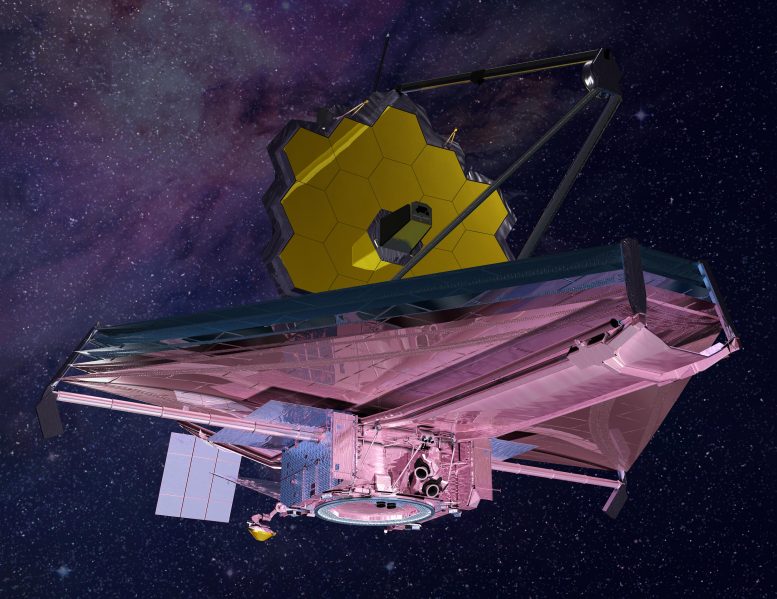
Artist’s rendering of the James Webb Space Telescope. Credit: Northrop Grumman
Telescopes Are Time Machines
Interestingly, astrophysicists armed with powerful telescopes possess a unique form of time travel . As they peer into the vast expanse of the cosmos, they gaze into the past universe. Light from all galaxies and stars takes time to travel, and these beams of light carry information from the distant past. When astrophysicists observe a star or a galaxy through a telescope, they are not seeing it as it is in the present, but as it existed when the light began its journey to Earth millions to billions of years ago.
NASA’s newest space telescope , the James Webb Space Telescope , is peering at galaxies that were formed at the very beginning of the Big Bang , about 13.7 billion years ago.
While we aren’t likely to have time machines like the ones in movies anytime soon, scientists are actively researching and exploring new ideas. But for now, we’ll have to enjoy the idea of time travel in our favorite books, movies, and dreams.
Written by Adi Foord, Assistant Professor of Astronomy and Astrophysics, University of Maryland, Baltimore County.
More on SciTechDaily

A Significant Surge: How Tropical Cyclones Increase the Cost of Carbon

Voyager’s New Horizon: NASA Engineers Tackle Thruster Buildup & Software Glitches

New ScienceCast Video Previews the ‘Opposition of Mars’

“Our Solar System May Be Unusual”: Rogue Planets Unveiled With NASA’s Roman Space Telescope

AI-Powered Lasers: A Modern Solution to Space Debris

IBS Relief: Common Drug Improves Symptoms of Irritable Bowel Syndrome

Scientists Discover Chinmo – “The Youth Gene”

Jupiter’s Moon Europa Could Be Pulling Oxygen Down Below the Ice To Feed Life
8 comments on "exploring the reality of time travel: science fact vs. science fiction".
Until the problem of the second law of thermodynamics(entropy) is solved, the concept of time travel will remain the subject of science fiction. Since this is a basic law of our universe, there is no conceivable way that we know of to do this. The great thing about our knowledge of the universe is that it continues to grow and with that our view of what is possible continues to change. After all, at one time it was believed we could never leave earth!
The 7 planets are soul pollen in the space @ life has been the world has been prepared @ The pollen of the universe is hidden @ Around the axis of the galaxy, the universe is hidden@@ The pollen of the galaxies is a hidden cluster Itis made that we thought about what wisdom is in God’s work and how it is arranged in the form of words.The verse that is made is as follows @@ John, you are in time @ worlds, planets around the axis of the branches of galaxies @@ 8 Prophets, divine prophets, God-aware witnesses @ God’s words of revelation, they are aware @@ 48 What the words of revelation that every prophet has about @ sometimes Sometimes the message of God has become a verbal cliché in the head @@ 62 The message of God was given to every prophet @ The message was made around the power of God @@ 46 The truth of the religions of the cradle of time is said in the world @ Prophets always came for justice in time @@ 62 A warrior became brave in time @ Delaver Ghahrmani Boud Taarani@@ 43 Omar Noah never died, who knows!@ Imransan Is there an unseen world, immortality!?@@ 49 Men’s rights in the sign @ Human rights, the observance of world justice @@ 40 We have God’s love @ A love that is not patched, separation!!!: @@ 39 Take one word from the end of the first and second stanzas to the bottom of these eight verbal verses, and this sentence is made @@ God-aware, the world is born, you know the sign of God @ Agah,the beginning of time, the world, eternity, the world of separation @@ The meaning of this sentence is That God, who before us humans lived on the earth, formed the earth’s crusts with full knowledge, and we humans know the sign of God, which is on the earth, on the continents and countries, and some names have been shown by God for our knowledge since the end of time.In a later video, if I have a lifetime left, I will explain exactly about these poems, God willing @@ The word of the Prophet 17 is the 17th and Muhammad (PBUH) said that the Bedouin Arabs should pray 17 rakats so that theyperform ablution and be clean and not kill and loot.From the caravans, these were all God’s will, and he is good everywhere, in every nation, God does not like evildoers, sinners, and oppressors.Muhammad (PBUH) was God’s last messenger to the Arab people, he was God’s best prophet, and the third verse is because they do not accept Muhammad (PBUH).Some Iranians who were in contact with me, that’s why in the third verse of this surah, he said that his message was given to every prophet, the message is based on divine power, and the word truth, the first two letters of which istruth, is truth, and truth is the 43rd and forty-third word, and the word is time.It is exactly 46, and this song of the Prophets was revealed at the age of 46 ببخشید اگر قبلآ مطالبی فرستادم که به مذاهب مذاهم ارتباط داد شاید به درد شما نمیخورد من در کامنت های بعدی سعی میکنم از نجوم و حیات زمین سخن بگویم این چند بیت را به خارجی انگلیسی که تبدیل کردم معنی آن حیرت انگیز تعغیر کرد گفتم برای شما بفرستم و بداند که این کلام من نبوده کلام خداوند بوده شما نظرتان در مورد خداوند چیست من میگویم خداوند که پدر ومادر انسان بودند قادر به ساختن ما بودند اما آیا آنها قادر به ساختن ستاره ها هم بودند
Your comment has validity to God. But it surely has no place here, it is only fare if the hole comment were in english and has less of a convincing push in a belief a person either believes or not.
It’s too bad physics can’t come to a complete consensus about time, I would like to add some thought about discoveries it has been proven that time travels in only one direction forward, the experiment dealt with light thru glass and how it reacts in the middle and what change happens after light exits the other side, a simple explanation of this experiment. Brings me to theorize and start that time existed before the big bang and is outside of our universes influence, when time is acted on by gravity the ( Form ) of time is changed until the influence no longer has effect, this could go hand in hand with light photons the photon has a influence in the Form that time has. This can not be a observed difference unless we were to see beyond the speed of light. We do agree that physics changes at a subatomic state and also does some strange changing once the speed of light has been exceeded.
The experiment I referred to was posted on IFL in October 2023 headlined ( Solution to complex light problem shows that time can only go Forward ).
One of the problem with travel time is the one people keep forever. And, that is that the earth is always move through space. Matter of fact, the earth is not in the same place that it was 50 years ago. So you will have to move through space as well as time.
Ironically, the only science fiction that seems to handle this is the original story “The Time Machine”.
Time travel is happening now. It has been done since the 1950s. The method satisfies all the requirements. Traveler can’t change the past, but only observe. You can’t go farther back than when the machine was first invented (1950s). There’s one more limitation, you can only observe what the machine was directed. The time machine, the common video camera, and video tape recorder. Now it’s the camera, and file capture computer. Yes, viewing a video tape is effectively going back in time. It’s more than the video, it’s the sound too. There are working versions of smell, and touch which can be recorded too. If you record, and replicate all the senses, you have effectively complete time travel. The most primitive form is the picture. This technology has been around for thousands of years, and is manually intensive. Later many pictures were strung together to make a film. Using a camera to record film was the first example of complete visual time travel (back to when the film was made). Later sound was added, and we have the movies. A way of going back in time that included sight, and sound. Now we have video systems (YouTub) that can play back past events selected by you. Yes, video systems are virtual time travel machines we have now.
How Stellar Cannibalism Illuminates Cosmic Evolution
جزایر فیلیپین دایناسوری که توسط انسان خلق شده در بیش ده ها میلیون سال و بخاطر ریخته شدن دوهزار متر خاک غرق شده بخاطر بالا آمدن آب اقیانوس اما جزایر فیلیپین شبیه دایناسوریست
The address of the above comment on the site about a thief who was trained by a dinosaur bird who was trained by humans tens of millions of years ago and who arrested murderers and robbers.The police were arrested by big birds.don’t the scientists of the world think about this?They were buried in the bed of important cities, they were buried with all the tools and machines, the traces of humans tens of millions of years ago, they had a civilization and a history of hundreds of thousands of years, they built a base underthe earth, from the meteorites that explode from the planets when they hit the sun, and they knew that several thousand meters of soil is poured on the surface of the seas and islands, and they knew that the shapes they made of the islands in thecountry of Papua may go under the ocean, of course, the Philippine islands.The picture is of a baby dinosaur that went under the ocean, but the northern island of Australia, which is Papua, is quite clear.It is a big dinosaur whose tail is towards the east and its mouth is open towards the west.There is the Philippines, but it was more difficult to take the soil to the Philippine islands to create a dinosaur than the island of Papua, that is why the height of the soil in the Philippines is lower, and when the meteorites fell a few kilometerson the surface of the ocean, the image created by humans under the ocean in the shape of a dinosaur is hidden in the American continent The picture is of a bird in the shape of a dinosaur that is flying, and this bird was made to flyby the Indians of the tribe, that bird was talking to people, but its spirit might have heard something from the police because a thief while in the bird’s mouth He was handcuffed by the police and the weapon, which is a machine gun, is fromthe east of the American continent on the coast
The country of Florida is a machine gun.When you continue to New York City, you will reach the mouth of the dinosaur, where a thief is trapped in the mouth of a bird, and the little finger of the police handcuffed the thief’s hand, and a small colt is in the hand ofthe thief, who the police caught in the mouth of the dinosaur.put in the mouth of the bird dinosaur, you can clearly see that the thief fell on the ground and was shot in the head, and it is clear that his forehead was pierced, the bird’s mouth is open in flight, the head of the birdis from the east of the American continent, and a fish is placed in the bird’s mouth in the water of the ocean.The stretched glove of the police, which is in the form of a fist, with a handcuff attached to the left hand of the thief who fell on the ground in the sea and the mouth of the bird, the head of the thief and the killer, is located towards the southwest and west coast of America.All these images were created from the American continent and islands by Humans were created, but they didn’t have enough fuel and time to create more accurate images and meteorites ruined the beauty of the images, but it is clear that all these changes were createdby humans, but you have to consider that two thousand meters of soil from meteorites are fish.And they buried the whales under the beaches, and after a very long time, the bodies of the whales turned into oil under the two thousand meters of soil on the beaches, and on the other hand, the presence of two thousand meters of soil onthe surface of the seas and droughts could not make the created images disappear.
Leave a comment Cancel reply
Email address is optional. If provided, your email will not be published or shared.
Save my name, email, and website in this browser for the next time I comment.

- Table of Contents
- Random Entry
- Chronological
- Editorial Information
- About the SEP
- Editorial Board
- How to Cite the SEP
- Special Characters
- Advanced Tools
- Support the SEP
- PDFs for SEP Friends
- Make a Donation
- SEPIA for Libraries
- Entry Contents
Bibliography
Academic tools.
- Friends PDF Preview
- Author and Citation Info
- Back to Top
Time Travel and Modern Physics
Time travel has been a staple of science fiction. With the advent of general relativity it has been entertained by serious physicists. But, especially in the philosophy literature, there have been arguments that time travel is inherently paradoxical. The most famous paradox is the grandfather paradox: you travel back in time and kill your grandfather, thereby preventing your own existence. To avoid inconsistency some circumstance will have to occur which makes you fail in this attempt to kill your grandfather. Doesn’t this require some implausible constraint on otherwise unrelated circumstances? We examine such worries in the context of modern physics.
1. Paradoxes Lost?
2. topology and constraints, 3. the general possibility of time travel in general relativity, 4. two toy models, 5. slightly more realistic models of time travel, 6. the possibility of time travel redux, 7. even if there are constraints, so what, 8. computational models, 9. quantum mechanics to the rescue, 10. conclusions, other internet resources, related entries.
- Supplement: Remarks and Limitations on the Toy Models
Modern physics strips away many aspects of the manifest image of time. Time as it appears in the equations of classical mechanics has no need for a distinguished present moment, for example. Relativity theory leads to even sharper contrasts. It replaces absolute simultaneity, according to which it is possible to unambiguously determine the time order of distant events, with relative simultaneity: extending an “instant of time” throughout space is not unique, but depends on the state of motion of an observer. More dramatically, in general relativity the mathematical properties of time (or better, of spacetime)—its topology and geometry—depend upon how matter is arranged rather than being fixed once and for all. So physics can be, and indeed has to be, formulated without treating time as a universal, fixed background structure. Since general relativity represents gravity through spacetime geometry, the allowed geometries must be as varied as the ways in which matter can be arranged. Alongside geometrical models used to describe the solar system, black holes, and much else, the scope of variation extends to include some exotic structures unlike anything astrophysicists have observed. In particular, there are spacetime geometries with curves that loop back on themselves: closed timelike curves (CTCs), which describe the possible trajectory of an observer who returns exactly back to their earlier state—without any funny business, such as going faster than the speed of light. These geometries satisfy the relevant physical laws, the equations of general relativity, and in that sense time travel is physically possible.
Yet circular time generates paradoxes, familiar from science fiction stories featuring time travel: [ 1 ]
- Consistency: Kurt plans to murder his own grandfather Adolph, by traveling along a CTC to an appropriate moment in the past. He is an able marksman, and waits until he has a clear shot at grandpa. Normally he would not miss. Yet if he succeeds, there is no way that he will then exist to plan and carry out the mission. Kurt pulls the trigger: what can happen?
- Underdetermination: Suppose that Kurt first travels back in order to give his earlier self a copy of How to Build a Time Machine. This is the same book that allows him to build a time machine, which he then carries with him on his journey to the past. Who wrote the book?
- Easy Knowledge: A fan of classical music enhances their computer with a circuit that exploits a CTC. This machine efficiently solves problems at a higher level of computational complexity than conventional computers, leading (among other things) to finding the smallest circuits that can generate Bach’s oeuvre—and to compose new pieces in the same style. Such easy knowledge is at odds with our understanding of our epistemic predicament. (This third paradox has not drawn as much attention.)
The first two paradoxes were once routinely taken to show that solutions with CTCs should be rejected—with charges varying from violating logic, to being “physically unreasonable”, to undermining the notion of free will. Closer analysis of the paradoxes has largely reversed this consensus. Physicists have discovered many solutions with CTCs and have explored their properties in pursuing foundational questions, such as whether physics is compatible with the idea of objective temporal passage (starting with Gödel 1949). Philosophers have also used time travel scenarios to probe questions about, among other things, causation, modality, free will, and identity (see, e.g., Earman 1972 and Lewis’s seminal 1976 paper).
We begin below with Consistency , turning to the other paradoxes in later sections. A standard, stone-walling response is to insist that the past cannot be changed, as a matter of logic, even by a time traveler (e.g., Gödel 1949, Clarke 1977, Horwich 1987). Adolph cannot both die and survive, as a matter of logic, so any scheme to alter the past must fail. In many of the best time travel fictions, the actions of a time traveler are constrained in novel and unexpected ways. Attempts to change the past fail, and they fail, often tragically, in just such a way that they set the stage for the time traveler’s self-defeating journey. The first question is whether there is an analog of the consistent story when it comes to physics in the presence of CTCs. As we will see, there is a remarkable general argument establishing the existence of consistent solutions. Yet a second question persists: why can’t time-traveling Kurt kill his own grandfather? Doesn’t the necessity of failures to change the past put unusual and unexpected constraints on time travelers, or objects that move along CTCs? The same argument shows that there are in fact no constraints imposed by the existence of CTCs, in some cases. After discussing this line of argument, we will turn to the palatability and further implications of such constraints if they are required, and then turn to the implications of quantum mechanics.
Wheeler and Feynman (1949) were the first to claim that the fact that nature is continuous could be used to argue that causal influences from later events to earlier events, as are made possible by time travel, will not lead to paradox without the need for any constraints. Maudlin (1990) showed how to make their argument precise and more general, and argued that nonetheless it was not completely general.
Imagine the following set-up. We start off having a camera with a black and white film ready to take a picture of whatever comes out of the time machine. An object, in fact a developed film, comes out of the time machine. We photograph it, and develop the film. The developed film is subsequently put in the time machine, and set to come out of the time machine at the time the picture is taken. This surely will create a paradox: the developed film will have the opposite distribution of black, white, and shades of gray, from the object that comes out of the time machine. For developed black and white films (i.e., negatives) have the opposite shades of gray from the objects they are pictures of. But since the object that comes out of the time machine is the developed film itself it we surely have a paradox.
However, it does not take much thought to realize that there is no paradox here. What will happen is that a uniformly gray picture will emerge, which produces a developed film that has exactly the same uniform shade of gray. No matter what the sensitivity of the film is, as long as the dependence of the brightness of the developed film depends in a continuous manner on the brightness of the object being photographed, there will be a shade of gray that, when photographed, will produce exactly the same shade of gray on the developed film. This is the essence of Wheeler and Feynman’s idea. Let us first be a bit more precise and then a bit more general.
For simplicity let us suppose that the film is always a uniform shade of gray (i.e., at any time the shade of gray does not vary by location on the film). The possible shades of gray of the film can then be represented by the (real) numbers from 0, representing pure black, to 1, representing pure white.
Let us now distinguish various stages in the chronological order of the life of the film. In stage \(S_1\) the film is young; it has just been placed in the camera and is ready to be exposed. It is then exposed to the object that comes out of the time machine. (That object in fact is a later stage of the film itself). By the time we come to stage \(S_2\) of the life of the film, it has been developed and is about to enter the time machine. Stage \(S_3\) occurs just after it exits the time machine and just before it is photographed. Stage \(S_4\) occurs after it has been photographed and before it starts fading away. Let us assume that the film starts out in stage \(S_1\) in some uniform shade of gray, and that the only significant change in the shade of gray of the film occurs between stages \(S_1\) and \(S_2\). During that period it acquires a shade of gray that depends on the shade of gray of the object that was photographed. In other words, the shade of gray that the film acquires at stage \(S_2\) depends on the shade of gray it has at stage \(S_3\). The influence of the shade of gray of the film at stage \(S_3\), on the shade of gray of the film at stage \(S_2\), can be represented as a mapping, or function, from the real numbers between 0 and 1 (inclusive), to the real numbers between 0 and 1 (inclusive). Let us suppose that the process of photography is such that if one imagines varying the shade of gray of an object in a smooth, continuous manner then the shade of gray of the developed picture of that object will also vary in a smooth, continuous manner. This implies that the function in question will be a continuous function. Now any continuous function from the real numbers between 0 and 1 (inclusive) to the real numbers between 0 and 1 (inclusive) must map at least one number to itself. One can quickly convince oneself of this by graphing such functions. For one will quickly see that any continuous function \(f\) from \([0,1]\) to \([0,1]\) must intersect the line \(x=y\) somewhere, and thus there must be at least one point \(x\) such that \(f(x)=x\). Such points are called fixed points of the function. Now let us think about what such a fixed point represents. It represents a shade of gray such that, when photographed, it will produce a developed film with exactly that same shade of gray. The existence of such a fixed point implies a solution to the apparent paradox.
Let us now be more general and allow color photography. One can represent each possible color of an object (of uniform color) by the proportions of blue, green and red that make up that color. (This is why television screens can produce all possible colors.) Thus one can represent all possible colors of an object by three points on three orthogonal lines \(x, y\) and \(z\), that is to say, by a point in a three-dimensional cube. This cube is also known as the “Cartesian product” of the three line segments. Now, one can also show that any continuous map from such a cube to itself must have at least one fixed point. So color photography can not be used to create time travel paradoxes either!
Even more generally, consider some system \(P\) which, as in the above example, has the following life. It starts in some state \(S_1\), it interacts with an object that comes out of a time machine (which happens to be its older self), it travels back in time, it interacts with some object (which happens to be its younger self), and finally it grows old and dies. Let us assume that the set of possible states of \(P\) can be represented by a Cartesian product of \(n\) closed intervals of the reals, i.e., let us assume that the topology of the state-space of \(P\) is isomorphic to a finite Cartesian product of closed intervals of the reals. Let us further assume that the development of \(P\) in time, and the dependence of that development on the state of objects that it interacts with, is continuous. Then, by a well-known fixed point theorem in topology (see, e.g., Hocking & Young 1961: 273), no matter what the nature of the interaction is, and no matter what the initial state of the object is, there will be at least one state \(S_3\) of the older system (as it emerges from the time travel machine) that will influence the initial state \(S_1\) of the younger system (when it encounters the older system) so that, as the younger system becomes older, it develops exactly into state \(S_3\). Thus without imposing any constraints on the initial state \(S_1\) of the system \(P\), we have shown that there will always be perfectly ordinary, non-paradoxical, solutions, in which everything that happens, happens according to the usual laws of development. Of course, there is looped causation, hence presumably also looped explanation, but what do you expect if there is looped time?
Unfortunately, for the fan of time travel, a little reflection suggests that there are systems for which the needed fixed point theorem does not hold. Imagine, for instance, that we have a dial that can only rotate in a plane. We are going to put the dial in the time machine. Indeed we have decided that if we see the later stage of the dial come out of the time machine set at angle \(x\), then we will set the dial to \(x+90\), and throw it into the time machine. Now it seems we have a paradox, since the mapping that consists of a rotation of all points in a circular state-space by 90 degrees does not have a fixed point. And why wouldn’t some state-spaces have the topology of a circle?
However, we have so far not used another continuity assumption which is also a reasonable assumption. So far we have only made the following demand: the state the dial is in at stage \(S_2\) must be a continuous function of the state of the dial at stage \(S_3\). But, the state of the dial at stage \(S_2\) is arrived at by taking the state of the dial at stage \(S_1\), and rotating it over some angle. It is not merely the case that the effect of the interaction, namely the state of the dial at stage \(S_2\), should be a continuous function of the cause, namely the state of the dial at stage \(S_3\). It is additionally the case that path taken to get there, the way the dial is rotated between stages \(S_1\) and \(S_2\) must be a continuous function of the state at stage \(S_3\). And, rather surprisingly, it turns out that this can not be done. Let us illustrate what the problem is before going to a more general demonstration that there must be a fixed point solution in the dial case.
Forget time travel for the moment. Suppose that you and I each have a watch with a single dial neither of which is running. My watch is set at 12. You are going to announce what your watch is set at. My task is going to be to adjust my watch to yours no matter what announcement you make. And my actions should have a continuous (single valued) dependence on the time that you announce. Surprisingly, this is not possible! For instance, suppose that if you announce “12”, then I achieve that setting on my watch by doing nothing. Now imagine slowly and continuously increasing the announced times, starting at 12. By continuity, I must achieve each of those settings by rotating my dial to the right. If at some point I switch and achieve the announced goal by a rotation of my dial to the left, I will have introduced a discontinuity in my actions, a discontinuity in the actions that I take as a function of the announced angle. So I will be forced, by continuity, to achieve every announcement by rotating the dial to the right. But, this rotation to the right will have to be abruptly discontinued as the announcements grow larger and I eventually approach 12 again, since I achieved 12 by not rotating the dial at all. So, there will be a discontinuity at 12 at the latest. In general, continuity of my actions as a function of announced times can not be maintained throughout if I am to be able to replicate all possible settings. Another way to see the problem is that one can similarly reason that, as one starts with 12, and imagines continuously making the announced times earlier, one will be forced, by continuity, to achieve the announced times by rotating the dial to the left. But the conclusions drawn from the assumption of continuous increases and the assumption of continuous decreases are inconsistent. So we have an inconsistency following from the assumption of continuity and the assumption that I always manage to set my watch to your watch. So, a dial developing according to a continuous dynamics from a given initial state, can not be set up so as to react to a second dial, with which it interacts, in such a way that it is guaranteed to always end up set at the same angle as the second dial. Similarly, it can not be set up so that it is guaranteed to always end up set at 90 degrees to the setting of the second dial. All of this has nothing to do with time travel. However, the impossibility of such set ups is what prevents us from enacting the rotation by 90 degrees that would create paradox in the time travel setting.
Let us now give the positive result that with such dials there will always be fixed point solutions, as long as the dynamics is continuous. Let us call the state of the dial before it interacts with its older self the initial state of the dial. And let us call the state of the dial after it emerges from the time machine the final state of the dial. There is also an intermediate state of the dial, after it interacts with its older self and before it is put into the time machine. We can represent the initial or intermediate states of the dial, before it goes into the time machine, as an angle \(x\) in the horizontal plane and the final state of the dial, after it comes out of the time machine, as an angle \(y\) in the vertical plane. All possible \(\langle x,y\rangle\) pairs can thus be visualized as a torus with each \(x\) value picking out a vertical circular cross-section and each \(y\) picking out a point on that cross-section. See figure 1 .
Figure 1 [An extended description of figure 1 is in the supplement.]
Suppose that the dial starts at angle \(i\) which picks out vertical circle \(I\) on the torus. The initial angle \(i\) that the dial is at before it encounters its older self, and the set of all possible final angles that the dial can have when it emerges from the time machine is represented by the circle \(I\) on the torus (see figure 1 ). Given any possible angle of the emerging dial, the dial initially at angle \(i\) will develop to some other angle. One can picture this development by rotating each point on \(I\) in the horizontal direction by the relevant amount. Since the rotation has to depend continuously on the angle of the emerging dial, circle \(I\) during this development will deform into some loop \(L\) on the torus. Loop \(L\) thus represents all possible intermediate angles \(x\) that the dial is at when it is thrown into the time machine, given that it started at angle \(i\) and then encountered a dial (its older self) which was at angle \(y\) when it emerged from the time machine. We therefore have consistency if \(x=y\) for some \(x\) and \(y\) on loop \(L\). Now, let loop \(C\) be the loop which consists of all the points on the torus for which \(x=y\). Ring \(I\) intersects \(C\) at point \(\langle i,i\rangle\). Obviously any continuous deformation of \(I\) must still intersect \(C\) somewhere. So \(L\) must intersect \(C\) somewhere, say at \(\langle j,j\rangle\). But that means that no matter how the development of the dial starting at \(I\) depends on the angle of the emerging dial, there will be some angle for the emerging dial such that the dial will develop exactly into that angle (by the time it enters the time machine) under the influence of that emerging dial. This is so no matter what angle one starts with, and no matter how the development depends on the angle of the emerging dial. Thus even for a circular state-space there are no constraints needed other than continuity.
Unfortunately there are state-spaces that escape even this argument. Consider for instance a pointer that can be set to all values between 0 and 1, where 0 and 1 are not possible values. That is, suppose that we have a state-space that is isomorphic to an open set of real numbers. Now suppose that we have a machine that sets the pointer to half the value that the pointer is set at when it emerges from the time machine.
Figure 2 [An extended description of figure 2 is in the supplement.]
Suppose the pointer starts at value \(I\). As before we can represent the combination of this initial position and all possible final positions by the line \(I\). Under the influence of the pointer coming out of the time machine the pointer value will develop to a value that equals half the value of the final value that it encountered. We can represent this development as the continuous deformation of line \(I\) into line \(L\), which is indicated by the arrows in figure 2 . This development is fully continuous. Points \(\langle x,y\rangle\) on line \(I\) represent the initial position \(x=I\) of the (young) pointer, and the position \(y\) of the older pointer as it emerges from the time machine. Points \(\langle x,y\rangle\) on line \(L\) represent the position \(x\) that the younger pointer should develop into, given that it encountered the older pointer emerging from the time machine set at position \(y\). Since the pointer is designed to develop to half the value of the pointer that it encounters, the line \(L\) corresponds to \(x=1/2 y\). We have consistency if there is some point such that it develops into that point, if it encounters that point. Thus, we have consistency if there is some point \(\langle x,y\rangle\) on line \(L\) such that \(x=y\). However, there is no such point: lines \(L\) and \(C\) do not intersect. Thus there is no consistent solution, despite the fact that the dynamics is fully continuous.
Of course if 0 were a possible value, \(L\) and \(C\) would intersect at 0. This is surprising and strange: adding one point to the set of possible values of a quantity here makes the difference between paradox and peace. One might be tempted to just add the extra point to the state-space in order to avoid problems. After all, one might say, surely no measurements could ever tell us whether the set of possible values includes that exact point or not. Unfortunately there can be good theoretical reasons for supposing that some quantity has a state-space that is open: the set of all possible speeds of massive objects in special relativity surely is an open set, since it includes all speeds up to, but not including, the speed of light. Quantities that have possible values that are not bounded also lead to counter examples to the presented fixed point argument. And it is not obvious to us why one should exclude such possibilities. So the argument that no constraints are needed is not fully general.
An interesting question of course is: exactly for which state-spaces must there be such fixed points? The arguments above depend on a well-known fixed point theorem (due to Schauder) that guarantees the existence of a fixed point for compact, convex state spaces. We do not know what subsequent extensions of this result imply regarding fixed points for a wider variety of systems, or whether there are other general results along these lines. (See Kutach 2003 for more on this issue.)
A further interesting question is whether this line of argument is sufficient to resolve Consistency (see also Dowe 2007). When they apply, these results establish the existence of a solution, such as the shade of uniform gray in the first example. But physicists routinely demand more than merely the existence of a solution, namely that solutions to the equations are stable—such that “small” changes of the initial state lead to “small” changes of the resulting trajectory. (Clarifying the two senses of “small” in this statement requires further work, specifying the relevant topology.) Stability in this sense underwrites the possibility of applying equations to real systems given our inability to fix initial states with indefinite precision. (See Fletcher 2020 for further discussion.) The fixed point theorems guarantee that for an initial state \(S_1\) there is a solution, but this solution may not be “close” to the solution for a nearby initial state, \(S'\). We are not aware of any proofs that the solutions guaranteed to exist by the fixed point theorems are also stable in this sense.
Time travel has recently been discussed quite extensively in the context of general relativity. General relativity places few constraints on the global structure of space and time. This flexibility leads to a possibility first described in print by Hermann Weyl:
Every world-point is the origin of the double-cone of the active future and the passive past [i.e., the two lobes of the light cone]. Whereas in the special theory of relativity these two portions are separated by an intervening region, it is certainly possible in the present case [i.e., general relativity] for the cone of the active future to overlap with that of the passive past; so that, in principle, it is possible to experience events now that will in part be an effect of my future resolves and actions. Moreover, it is not impossible for a world-line (in particular, that of my body), although it has a timelike direction at every point, to return to the neighborhood of a point which it has already once passed through. (Weyl 1918/1920 [1952: 274])
A time-like curve is simply a space-time trajectory such that the speed of light is never equaled or exceeded along this trajectory. Time-like curves represent possible trajectories of ordinary objects. In general relativity a curve that is everywhere timelike locally can nonetheless loop back on itself, forming a CTC. Weyl makes the point vividly in terms of the light cones: along such a curve, the future lobe of the light cone (the “active future”) intersects the past lobe of the light cone (the “passive past”). Traveling along such a curve one would never exceed the speed of light, and yet after a certain amount of (proper) time one would return to a point in space-time that one previously visited. Or, by staying close to such a CTC, one could come arbitrarily close to a point in space-time that one previously visited. General relativity, in a straightforward sense, allows time travel: there appear to be many space-times compatible with the fundamental equations of general relativity in which there are CTC’s. Space-time, for instance, could have a Minkowski metric everywhere, and yet have CTC’s everywhere by having the temporal dimension (topologically) rolled up as a circle. Or, one can have wormhole connections between different parts of space-time which allow one to enter “mouth \(A\)” of such a wormhole connection, travel through the wormhole, exit the wormhole at “mouth \(B\)” and re-enter “mouth \(A\)” again. CTCs can even arise when the spacetime is topologically \(\mathbb{R}^4\), due to the “tilting” of light cones produced by rotating matter (as in Gödel 1949’s spacetime).
General relativity thus appears to provide ample opportunity for time travel. Note that just because there are CTC’s in a space-time, this does not mean that one can get from any point in the space-time to any other point by following some future directed timelike curve—there may be insurmountable practical obstacles. In Gödel’s spacetime, it is the case that there are CTCs passing through every point in the spacetime. Yet these CTCs are not geodesics, so traversing them requires acceleration. Calculations of the minimal fuel required to travel along the appropriate curve should discourage any would-be time travelers (Malament 1984, 1985; Manchak 2011). But more generally CTCs may be confined to smaller regions; some parts of space-time can have CTC’s while other parts do not. Let us call the part of a space-time that has CTC’s the “time travel region” of that space-time, while calling the rest of that space-time the “normal region”. More precisely, the “time travel region” consists of all the space-time points \(p\) such that there exists a (non-zero length) timelike curve that starts at \(p\) and returns to \(p\). Now let us turn to examining space-times with CTC’s a bit more closely for potential problems.
In order to get a feeling for the sorts of implications that closed timelike curves can have, it may be useful to consider two simple models. In space-times with closed timelike curves the traditional initial value problem cannot be framed in the usual way. For it presupposes the existence of Cauchy surfaces, and if there are CTCs then no Cauchy surface exists. (A Cauchy surface is a spacelike surface such that every inextendable timelike curve crosses it exactly once. One normally specifies initial conditions by giving the conditions on such a surface.) Nonetheless, if the topological complexities of the manifold are appropriately localized, we can come quite close. Let us call an edgeless spacelike surface \(S\) a quasi-Cauchy surface if it divides the rest of the manifold into two parts such that
- every point in the manifold can be connected by a timelike curve to \(S\), and
- any timelike curve which connects a point in one region to a point in the other region intersects \(S\) exactly once.
It is obvious that a quasi-Cauchy surface must entirely inhabit the normal region of the space-time; if any point \(p\) of \(S\) is in the time travel region, then any timelike curve which intersects \(p\) can be extended to a timelike curve which intersects \(S\) near \(p\) again. In extreme cases of time travel, a model may have no normal region at all (e.g., Minkowski space-time rolled up like a cylinder in a time-like direction), in which case our usual notions of temporal precedence will not apply. But temporal anomalies like wormholes (and time machines) can be sufficiently localized to permit the existence of quasi-Cauchy surfaces.
Given a timelike orientation, a quasi-Cauchy surface unproblematically divides the manifold into its past (i.e., all points that can be reached by past-directed timelike curves from \(S)\) and its future (ditto mutatis mutandis ). If the whole past of \(S\) is in the normal region of the manifold, then \(S\) is a partial Cauchy surface : every inextendable timelike curve which exists to the past of \(S\) intersects \(S\) exactly once, but (if there is time travel in the future) not every inextendable timelike curve which exists to the future of \(S\) intersects \(S\). Now we can ask a particularly clear question: consider a manifold which contains a time travel region, but also has a partial Cauchy surface \(S\), such that all of the temporal funny business is to the future of \(S\). If all you could see were \(S\) and its past, you would not know that the space-time had any time travel at all. The question is: are there any constraints on the sort of data which can be put on \(S\) and continued to a global solution of the dynamics which are different from the constraints (if any) on the data which can be put on a Cauchy surface in a simply connected manifold and continued to a global solution? If there is time travel to our future, might we we able to tell this now, because of some implied oddity in the arrangement of present things?
It is not at all surprising that there might be constraints on the data which can be put on a locally space-like surface which passes through the time travel region: after all, we never think we can freely specify what happens on a space-like surface and on another such surface to its future, but in this case the surface at issue lies to its own future. But if there were particular constraints for data on a partial Cauchy surface then we would apparently need to have to rule out some sorts of otherwise acceptable states on \(S\) if there is to be time travel to the future of \(S\). We then might be able to establish that there will be no time travel in the future by simple inspection of the present state of the universe. As we will see, there is reason to suspect that such constraints on the partial Cauchy surface are non-generic. But we are getting ahead of ourselves: first let’s consider the effect of time travel on a very simple dynamics.
The simplest possible example is the Newtonian theory of perfectly elastic collisions among equally massive particles in one spatial dimension. The space-time is two-dimensional, so we can represent it initially as the Euclidean plane, and the dynamics is completely specified by two conditions. When particles are traveling freely, their world lines are straight lines in the space-time, and when two particles collide, they exchange momenta, so the collision looks like an “\(X\)” in space-time, with each particle changing its momentum at the impact. [ 2 ] The dynamics is purely local, in that one can check that a set of world-lines constitutes a model of the dynamics by checking that the dynamics is obeyed in every arbitrarily small region. It is also trivial to generate solutions from arbitrary initial data if there are no CTCs: given the initial positions and momenta of a set of particles, one simply draws a straight line from each particle in the appropriate direction and continues it indefinitely. Once all the lines are drawn, the worldline of each particle can be traced from collision to collision. The boundary value problem for this dynamics is obviously well-posed: any set of data at an instant yields a unique global solution, constructed by the method sketched above.
What happens if we change the topology of the space-time by hand to produce CTCs? The simplest way to do this is depicted in figure 3 : we cut and paste the space-time so it is no longer simply connected by identifying the line \(L-\) with the line \(L+\). Particles “going in” to \(L+\) from below “emerge” from \(L-\) , and particles “going in” to \(L-\) from below “emerge” from \(L+\).
Figure 3: Inserting CTCs by Cut and Paste. [An extended description of figure 3 is in the supplement.]
How is the boundary-value problem changed by this alteration in the space-time? Before the cut and paste, we can put arbitrary data on the simultaneity slice \(S\) and continue it to a unique solution. After the change in topology, \(S\) is no longer a Cauchy surface, since a CTC will never intersect it, but it is a partial Cauchy surface. So we can ask two questions. First, can arbitrary data on \(S\) always be continued to a global solution? Second, is that solution unique? If the answer to the first question is \(no\), then we have a backward-temporal constraint: the existence of the region with CTCs places constraints on what can happen on \(S\) even though that region lies completely to the future of \(S\). If the answer to the second question is \(no\), then we have an odd sort of indeterminism, analogous to the unwritten book: the complete physical state on \(S\) does not determine the physical state in the future, even though the local dynamics is perfectly deterministic and even though there is no other past edge to the space-time region in \(S\)’s future (i.e., there is nowhere else for boundary values to come from which could influence the state of the region).
In this case the answer to the first question is yes and to the second is no : there are no constraints on the data which can be put on \(S\), but those data are always consistent with an infinitude of different global solutions. The easy way to see that there always is a solution is to construct the minimal solution in the following way. Start drawing straight lines from \(S\) as required by the initial data. If a line hits \(L-\) from the bottom, just continue it coming out of the top of \(L+\) in the appropriate place, and if a line hits \(L+\) from the bottom, continue it emerging from \(L-\) at the appropriate place. Figure 4 represents the minimal solution for a single particle which enters the time-travel region from the left:
Figure 4: The Minimal Solution. [An extended description of figure 4 is in the supplement.]
The particle “travels back in time” three times. It is obvious that this minimal solution is a global solution, since the particle always travels inertially.
But the same initial state on \(S\) is also consistent with other global solutions. The new requirement imposed by the topology is just that the data going into \(L+\) from the bottom match the data coming out of \(L-\) from the top, and the data going into \(L-\) from the bottom match the data coming out of \(L+\) from the top. So we can add any number of vertical lines connecting \(L-\) and \(L+\) to a solution and still have a solution. For example, adding a few such lines to the minimal solution yields:
Figure 5: A Non-Minimal Solution. [An extended description of figure 5 is in the supplement.]
The particle now collides with itself twice: first before it reaches \(L+\) for the first time, and again shortly before it exits the CTC region. From the particle’s point of view, it is traveling to the right at a constant speed until it hits an older version of itself and comes to rest. It remains at rest until it is hit from the right by a younger version of itself, and then continues moving off, and the same process repeats later. It is clear that this is a global model of the dynamics, and that any number of distinct models could be generating by varying the number and placement of vertical lines.
Knowing the data on \(S\), then, gives us only incomplete information about how things will go for the particle. We know that the particle will enter the CTC region, and will reach \(L+\), we know that it will be the only particle in the universe, we know exactly where and with what speed it will exit the CTC region. But we cannot determine how many collisions the particle will undergo (if any), nor how long (in proper time) it will stay in the CTC region. If the particle were a clock, we could not predict what time it would indicate when exiting the region. Furthermore, the dynamics gives us no handle on what to think of the various possibilities: there are no probabilities assigned to the various distinct possible outcomes.
Changing the topology has changed the mathematics of the situation in two ways, which tend to pull in opposite directions. On the one hand, \(S\) is no longer a Cauchy surface, so it is perhaps not surprising that data on \(S\) do not suffice to fix a unique global solution. But on the other hand, there is an added constraint: data “coming out” of \(L-\) must exactly match data “going in” to \(L+\), even though what comes out of \(L-\) helps to determine what goes into \(L+\). This added consistency constraint tends to cut down on solutions, although in this case the additional constraint is more than outweighed by the freedom to consider various sorts of data on \({L+}/{L-}\).
The fact that the extra freedom outweighs the extra constraint also points up one unexpected way that the supposed paradoxes of time travel may be overcome. Let’s try to set up a paradoxical situation using the little closed time loop above. If we send a single particle into the loop from the left and do nothing else, we know exactly where it will exit the right side of the time travel region. Now suppose we station someone at the other side of the region with the following charge: if the particle should come out on the right side, the person is to do something to prevent the particle from going in on the left in the first place. In fact, this is quite easy to do: if we send a particle in from the right, it seems that it can exit on the left and deflect the incoming left-hand particle.
Carrying on our reflection in this way, we further realize that if the particle comes out on the right, we might as well send it back in order to deflect itself from entering in the first place. So all we really need to do is the following: set up a perfectly reflecting particle mirror on the right-hand side of the time travel region, and launch the particle from the left so that— if nothing interferes with it —it will just barely hit \(L+\). Our paradox is now apparently complete. If, on the one hand, nothing interferes with the particle it will enter the time-travel region on the left, exit on the right, be reflected from the mirror, re-enter from the right, and come out on the left to prevent itself from ever entering. So if it enters, it gets deflected and never enters. On the other hand, if it never enters then nothing goes in on the left, so nothing comes out on the right, so nothing is reflected back, and there is nothing to deflect it from entering. So if it doesn’t enter, then there is nothing to deflect it and it enters. If it enters, then it is deflected and doesn’t enter; if it doesn’t enter then there is nothing to deflect it and it enters: paradox complete.
But at least one solution to the supposed paradox is easy to construct: just follow the recipe for constructing the minimal solution, continuing the initial trajectory of the particle (reflecting it the mirror in the obvious way) and then read of the number and trajectories of the particles from the resulting diagram. We get the result of figure 6 :
Figure 6: Resolving the “Paradox”. [An extended description of figure 6 is in the supplement.]
As we can see, the particle approaching from the left never reaches \(L+\): it is deflected first by a particle which emerges from \(L-\). But it is not deflected by itself , as the paradox suggests, it is deflected by another particle. Indeed, there are now four particles in the diagram: the original particle and three particles which are confined to closed time-like curves. It is not the leftmost particle which is reflected by the mirror, nor even the particle which deflects the leftmost particle; it is another particle altogether.
The paradox gets it traction from an incorrect presupposition. If there is only one particle in the world at \(S\) then there is only one particle which could participate in an interaction in the time travel region: the single particle would have to interact with its earlier (or later) self. But there is no telling what might come out of \(L-\): the only requirement is that whatever comes out must match what goes in at \(L+\). So if you go to the trouble of constructing a working time machine, you should be prepared for a different kind of disappointment when you attempt to go back and kill yourself: you may be prevented from entering the machine in the first place by some completely unpredictable entity which emerges from it. And once again a peculiar sort of indeterminism appears: if there are many self-consistent things which could prevent you from entering, there is no telling which is even likely to materialize. This is just like the case of the unwritten book: the book is never written, so nothing determines what fills its pages.
So when the freedom to put data on \(L-\) outweighs the constraint that the same data go into \(L+\), instead of paradox we get an embarrassment of riches: many solution consistent with the data on \(S\), or many possible books. To see a case where the constraint “outweighs” the freedom, we need to construct a very particular, and frankly artificial, dynamics and topology. Consider the space of all linear dynamics for a scalar field on a lattice. (The lattice can be though of as a simple discrete space-time.) We will depict the space-time lattice as a directed graph. There is to be a scalar field defined at every node of the graph, whose value at a given node depends linearly on the values of the field at nodes which have arrows which lead to it. Each edge of the graph can be assigned a weighting factor which determines how much the field at the input node contributes to the field at the output node. If we name the nodes by the letters a , b , c , etc., and the edges by their endpoints in the obvious way, then we can label the weighting factors by the edges they are associated with in an equally obvious way.
Suppose that the graph of the space-time lattice is acyclic , as in figure 7 . (A graph is Acyclic if one can not travel in the direction of the arrows and go in a loop.)
Figure 7: An Acyclic Lattice. [An extended description of figure 7 is in the supplement.]
It is easy to regard a set of nodes as the analog of a Cauchy surface, e.g., the set \(\{a, b, c\}\), and it is obvious if arbitrary data are put on those nodes the data will generate a unique solution in the future. [ 3 ] If the value of the field at node \(a\) is 3 and at node \(b\) is 7, then its value at node \(d\) will be \(3W_{ad}\) and its value at node \(e\) will be \(3W_{ae} + 7W_{be}\). By varying the weighting factors we can adjust the dynamics, but in an acyclic graph the future evolution of the field will always be unique.
Let us now again artificially alter the topology of the lattice to admit CTCs, so that the graph now is cyclic. One of the simplest such graphs is depicted in figure 8 : there are now paths which lead from \(z\) back to itself, e.g., \(z\) to \(y\) to \(z\).
Figure 8: Time Travel on a Lattice. [An extended description of figure 8 is in the supplement.]
Can we now put arbitrary data on \(v\) and \(w\), and continue that data to a global solution? Will the solution be unique?
In the generic case, there will be a solution and the solution will be unique. The equations for the value of the field at \(x, y\), and \(z\) are:
Solving these equations for \(z\) yields
which gives a unique value for \(z\) in the generic case. But looking at the space of all possible dynamics for this lattice (i.e., the space of all possible weighting factors), we find a singularity in the case where \(1-W_{zx}W_{xz} - W_{zy}W_{yz} = 0\). If we choose weighting factors in just this way, then arbitrary data at \(v\) and \(w\) cannot be continued to a global solution. Indeed, if the scalar field is everywhere non-negative, then this particular choice of dynamics puts ironclad constraints on the value of the field at \(v\) and \(w\): the field there must be zero (assuming \(W_{vx}\) and \(W_{wy}\) to be non-zero), and similarly all nodes in their past must have field value zero. If the field can take negative values, then the values at \(v\) and \(w\) must be so chosen that \(vW_{vx}W_{xz} = -wW_{wy}W_{yz}\). In either case, the field values at \(v\) and \(w\) are severely constrained by the existence of the CTC region even though these nodes lie completely to the past of that region. It is this sort of constraint which we find to be unlike anything which appears in standard physics.
Our toy models suggest three things. The first is that it may be impossible to prove in complete generality that arbitrary data on a partial Cauchy surface can always be continued to a global solution: our artificial case provides an example where it cannot. The second is that such odd constraints are not likely to be generic: we had to delicately fine-tune the dynamics to get a problem. The third is that the opposite problem, namely data on a partial Cauchy surface being consistent with many different global solutions, is likely to be generic: we did not have to do any fine-tuning to get this result.
This third point leads to a peculiar sort of indeterminism, illustrated by the case of the unwritten book: the entire state on \(S\) does not determine what will happen in the future even though the local dynamics is deterministic and there are no other “edges” to space-time from which data could influence the result. What happens in the time travel region is constrained but not determined by what happens on \(S\), and the dynamics does not even supply any probabilities for the various possibilities. The example of the photographic negative discussed in section 2, then, seems likely to be unusual, for in that case there is a unique fixed point for the dynamics, and the set-up plus the dynamical laws determine the outcome. In the generic case one would rather expect multiple fixed points, with no room for anything to influence, even probabilistically, which would be realized. (See the supplement on
Remarks and Limitations on the Toy Models .
It is ironic that time travel should lead generically not to contradictions or to constraints (in the normal region) but to underdetermination of what happens in the time travel region by what happens everywhere else (an underdetermination tied neither to a probabilistic dynamics nor to a free edge to space-time). The traditional objection to time travel is that it leads to contradictions: there is no consistent way to complete an arbitrarily constructed story about how the time traveler intends to act. Instead, though, it appears that the more significant problem is underdetermination: the story can be consistently completed in many different ways.
Echeverria, Klinkhammer, and Thorne (1991) considered the case of 3-dimensional single hard spherical ball that can go through a single time travel wormhole so as to collide with its younger self.
Figure 9 [An extended description of figure 9 is in the supplement.]
The threat of paradox in this case arises in the following form. Consider the initial trajectory of a ball as it approaches the time travel region. For some initial trajectories, the ball does not undergo a collision before reaching mouth 1, but upon exiting mouth 2 it will collide with its earlier self. This leads to a contradiction if the collision is strong enough to knock the ball off its trajectory and deflect it from entering mouth 1. Of course, the Wheeler-Feynman strategy is to look for a “glancing blow” solution: a collision which will produce exactly the (small) deviation in trajectory of the earlier ball that produces exactly that collision. Are there always such solutions? [ 4 ]
Echeverria, Klinkhammer & Thorne found a large class of initial trajectories that have consistent “glancing blow” continuations, and found none that do not (but their search was not completely general). They did not produce a rigorous proof that every initial trajectory has a consistent continuation, but suggested that it is very plausible that every initial trajectory has a consistent continuation. That is to say, they have made it very plausible that, in the billiard ball wormhole case, the time travel structure of such a wormhole space-time does not result in constraints on states on spacelike surfaces in the non-time travel region.
In fact, as one might expect from our discussion in the previous section, they found the opposite problem from that of inconsistency: they found underdetermination. For a large class of initial trajectories there are multiple different consistent “glancing blow” continuations of that trajectory (many of which involve multiple wormhole traversals). For example, if one initially has a ball that is traveling on a trajectory aimed straight between the two mouths, then one obvious solution is that the ball passes between the two mouths and never time travels. But another solution is that the younger ball gets knocked into mouth 1 exactly so as to come out of mouth 2 and produce that collision. Echeverria et al. do not note the possibility (which we pointed out in the previous section) of the existence of additional balls in the time travel region. We conjecture (but have no proof) that for every initial trajectory of \(A\) there are some, and generically many, multiple-ball continuations.
Friedman, Morris, et al. (1990) examined the case of source-free non-self-interacting scalar fields traveling through such a time travel wormhole and found that no constraints on initial conditions in the non-time travel region are imposed by the existence of such time travel wormholes. In general there appear to be no known counter examples to the claim that in “somewhat realistic” time-travel space-times with a partial Cauchy surface there are no constraints imposed on the state on such a partial Cauchy surface by the existence of CTC’s. (See, e.g., Friedman & Morris 1991; Thorne 1994; Earman 1995; Earman, Smeenk, & Wüthrich 2009; and Dowe 2007.)
How about the issue of constraints in the time travel region \(T\)? Prima facie , constraints in such a region would not appear to be surprising. But one might still expect that there should be no constraints on states on a spacelike surface, provided one keeps the surface “small enough”. In the physics literature the following question has been asked: for any point \(p\) in \(T\), and any space-like surface \(S\) that includes \(p\) is there a neighborhood \(E\) of \(p\) in \(S\) such that any solution on \(E\) can be extended to a solution on the whole space-time? With respect to this question, there are some simple models in which one has this kind of extendability of local solutions to global ones, and some simple models in which one does not have such extendability, with no clear general pattern. The technical mathematical problems are amplified by the more conceptual problem of what it might mean to say that one could create a situation which forces the creation of closed timelike curves. (See, e.g., Yurtsever 1990; Friedman, Morris, et al. 1990; Novikov 1992; Earman 1995; and Earman, Smeenk, & Wüthrich 2009). What are we to think of all of this?
The toy models above all treat billiard balls, fields, and other objects propagating through a background spacetime with CTCs. Even if we can show that a consistent solution exists, there is a further question: what kind of matter and dynamics could generate CTCs to begin with? There are various solutions of Einstein’s equations with CTCs, but how do these exotic spacetimes relate to the models actually used in describing the world? In other words, what positive reasons might we have to take CTCs seriously as a feature of the actual universe, rather than an exotic possibility of primarily mathematical interest?
We should distinguish two different kinds of “possibility” that we might have in mind in posing such questions (following Stein 1970). First, we can consider a solution as a candidate cosmological model, describing the (large-scale gravitational degrees of freedom of the) entire universe. The case for ruling out spacetimes with CTCs as potential cosmological models strikes us as, surprisingly, fairly weak. Physicists used to simply rule out solutions with CTCs as unreasonable by fiat, due to the threat of paradoxes, which we have dismantled above. But it is also challenging to make an observational case. Observations tell us very little about global features, such as the existence of CTCs, because signals can only reach an observer from a limited region of spacetime, called the past light cone. Our past light cone—and indeed the collection of all the past light cones for possible observers in a given spacetime—can be embedded in spacetimes with quite different global features (Malament 1977, Manchak 2009). This undercuts the possibility of using observations to constrain global topology, including (among other things) ruling out the existence of CTCs.
Yet the case in favor of taking cosmological models with CTCs seriously is also not particularly strong. Some solutions used to describe black holes, which are clearly relevant in a variety of astrophysical contexts, include CTCs. But the question of whether the CTCs themselves play an essential representational role is subtle: the CTCs arise in the maximal extensions of these solutions, and can plausibly be regarded as extraneous to successful applications. Furthermore, many of the known solutions with CTCs have symmetries, raising the possibility that CTCs are not a stable or robust feature. Slight departures from symmetry may lead to a solution without CTCs, suggesting that the CTCs may be an artifact of an idealized model.
The second sense of possibility regards whether “reasonable” initial conditions can be shown to lead to, or not to lead to, the formation of CTCs. As with the toy models above, suppose that we have a partial Cauchy surface \(S\), such that all the temporal funny business lies to the future. Rather than simply assuming that there is a region with CTCs to the future, we can ask instead whether it is possible to create CTCs by manipulating matter in the initial, well-behaved region—that is, whether it is possible to build a time machine. Several physicists have pursued “chronology protection theorems” aiming to show that the dynamics of general relativity (or some other aspects of physics) rules this out, and to clarify why this is the case. The proof of such a theorem would justify neglecting solutions with CTCs as a source of insight into the nature of time in the actual world. But as of yet there are several partial results that do not fully settle the question. One further intriguing possibility is that even if general relativity by itself does protect chronology, it may not be possible to formulate a sensible theory describing matter and fields in solutions with CTCs. (See SEP entry on Time Machines; Smeenk and Wüthrich 2011 for more.)
There is a different question regarding the limitations of these toy models. The toy models and related examples show that there are consistent solutions for simple systems in the presence of CTCs. As usual we have made the analysis tractable by building toy models, selecting only a few dynamical degrees of freedom and tracking their evolution. But there is a large gap between the systems we have described and the time travel stories they evoke, with Kurt traveling along a CTC with murderous intentions. In particular, many features of the manifest image of time are tied to the thermodynamical properties of macroscopic systems. Rovelli (unpublished) considers a extremely simple system to illustrate the problem: can a clock move along a CTC? A clock consists of something in periodic motion, such as a pendulum bob, and something that counts the oscillations, such as an escapement mechanism. The escapement mechanism cannot work without friction; this requires dissipation and increasing entropy. For a clock that counts oscillations as it moves along a time-like trajectory, the entropy must be a monotonically increasing function. But that is obviously incompatible with the clock returning to precisely the same state at some future time as it completes a loop. The point generalizes, obviously, to imply that anything like a human, with memory and agency, cannot move along a CTC.
Since it is not obvious that one can rid oneself of all constraints in realistic models, let us examine the argument that time travel is implausible, and we should think it unlikely to exist in our world, in so far as it implies such constraints. The argument goes something like the following. In order to satisfy such constraints one needs some pre-established divine harmony between the global (time travel) structure of space-time and the distribution of particles and fields on space-like surfaces in it. But it is not plausible that the actual world, or any world even remotely like ours, is constructed with divine harmony as part of the plan. In fact, one might argue, we have empirical evidence that conditions in any spatial region can vary quite arbitrarily. So we have evidence that such constraints, whatever they are, do not in fact exist in our world. So we have evidence that there are no closed time-like lines in our world or one remotely like it. We will now examine this argument in more detail by presenting four possible responses, with counterresponses, to this argument.
Response 1. There is nothing implausible or new about such constraints. For instance, if the universe is spatially closed, there has to be enough matter to produce the needed curvature, and this puts constraints on the matter distribution on a space-like hypersurface. Thus global space-time structure can quite unproblematically constrain matter distributions on space-like hypersurfaces in it. Moreover we have no realistic idea what these constraints look like, so we hardly can be said to have evidence that they do not obtain.
Counterresponse 1. Of course there are constraining relations between the global structure of space-time and the matter in it. The Einstein equations relate curvature of the manifold to the matter distribution in it. But what is so strange and implausible about the constraints imposed by the existence of closed time-like curves is that these constraints in essence have nothing to do with the Einstein equations. When investigating such constraints one typically treats the particles and/or field in question as test particles and/or fields in a given space-time, i.e., they are assumed not to affect the metric of space-time in any way. In typical space-times without closed time-like curves this means that one has, in essence, complete freedom of matter distribution on a space-like hypersurface. (See response 2 for some more discussion of this issue). The constraints imposed by the possibility of time travel have a quite different origin and are implausible. In the ordinary case there is a causal interaction between matter and space-time that results in relations between global structure of space-time and the matter distribution in it. In the time travel case there is no such causal story to be told: there simply has to be some pre-established harmony between the global space-time structure and the matter distribution on some space-like surfaces. This is implausible.
Response 2. Constraints upon matter distributions are nothing new. For instance, Maxwell’s equations constrain electric fields \(\boldsymbol{E}\) on an initial surface to be related to the (simultaneous) charge density distribution \(\varrho\) by the equation \(\varrho = \text{div}(\boldsymbol{E})\). (If we assume that the \(E\) field is generated solely by the charge distribution, this conditions amounts to requiring that the \(E\) field at any point in space simply be the one generated by the charge distribution according to Coulomb’s inverse square law of electrostatics.) This is not implausible divine harmony. Such constraints can hold as a matter of physical law. Moreover, if we had inferred from the apparent free variation of conditions on spatial regions that there could be no such constraints we would have mistakenly inferred that \(\varrho = \text{div}(\boldsymbol{E})\) could not be a law of nature.
Counterresponse 2. The constraints imposed by the existence of closed time-like lines are of quite a different character from the constraint imposed by \(\varrho = \text{div}(\boldsymbol{E})\). The constraints imposed by \(\varrho = \text{div}(\boldsymbol{E})\) on the state on a space-like hypersurface are:
- local constraints (i.e., to check whether the constraint holds in a region you just need to see whether it holds at each point in the region),
- quite independent of the global space-time structure,
- quite independent of how the space-like surface in question is embedded in a given space-time, and
- very simply and generally stateable.
On the other hand, the consistency constraints imposed by the existence of closed time-like curves (i) are not local, (ii) are dependent on the global structure of space-time, (iii) depend on the location of the space-like surface in question in a given space-time, and (iv) appear not to be simply stateable other than as the demand that the state on that space-like surface embedded in such and such a way in a given space-time, do not lead to inconsistency. On some views of laws (e.g., David Lewis’ view) this plausibly implies that such constraints, even if they hold, could not possibly be laws. But even if one does not accept such a view of laws, one could claim that the bizarre features of such constraints imply that it is implausible that such constraints hold in our world or in any world remotely like ours.
Response 3. It would be strange if there are constraints in the non-time travel region. It is not strange if there are constraints in the time travel region. They should be explained in terms of the strange, self-interactive, character of time travel regions. In this region there are time-like trajectories from points to themselves. Thus the state at such a point, in such a region, will, in a sense, interact with itself. It is a well-known fact that systems that interact with themselves will develop into an equilibrium state, if there is such an equilibrium state, or else will develop towards some singularity. Normally, of course, self-interaction isn’t true instantaneous self-interaction, but consists of a feed-back mechanism that takes time. But in time travel regions something like true instantaneous self-interaction occurs. This explains why constraints on states occur in such time travel regions: the states “ ab initio ” have to be “equilibrium states”. Indeed in a way this also provides some picture of why indeterminism occurs in time travel regions: at the onset of self-interaction states can fork into different equi-possible equilibrium states.
Counterresponse 3. This is explanation by woolly analogy. It all goes to show that time travel leads to such bizarre consequences that it is unlikely that it occurs in a world remotely like ours.
Response 4. All of the previous discussion completely misses the point. So far we have been taking the space-time structure as given, and asked the question whether a given time travel space-time structure imposes constraints on states on (parts of) space-like surfaces. However, space-time and matter interact. Suppose that one is in a space-time with closed time-like lines, such that certain counterfactual distributions of matter on some neighborhood of a point \(p\) are ruled out if one holds that space-time structure fixed. One might then ask
Why does the actual state near \(p\) in fact satisfy these constraints? By what divine luck or plan is this local state compatible with the global space-time structure? What if conditions near \(p\) had been slightly different?
And one might take it that the lack of normal answers to these questions indicates that it is very implausible that our world, or any remotely like it, is such a time travel universe. However the proper response to these question is the following. There are no constraints in any significant sense. If they hold they hold as a matter of accidental fact, not of law. There is no more explanation of them possible than there is of any contingent fact. Had conditions in a neighborhood of \(p\) been otherwise, the global structure of space-time would have been different. So what? The only question relevant to the issue of constraints is whether an arbitrary state on an arbitrary spatial surface \(S\) can always be embedded into a space-time such that that state on \(S\) consistently extends to a solution on the entire space-time.
But we know the answer to that question. A well-known theorem in general relativity says the following: any initial data set on a three dimensional manifold \(S\) with positive definite metric has a unique embedding into a maximal space-time in which \(S\) is a Cauchy surface (see, e.g., Geroch & Horowitz 1979: 284 for more detail), i.e., there is a unique largest space-time which has \(S\) as a Cauchy surface and contains a consistent evolution of the initial value data on \(S\). Now since \(S\) is a Cauchy surface this space-time does not have closed time like curves. But it may have extensions (in which \(S\) is not a Cauchy surface) which include closed timelike curves, indeed it may be that any maximal extension of it would include closed timelike curves. (This appears to be the case for extensions of states on certain surfaces of Taub-NUT space-times. See Earman, Smeenk, & Wüthrich 2009). But these extensions, of course, will be consistent. So properly speaking, there are no constraints on states on space-like surfaces. Nonetheless the space-time in which these are embedded may or may not include closed time-like curves.
Counterresponse 4. This, in essence, is the stonewalling answer which we indicated in section 1. However, whether or not you call the constraints imposed by a given space-time on distributions of matter on certain space-like surfaces “genuine constraints”, whether or not they can be considered lawlike, and whether or not they need to be explained, the existence of such constraints can still be used to argue that time travel worlds are so bizarre that it is implausible that our world or any world remotely like ours is a time travel world.
Suppose that one is in a time travel world. Suppose that given the global space-time structure of this world, there are constraints imposed upon, say, the state of motion of a ball on some space-like surface when it is treated as a test particle, i.e., when it is assumed that the ball does not affect the metric properties of the space-time it is in. (There is lots of other matter that, via the Einstein equation, corresponds exactly to the curvature that there is everywhere in this time travel worlds.) Now a real ball of course does have some effect on the metric of the space-time it is in. But let us consider a ball that is so small that its effect on the metric is negligible. Presumably it will still be the case that certain states of this ball on that space-like surface are not compatible with the global time travel structure of this universe.
This means that the actual distribution of matter on such a space-like surface can be extended into a space-time with closed time-like lines, but that certain counterfactual distributions of matter on this space-like surface can not be extended into the same space-time. But note that the changes made in the matter distribution (when going from the actual to the counterfactual distribution) do not in any non-negligible way affect the metric properties of the space-time. (Recall that the changes only effect test particles.) Thus the reason why the global time travel properties of the counterfactual space-time have to be significantly different from the actual space-time is not that there are problems with metric singularities or alterations in the metric that force significant global changes when we go to the counterfactual matter distribution. The reason that the counterfactual space-time has to be different is that in the counterfactual world the ball’s initial state of motion starting on the space-like surface, could not “meet up” in a consistent way with its earlier self (could not be consistently extended) if we were to let the global structure of the counterfactual space-time be the same as that of the actual space-time. Now, it is not bizarre or implausible that there is a counterfactual dependence of manifold structure, even of its topology, on matter distributions on spacelike surfaces. For instance, certain matter distributions may lead to singularities, others may not. We may indeed in some sense have causal power over the topology of the space-time we live in. But this power normally comes via the Einstein equations. But it is bizarre to think that there could be a counterfactual dependence of global space-time structure on the arrangement of certain tiny bits of matter on some space-like surface, where changes in that arrangement by assumption do not affect the metric anywhere in space-time in any significant way . It is implausible that we live in such a world, or that a world even remotely like ours is like that.
Let us illustrate this argument in a different way by assuming that wormhole time travel imposes constraints upon the states of people prior to such time travel, where the people have so little mass/energy that they have negligible effect, via the Einstein equation, on the local metric properties of space-time. Do you think it more plausible that we live in a world where wormhole time travel occurs but it only occurs when people’s states are such that these local states happen to combine with time travel in such a way that nobody ever succeeds in killing their younger self, or do you think it more plausible that we are not in a wormhole time travel world? [ 5 ]
An alternative approach to time travel (initiated by Deutsch 1991) abstracts away from the idealized toy models described above. [ 6 ] This computational approach considers instead the evolution of bits (simple physical systems with two discrete states) through a network of interactions, which can be represented by a circuit diagram with gates corresponding to the interactions. Motivated by the possibility of CTCs, Deutsch proposed adding a new kind of channel that connects the output of a given gate back to its input —in essence, a backwards-time step. More concretely, given a gate that takes \(n\) bits as input, we can imagine taking some number \(i \lt n\) of these bits through a channel that loops back and then do double-duty as inputs. Consistency requires that the state of these \(i\) bits is the same for output and input. (We will consider an illustration of this kind of system in the next section.) Working through examples of circuit diagrams with a CTC channel leads to similar treatments of Consistency and Underdetermination as the discussion above (see, e.g., Wallace 2012: § 10.6). But the approach offers two new insights (both originally due to Deutsch): the Easy Knowledge paradox, and a particularly clear extension to time travel in quantum mechanics.
A computer equipped with a CTC channel can exploit the need to find consistent evolution to solve remarkably hard problems. (This is quite different than the first idea that comes to mind to enhance computational power: namely to just devote more time to a computation, and then send the result back on the CTC to an earlier state.) The gate in a circuit incorporating a CTC implements a function from the input bits to the output bits, under the constraint that the output and input match the i bits going through the CTC channel. This requires, in effect, finding the fixed point of the relevant function. Given the generality of the model, there are few limits on the functions that could be implemented on the CTC circuit. Nature has to solve a hard computational problem just to ensure consistent evolution. This can then be extended to other complex computational problems—leading, more precisely, to solutions of NP -complete problems in polynomial time (see Aaronson 2013: Chapter 20 for an overview and further references). The limits imposed by computational complexity are an essential part of our epistemic situation, and computers with CTCs would radically change this.
We now turn to the application of the computational approach to the quantum physics of time travel (see Deutsch 1991; Deutsch & Lockwood 1994). By contrast with the earlier discussions of constraints in classical systems, they claim to show that time travel never imposes any constraints on the pre-time travel state of quantum systems. The essence of this account is as follows. [ 7 ]
A quantum system starts in state \(S_1\), interacts with its older self, after the interaction is in state \(S_2\), time travels while developing into state \(S_3\), then interacts with its younger self, and ends in state \(S_4\) (see figure 10 ).
Figure 10 [An extended description of figure 10 is in the supplement.]
Deutsch assumes that the set of possible states of this system are the mixed states, i.e., are represented by the density matrices over the Hilbert space of that system. Deutsch then shows that for any initial state \(S_1\), any unitary interaction between the older and younger self, and any unitary development during time travel, there is a consistent solution, i.e., there is at least one pair of states \(S_2\) and \(S_3\) such that when \(S_1\) interacts with \(S_3\) it will change to state \(S_2\) and \(S_2\) will then develop into \(S_3\). The states \(S_2, S_3\) and \(S_4\) will typically be not be pure states, i.e., will be non-trivial mixed states, even if \(S_1\) is pure. In order to understand how this leads to interpretational problems let us give an example. Consider a system that has a two dimensional Hilbert space with as a basis the states \(\vc{+}\) and \(\vc{-}\). Let us suppose that when state \(\vc{+}\) of the young system encounters state \(\vc{+}\) of the older system, they interact and the young system develops into state \(\vc{-}\) and the old system remains in state \(\vc{+}\). In obvious notation:
Similarly, suppose that:
Let us furthermore assume that there is no development of the state of the system during time travel, i.e., that \(\vc{+}_2\) develops into \(\vc{+}_3\), and that \(\vc{-}_2\) develops into \(\vc{-}_3\).
Now, if the only possible states of the system were \(\vc{+}\) and \(\vc{-}\) (i.e., if there were no superpositions or mixtures of these states), then there is a constraint on initial states: initial state \(\vc{+}_1\) is impossible. For if \(\vc{+}_1\) interacts with \(\vc{+}_3\) then it will develop into \(\vc{-}_2\), which, during time travel, will develop into \(\vc{-}_3\), which inconsistent with the assumed state \(\vc{+}_3\). Similarly if \(\vc{+}_1\) interacts with \(\vc{-}_3\) it will develop into \(\vc{+}_2\), which will then develop into \(\vc{+}_3\) which is also inconsistent. Thus the system can not start in state \(\vc{+}_1\).
But, says Deutsch, in quantum mechanics such a system can also be in any mixture of the states \(\vc{+}\) and \(\vc{-}\). Suppose that the older system, prior to the interaction, is in a state \(S_3\) which is an equal mixture of 50% \(\vc{+}_3\) and 50% \(\vc{-}_3\). Then the younger system during the interaction will develop into a mixture of 50% \(\vc{+}_2\) and 50% \(\vc{-}_2\), which will then develop into a mixture of 50% \(\vc{+}_3\) and 50% \(\vc{-}_3\), which is consistent! More generally Deutsch uses a fixed point theorem to show that no matter what the unitary development during interaction is, and no matter what the unitary development during time travel is, for any state \(S_1\) there is always a state \(S_3\) (which typically is not a pure state) which causes \(S_1\) to develop into a state \(S_2\) which develops into that state \(S_3\). Thus quantum mechanics comes to the rescue: it shows in all generality that no constraints on initial states are needed!
One might wonder why Deutsch appeals to mixed states: will superpositions of states \(\vc{+}\) and \(\vc{-}\) not suffice? Unfortunately such an idea does not work. Suppose again that the initial state is \(\vc{+}_1\). One might suggest that that if state \(S_3\) is
one will obtain a consistent development. For one might think that when initial state \(\vc{+}_1\) encounters the superposition
it will develop into superposition
and that this in turn will develop into
as desired. However this is not correct. For initial state \(\vc{+}_1\) when it encounters
will develop into the entangled state
In so far as one can speak of the state of the young system after this interaction, it is in the mixture of 50% \(\vc{+}_2\) and 50% \(\vc{-}_2\), not in the superposition
So Deutsch does need his recourse to mixed states.
This clarification of why Deutsch needs his mixtures does however indicate a serious worry about the simplifications that are part of Deutsch’s account. After the interaction the old and young system will (typically) be in an entangled state. Although for purposes of a measurement on one of the two systems one can say that this system is in a mixed state, one can not represent the full state of the two systems by specifying the mixed state of each separate part, as there are correlations between observables of the two systems that are not represented by these two mixed states, but are represented in the joint entangled state. But if there really is an entangled state of the old and young systems directly after the interaction, how is one to represent the subsequent development of this entangled state? Will the state of the younger system remain entangled with the state of the older system as the younger system time travels and the older system moves on into the future? On what space-like surfaces are we to imagine this total entangled state to be? At this point it becomes clear that there is no obvious and simple way to extend elementary non-relativistic quantum mechanics to space-times with closed time-like curves: we apparently need to characterize not just the entanglement between two systems, but entanglement relative to specific spacetime descriptions.
How does Deutsch avoid these complications? Deutsch assumes a mixed state \(S_3\) of the older system prior to the interaction with the younger system. He lets it interact with an arbitrary pure state \(S_1\) younger system. After this interaction there is an entangled state \(S'\) of the two systems. Deutsch computes the mixed state \(S_2\) of the younger system which is implied by this entangled state \(S'\). His demand for consistency then is just that this mixed state \(S_2\) develops into the mixed state \(S_3\). Now it is not at all clear that this is a legitimate way to simplify the problem of time travel in quantum mechanics. But even if we grant him this simplification there is a problem: how are we to understand these mixtures?
If we take an ignorance interpretation of mixtures we run into trouble. For suppose that we assume that in each individual case each older system is either in state \(\vc{+}_3\) or in state \(\vc{-}_3\) prior to the interaction. Then we regain our paradox. Deutsch instead recommends the following, many worlds, picture of mixtures. Suppose we start with state \(\vc{+}_1\) in all worlds. In some of the many worlds the older system will be in the \(\vc{+}_3\) state, let us call them A -worlds, and in some worlds, B -worlds, it will be in the \(\vc{-}_3\) state. Thus in A -worlds after interaction we will have state \(\vc{-}_2\) , and in B -worlds we will have state \(\vc{+}_2\). During time travel the \(\vc{-}_2\) state will remain the same, i.e., turn into state \(\vc{-}_3\), but the systems in question will travel from A -worlds to B -worlds. Similarly the \(\vc{+}\) \(_2\) states will travel from the B -worlds to the A -worlds, thus preserving consistency.
Now whatever one thinks of the merits of many worlds interpretations, and of this understanding of it applied to mixtures, in the end one does not obtain genuine time travel in Deutsch’s account. The systems in question travel from one time in one world to another time in another world, but no system travels to an earlier time in the same world. (This is so at least in the normal sense of the word “world”, the sense that one means when, for instance, one says “there was, and will be, only one Elvis Presley in this world.”) Thus, even if it were a reasonable view, it is not quite as interesting as it may have initially seemed. (See Wallace 2012 for a more sympathetic treatment, that explores several further implications of accepting time travel in conjunction with the many worlds interpretation.)
We close by acknowledging that Deutsch’s starting point—the claim that this computational model captures the essential features of quantum systems in a spacetime with CTCs—has been the subject of some debate. Several physicists have pursued a quite different treatment of evolution of quantum systems through CTC’s, based on considering the “post-selected” state (see Lloyd et al. 2011). Their motivations for implementing the consistency condition in terms of the post-selected state reflects a different stance towards quantum foundations. A different line of argument aims to determine whether Deutsch’s treatment holds as an appropriate limiting case of a more rigorous treatment, such as quantum field theory in curved spacetimes. For example, Verch (2020) establishes several results challenging the assumption that Deutsch’s treatment is tied to the presence of CTC’s, or that it is compatible with the entanglement structure of quantum fields.
What remains of the grandfather paradox in general relativistic time travel worlds is the fact that in some cases the states on edgeless spacelike surfaces are “overconstrained”, so that one has less than the usual freedom in specifying conditions on such a surface, given the time-travel structure, and in some cases such states are “underconstrained”, so that states on edgeless space-like surfaces do not determine what happens elsewhere in the way that they usually do, given the time travel structure. There can also be mixtures of those two types of cases. The extent to which states are overconstrained and/or underconstrained in realistic models is as yet unclear, though it would be very surprising if neither obtained. The extant literature has primarily focused on the problem of overconstraint, since that, often, either is regarded as a metaphysical obstacle to the possibility time travel, or as an epistemological obstacle to the plausibility of time travel in our world. While it is true that our world would be quite different from the way we normally think it is if states were overconstrained, underconstraint seems at least as bizarre as overconstraint. Nonetheless, neither directly rules out the possibility of time travel.
If time travel entailed contradictions then the issue would be settled. And indeed, most of the stories employing time travel in popular culture are logically incoherent: one cannot “change” the past to be different from what it was, since the past (like the present and the future) only occurs once. But if the only requirement demanded is logical coherence, then it seems all too easy. A clever author can devise a coherent time-travel scenario in which everything happens just once and in a consistent way. This is just too cheap: logical coherence is a very weak condition, and many things we take to be metaphysically impossible are logically coherent. For example, it involves no logical contradiction to suppose that water is not molecular, but if both chemistry and Kripke are right it is a metaphysical impossibility. We have been interested not in logical possibility but in physical possibility. But even so, our conditions have been relatively weak: we have asked only whether time-travel is consistent with the universal validity of certain fundamental physical laws and with the notion that the physical state on a surface prior to the time travel region be unconstrained. It is perfectly possible that the physical laws obey this condition, but still that time travel is not metaphysically possible because of the nature of time itself. Consider an analogy. Aristotle believed that water is homoiomerous and infinitely divisible: any bit of water could be subdivided, in principle, into smaller bits of water. Aristotle’s view contains no logical contradiction. It was certainly consistent with Aristotle’s conception of water that it be homoiomerous, so this was, for him, a conceptual possibility. But if chemistry is right, Aristotle was wrong both about what water is like and what is possible for it. It can’t be infinitely divided, even though no logical or conceptual analysis would reveal that.
Similarly, even if all of our consistency conditions can be met, it does not follow that time travel is physically possible, only that some specific physical considerations cannot rule it out. The only serious proof of the possibility of time travel would be a demonstration of its actuality. For if we agree that there is no actual time travel in our universe, the supposition that there might have been involves postulating a substantial difference from actuality, a difference unlike in kind from anything we could know if firsthand. It is unclear to us exactly what the content of possible would be if one were to either maintain or deny the possibility of time travel in these circumstances, unless one merely meant that the possibility is not ruled out by some delineated set of constraints. As the example of Aristotle’s theory of water shows, conceptual and logical “possibility” do not entail possibility in a full-blooded sense. What exactly such a full-blooded sense would be in case of time travel, and whether one could have reason to believe it to obtain, remain to us obscure.
- Aaronson, Scott, 2013, Quantum Computing since Democritus , Cambridge: Cambridge University Press. doi:10.1017/CBO9780511979309
- Arntzenius, Frank, 2006, “Time Travel: Double Your Fun”, Philosophy Compass , 1(6): 599–616. doi:10.1111/j.1747-9991.2006.00045.x
- Clarke, C.J.S., 1977, “Time in General Relativity” in Foundations of Space-Time Theory , Minnesota Studies in the Philosophy of Science , Vol VIII, Earman, J., Glymour, C., and Stachel, J. (eds), pp. 94–108. Minneapolis: University of Minnesota Press.
- Deutsch, David, 1991, “Quantum Mechanics near Closed Timelike Lines”, Physical Review D , 44(10): 3197–3217. doi:10.1103/PhysRevD.44.3197
- Deutsch, David and Michael Lockwood, 1994, “The Quantum Physics of Time Travel”, Scientific American , 270(3): 68–74. doi:10.1038/scientificamerican0394-68
- Dowe, Phil, 2007, “Constraints on Data in Worlds with Closed Timelike Curves”, Philosophy of Science , 74(5): 724–735. doi:10.1086/525617
- Earman, John, 1972, “Implications of Causal Propagation Outside the Null Cone”, Australasian Journal of Philosophy , 50(3): 222–237. doi:10.1080/00048407212341281
- Earman, John, 1995, Bangs, Crunches, Whimpers, and Shrieks: Singularities and Acausalities in Relativistic Spacetimes , New York: Oxford University Press.
- Earman, John, Christopher Smeenk, and Christian Wüthrich, 2009, “Do the Laws of Physics Forbid the Operation of Time Machines?”, Synthese , 169(1): 91–124. doi:10.1007/s11229-008-9338-2
- Echeverria, Fernando, Gunnar Klinkhammer, and Kip S. Thorne, 1991, “Billiard Balls in Wormhole Spacetimes with Closed Timelike Curves: Classical Theory”, Physical Review D , 44(4): 1077–1099. doi:10.1103/PhysRevD.44.1077
- Effingham, Nikk, 2020, Time Travel: Probability and Impossibility , Oxford: Oxford University Press. doi:10.1093/oso/9780198842507.001.0001
- Fletcher, Samuel C., 2020, “The Principle of Stability”, Philosopher’s Imprint , 20: article 3. [ Fletcher 2020 available online ]
- Friedman, John and Michael Morris, 1991, “The Cauchy Problem for the Scalar Wave Equation Is Well Defined on a Class of Spacetimes with Closed Timelike Curves”, Physical Review Letters , 66(4): 401–404. doi:10.1103/PhysRevLett.66.401
- Friedman, John, Michael S. Morris, Igor D. Novikov, Fernando Echeverria, Gunnar Klinkhammer, Kip S. Thorne, and Ulvi Yurtsever, 1990, “Cauchy Problem in Spacetimes with Closed Timelike Curves”, Physical Review D , 42(6): 1915–1930. doi:10.1103/PhysRevD.42.1915
- Geroch, Robert and Gary Horowitz, 1979, “Global Structures of Spacetimes”, in General Relativity: An Einstein Centenary Survey , Stephen Hawking and W. Israel (eds.), Cambridge/New York: Cambridge University Press, Chapter 5, pp. 212–293.
- Gödel, Kurt, 1949, “A Remark About the Relationship Between Relativity Theory and Idealistic Philosophy”, in Albert Einstein, Philosopher-Scientist , Paul Arthur Schilpp (ed.), Evanston, IL: Library of Living Philosophers, 557–562.
- Hocking, John G. and Gail S. Young, 1961, Topology , (Addison-Wesley Series in Mathematics), Reading, MA: Addison-Wesley.
- Horwich, Paul, 1987, “Time Travel”, in his Asymmetries in Time: Problems in the Philosophy of Science , , Cambridge, MA: MIT Press, 111–128.
- Kutach, Douglas N., 2003, “Time Travel and Consistency Constraints”, Philosophy of Science , 70(5): 1098–1113. doi:10.1086/377392
- Lewis, David, 1976, “The Paradoxes of Time Travel”, American Philosophical Quarterly , 13(2): 145–152.
- Lloyd, Seth, Lorenzo Maccone, Raul Garcia-Patron, Vittorio Giovannetti, and Yutaka Shikano, 2011, “Quantum Mechanics of Time Travel through Post-Selected Teleportation”, Physical Review D , 84(2): 025007. doi:10.1103/PhysRevD.84.025007
- Malament, David B., 1977, “Observationally Indistinguishable Spacetimes: Comments on Glymour’s Paper”, in Foundations of Space-Time Theories , John Earman, Clark N. Glymour, and John J. Stachel (eds.), (Minnesota Studies in the Philosophy of Science 8), Minneapolis, MN: University of Minnesota Press, 61–80.
- –––, 1984, “‘Time Travel’ in the Gödel Universe”, PSA: Proceedings of the Biennial Meeting of the Philosophy of Science Association , 1984(2): 91–100. doi:10.1086/psaprocbienmeetp.1984.2.192497
- –––, 1985, “Minimal Acceleration Requirements for ‘Time Travel’, in Gödel Space‐time”, Journal of Mathematical Physics , 26(4): 774–777. doi:10.1063/1.526566
- Manchak, John Byron, 2009, “Can We Know the Global Structure of Spacetime?”, Studies in History and Philosophy of Science Part B: Studies in History and Philosophy of Modern Physics , 40(1): 53–56. doi:10.1016/j.shpsb.2008.07.004
- –––, 2011, “On Efficient ‘Time Travel’ in Gödel Spacetime”, General Relativity and Gravitation , 43(1): 51–60. doi:10.1007/s10714-010-1068-3
- Maudlin, Tim, 1990, “Time-Travel and Topology”, PSA: Proceedings of the Biennial Meeting of the Philosophy of Science Association , 1990(1): 303–315. doi:10.1086/psaprocbienmeetp.1990.1.192712
- Novikov, I. D., 1992, “Time Machine and Self-Consistent Evolution in Problems with Self-Interaction”, Physical Review D , 45(6): 1989–1994. doi:10.1103/PhysRevD.45.1989
- Smeenk, Chris and Christian Wüthrich, 2011, “Time Travel and Time Machines”, in the Oxford Handbook on Time , Craig Callender (ed.), Oxford: Oxford University Press, 577–630..
- Stein, Howard, 1970, “On the Paradoxical Time-Structures of Gödel”, Philosophy of Science , 37(4): 589–601. doi:10.1086/288328
- Thorne, Kip S., 1994, Black Holes and Time Warps: Einstein’s Outrageous Legacy , (Commonwealth Fund Book Program), New York: W.W. Norton.
- Verch, Rainer, 2020, “The D-CTC Condition in Quantum Field Theory”, in Progress and Visions in Quantum Theory in View of Gravity , Felix Finster, Domenico Giulini, Johannes Kleiner, and Jürgen Tolksdorf (eds.), Cham: Springer International Publishing, 221–232. doi:10.1007/978-3-030-38941-3_9
- Wallace, David, 2012, The Emergent Multiverse: Quantum Theory According to the Everett Interpretation , Oxford: Oxford University Press. doi:10.1093/acprof:oso/9780199546961.001.0001
- Wasserman, Ryan, 2018, Paradoxes of Time Travel , Oxford: Oxford University Press. doi:10.1093/oso/9780198793335.001.0001
- Weyl, Hermann, 1918/1920 [1922/1952], Raum, Zeit, Materie , Berlin: Springer; fourth edition 1920. Translated as Space—Time—Matter , Henry Leopold Brose (trans.), New York: Dutton, 1922. Reprinted 1952, New York: Dover Publications.
- Wheeler, John Archibald and Richard Phillips Feynman, 1949, “Classical Electrodynamics in Terms of Direct Interparticle Action”, Reviews of Modern Physics , 21(3): 425–433. doi:10.1103/RevModPhys.21.425
- Yurtsever, Ulvi, 1990, “Test Fields on Compact Space‐times”, Journal of Mathematical Physics , 31(12): 3064–3078. doi:10.1063/1.528960
How to cite this entry . Preview the PDF version of this entry at the Friends of the SEP Society . Look up topics and thinkers related to this entry at the Internet Philosophy Ontology Project (InPhO). Enhanced bibliography for this entry at PhilPapers , with links to its database.
- Adlam, Emily, unpublished, “ Is There Causation in Fundamental Physics? New Insights from Process Matrices and Quantum Causal Modelling ”, 2022, arXiv: 2208.02721. doi:10.48550/ARXIV.2208.02721
- Rovelli, Carlo, unpublished, “ Can We Travel to the Past? Irreversible Physics along Closed Timelike Curves ”, arXiv: 1912.04702. doi:10.48550/ARXIV.1912.04702
causation: backward | determinism: causal | quantum mechanics | quantum mechanics: retrocausality | space and time: being and becoming in modern physics | time machines | time travel
Copyright © 2023 by Christopher Smeenk < csmeenk2 @ uwo . ca > Frank Arntzenius Tim Maudlin
- Accessibility
Support SEP
Mirror sites.
View this site from another server:
- Info about mirror sites
The Stanford Encyclopedia of Philosophy is copyright © 2023 by The Metaphysics Research Lab , Department of Philosophy, Stanford University
Library of Congress Catalog Data: ISSN 1095-5054

- Environmental
This is How Time Travel is Possible
Time Travel; it’s something we all wish we could do so we could go back and fix something. However, we sadly cannot do this because time travel doesn’t exist, right? Well, so far as we know, there is no such thing as time travel outside of science fiction currently. Yet this might not actually be true. In fact, there are several things science now knows and has proven to be fact, all of which prove we might be able to do it. Of course, we want to make sure you understand that some of the things needed for it to happen can be considered quite complicated.
Meanwhile, other stuff is incredibly easy and very well could have already happened. However, we will explain a lot of this to you as well as major discoveries science has made that could affect time travel. First, we need you to be aware of a few other things too. This article will use a lot of theoretical concepts. The reason for this is that time travel itself is theoretical and therefore, anything we say that relates to it will be too. Even if those concepts are scientific facts, they will still be a victim of theoretical territory because of their connection to the subject. We also want you to be aware that our goal for this article is to inform you, but you will not walk away learning how to build a time machine. In fact, this is one of the things we will touch on soon. Without further delay, let’s get started.

Albert Einstein’s Theory Of Relativity
We should mention that a lot of the stuff we discuss to start off this article will be based on the Theory of Relativity proposed by Albert Einstein decades ago. Technically, Einstein’s ideas are no longer a theory but rather, a fact. Why are his concepts on relativity so important? Beyond the infamous E=MC2 equation, the Theory of Relativity connects both Special Relativity and General Relativity.
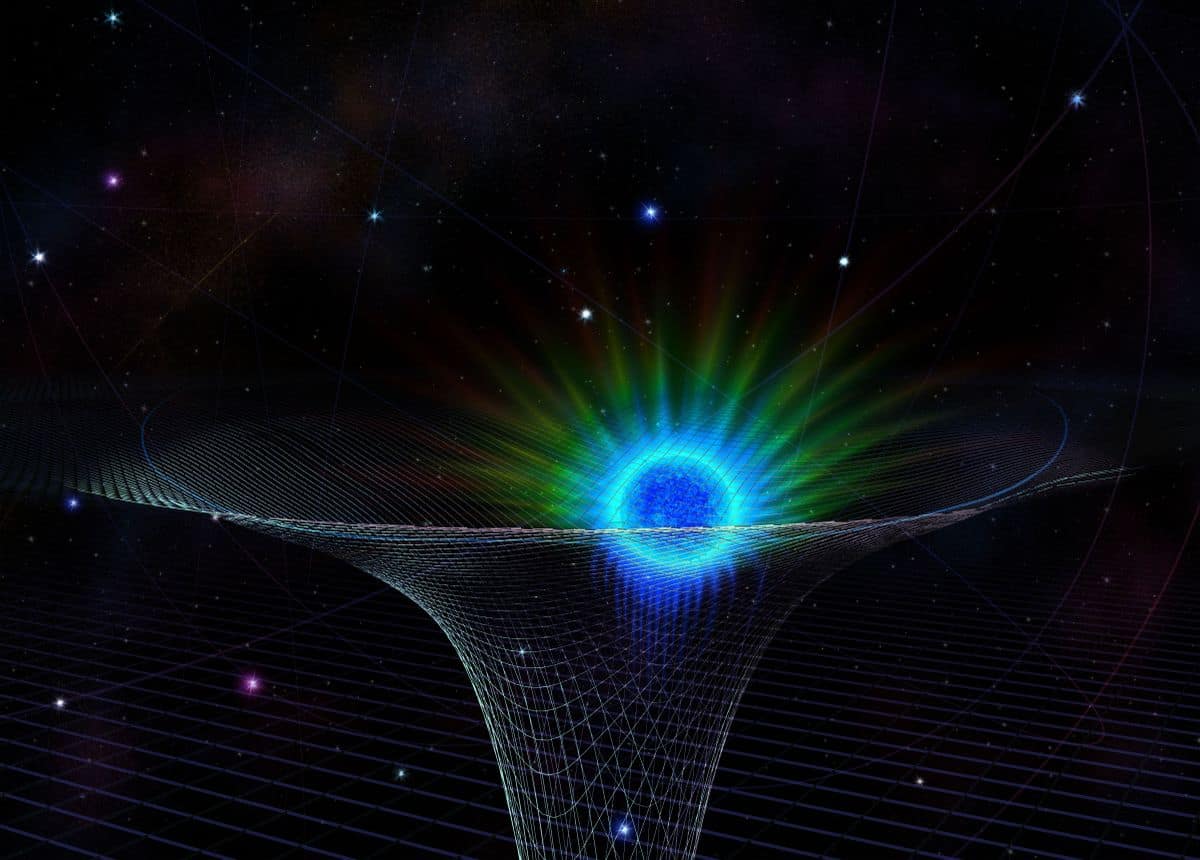
Both are important but they are what help us determine how gravity and time are connected. Gravity itself was technically discovered and analyzed by Isaac Newton. However, he could not figure out how gravity operated instantaneously at a distance. Einstein helped us see gravity as a force that moved matter along the shortest space, all within a curved spacetime. He found that the Sun bends spacetime and tells planets how to move.
Newton could not know time and space were not technically fixed. Einstein could and when he figured it all out with his relativity concepts, he infamously wrote “Newton, forgive me.” This was to signify that he found that Isaac could not, as he ruined Newton’s theory with his own. Einstein’s discoveries led to Quantum Physics we use today. Albert also discovered the Cosmological Constant and Unified Field Theories. Both are also useful when discussing time travel.
NEXT >>

It is very important that you keep in mind that when discussing time travel, often spacetime will come up. The reason for this is that it connects to several different areas of how time itself passes. For example, GPS systems are not connected technically to on-ground sources. They connect to satellites in low orbit. They’re roughly 12,500 miles above the Earth’s surface.
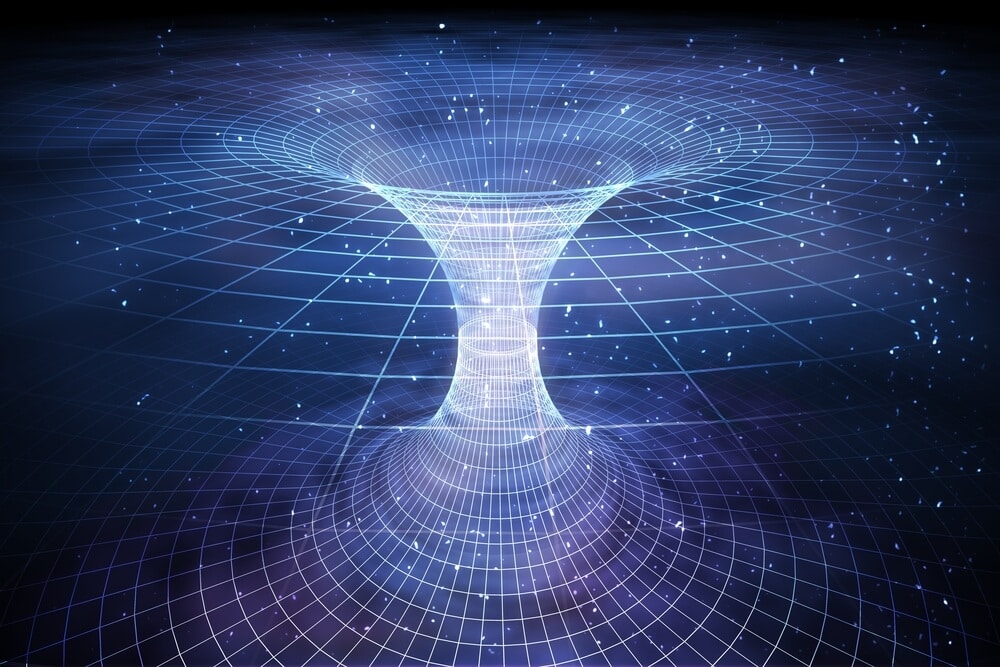
Due to being outside of the Earth and rotating around with it, one would assume that time-wise they are connected to the same time as our own. However, they’re actually off by 1 second per second. Since Albert Einstein was able to accurately find that gravity actually curves space and time, scientists knew how to calculate this time difference.
Since gravity is weaker in low-orbit, time is altered. In this area, they even run faster in time. Yet Spacetime overall is important to keep in mind. Gravity dictates how spacetime operates, in that, the more gravity something has, the slower time will pass.
<< Previous

Gravitational Time Dilation
Gravitational Time Dilation is present to help us make assumptions about how time will pass for us. Meaning, if we did visit a new planet with different forms of gravity to our own, we can make an accurate assumption of how this gravity will impact our species. Einstein came up with this under his Special Relativity concept.
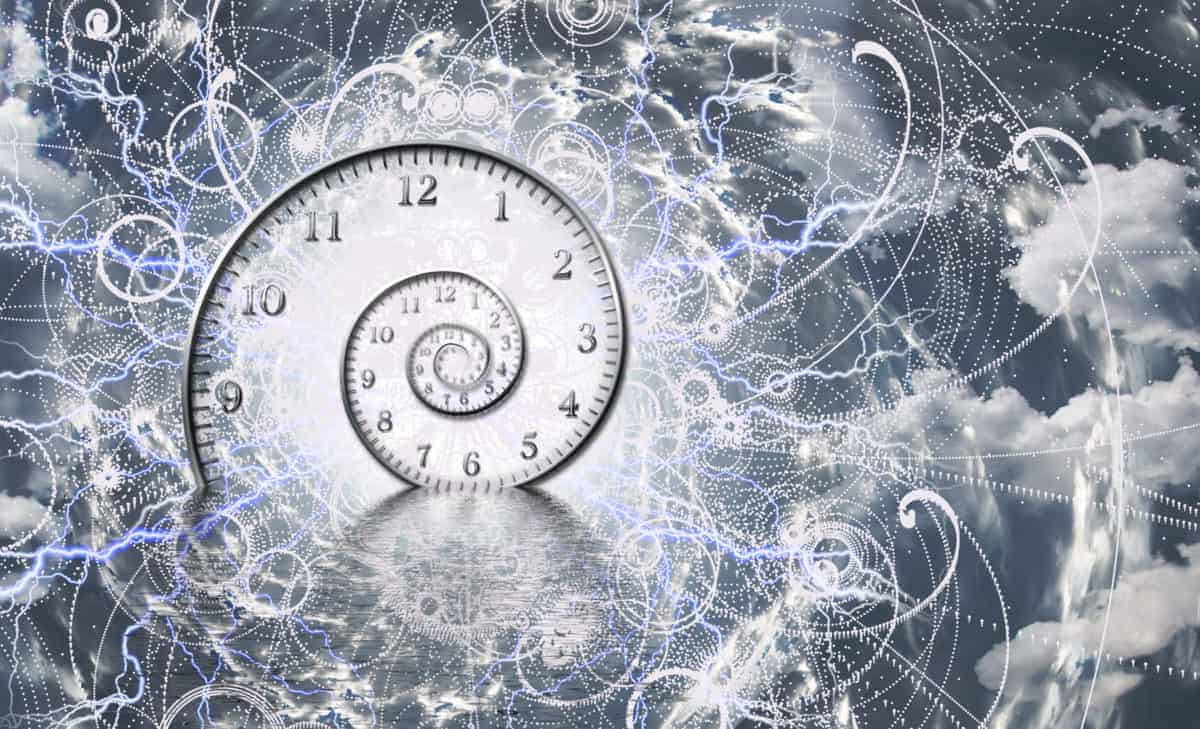
Gravitational Time Dilation is essentially a comparison model where we bring in two things or events and give them different forms of gravity. The time dilation will be how the time is altered between the two. Einstein found that when the potential for gravity lowers, time will pass slower. However, as gravity increases, the faster time will be.
In fact, we were even able to find that the Earth’s core is roughly 2.5 years younger than its surface due to this model. This proved to us that larger effects will require a bigger distance or a larger source of gravity.
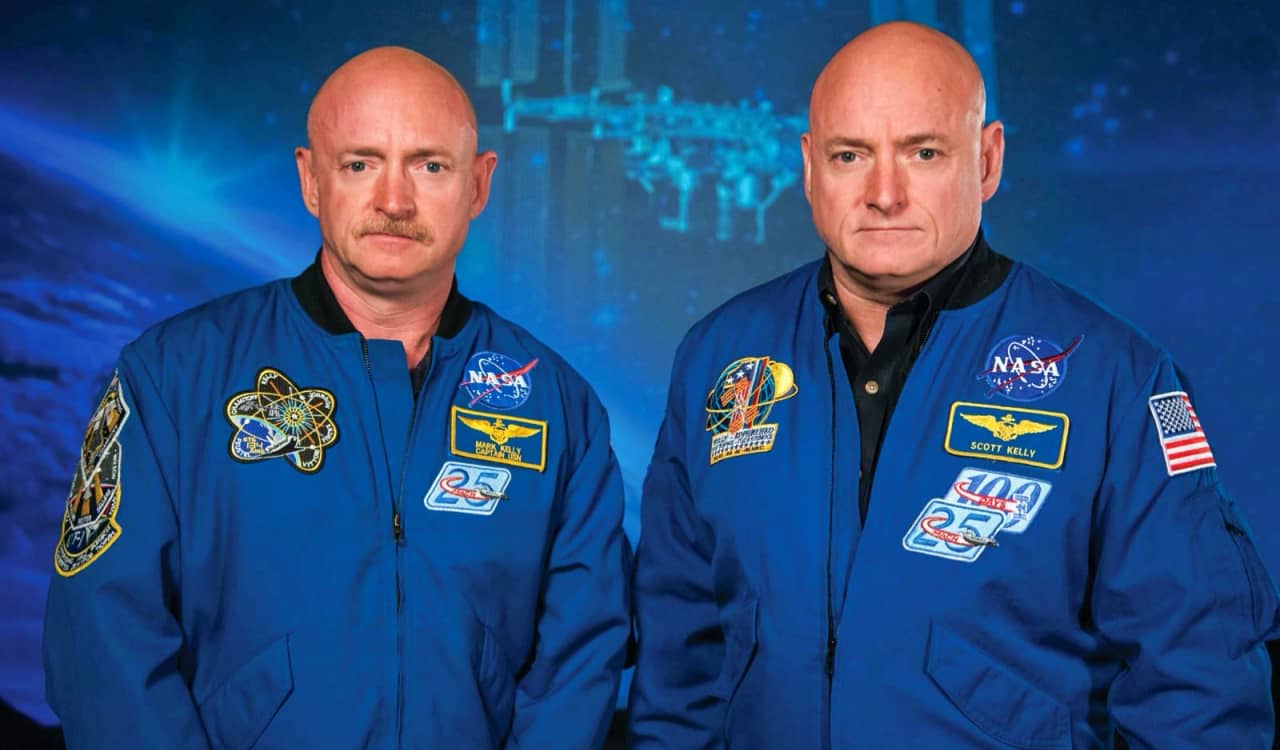
How space & gravity affected humans intrigued NASA, so they wanted to do a comparison experiment with twins. Therefore, they used Mark & Scott Kelly. They were perfect because they were identical and did not have any major differences. In fact, both men were checked for everything known to man and seemed to match up in every major category pre-flight.
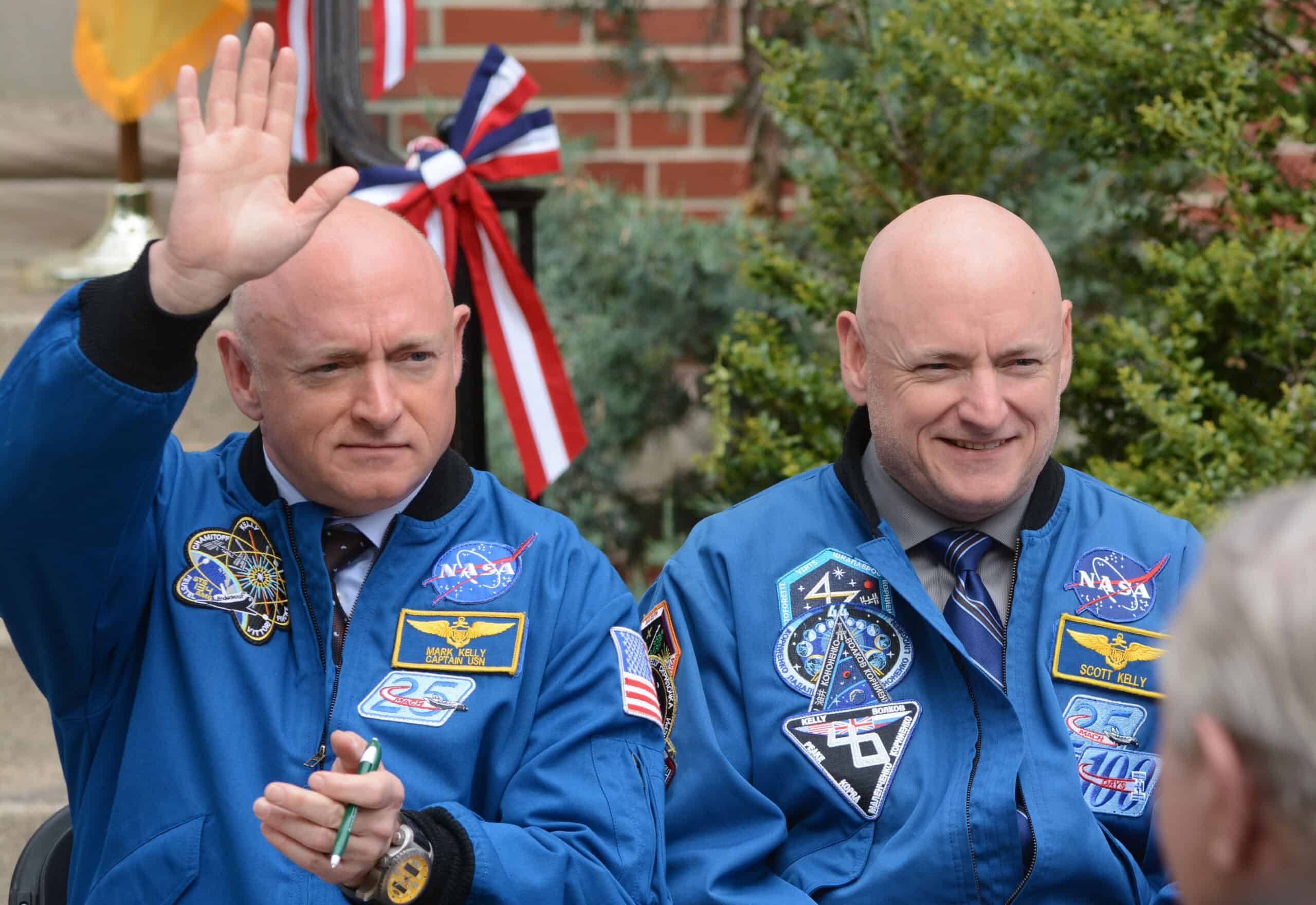
Scott went into space while Mark remained on Earth. The testing NASA wanted to do was immense. They wanted to test how the immune system responded as well as information on epigenetic changes, gut bacteria, body weight, serum metabolites, and much more.
Scott spent a year in space and upon returning, he showed positive numbers that gave scientists a lot of hope when it comes to possible long-term space travel. Some numbers were even considered shocking. However, compared to his brother Mark, Scott was a bit taller, had less facial aging, and much more. If you want to read a full summary of the study, click here .

Speed Of Light & Lightyears
While it might not seem to be hard to comprehend the speed of light is fast, we need you to grasp how fast it actually is. In terms of speed, the number of miles that light travels per second are 182,282. In terms of kilometers per second, that translates to 299,792. Yet in MPH terms, or how we normally judge speed, one could travel 670,616,629 miles in a given hour.

Nothing can quite move this quickly other than the light itself. If we were able to capture the ability to do this in a machine…it could be the secret to long-term space travel and even teleportation. This is also key when understanding how lightyears operate too. When you hear that a planet is roughly 10 lightyears away, this does not mean it takes 10 years to get to.
Rather, it would take 10 Earth Years to get there when moving at “the speed of light.” The fastest a manned vehicle has ever been able to go was done by the Apollo 10 when it moved at 24,791 MPH. At this rate, to get to something 10 light years away, it would take us 270,000 Earth Years!

Airplane Speed & Time Experiment
When something moves faster in terms of speed, the slower one will experience time. If you move fast, you will experience time along with the fast-moving manned craft you’re in. Meaning, you are going to age a bit differently compared to those who are not in the craft with you. Scientists used an airplane to confirm that idea.

An experiment was done using two clocks. One went up in the airplane while the other remained on the Earth’s surface. The fast-moving plane went up in the air and flew around the world in the direction that the Earth rotates. This meant it ideally would be going with the same movement of time that a clock would be going.
Once the plane landed , scientists found the clock on the airplane was a bit behind the ground clock. Yet both clocks were set to exactly the same times before the experiment began. They found that the airplane clock moved roughly 1 second per second slower than the ground clock. This proved the time on the clock was affected by the speed of the plane it was in.

Why This Is Important
While understanding spacetime and gravity might seem useful, it’s likely you want to know what they have to do with time travel. This is a good thing to question but the answer is simple. Both help us how to determine the operation of time and how we travel in it.

Basically, if you do not know how gravity changes time then it’s hard to know how time travel itself actually works. In fact, it is due to this knowledge of time and gravity that time travel is even possible at all for a human being to do in a major form. Yet lightspeed and lightyear knowledge helps when understanding that speed and time are also connected.
This was proven in the Airplane experiment and many others over the years. Due to Einstein and his Theory of Relativity, which includes quite a lot honestly, we know mankind can do a lot more than once assumed. Basically, we said all of this so you’ll understand that time travel has been technically possible for a long time.

Could Time Travel Be Fatal To Humans?
It’s hard to know how time travel might affect humans if we indeed did manage to do it in the science fiction way. We know it would take incredibly high speeds and the problem with something like this is the force it causes. For example, on a cruise ship, you often expect to go to the front of the ship and do what you see in the Titanic film. However, what actually happens is that in spite of the ship going no faster than the average speed limit of your car.

It brings in a ton of force and you can barely walk around, much less have Leonardo DiCaprio hold you with only a small bit of hair movement. This force is minute compared to the speed of light. In fact, you can go to The Space and Rocket Center in Huntsville, Alabama to experience their G-Force machine that spins around at high speeds. It is used to simulate the force astronauts feel during liftoff.
Removing gravity in space would result in a lack of most G-Forces, which is good. However, even if we removed gravity, the speed of light will need acceleration which still causes G-Forces in space. The fact that we’ve never reached it with a manned vehicle proves we need better technology otherwise man could never survive possible major time travel. This would ideally need higher speeds to accomplish.
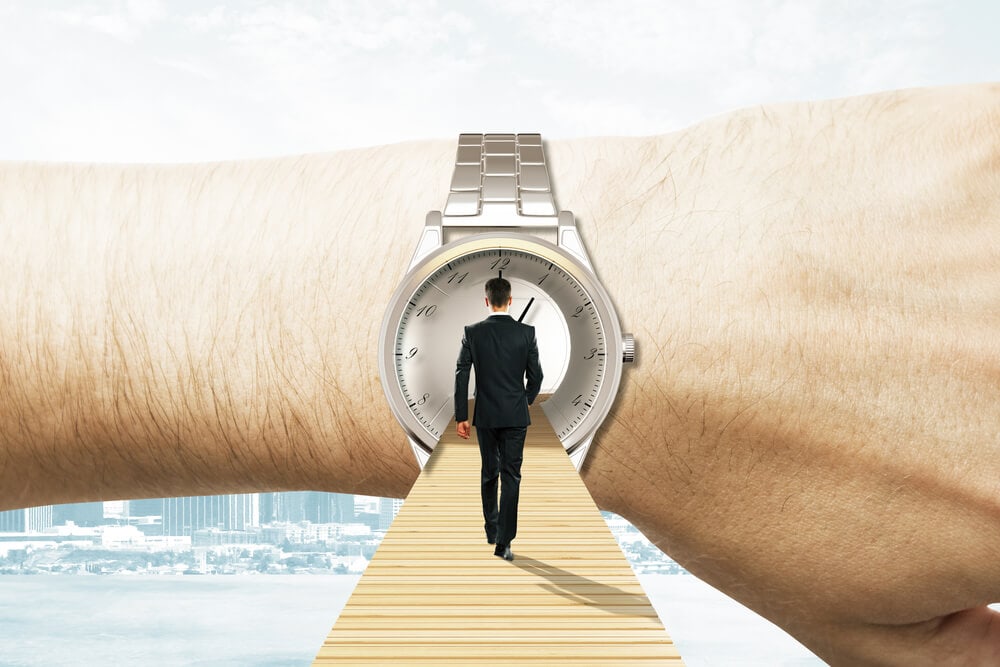
Time Travel Can Only Be Done Into The Future…For Now
A lot of the time when we think of time travel, we speak about how we’d go back in time. However, this is not exactly an easy thing to do. The reason for this is mostly down to the fact that we are unable to physically go back to change what already happened. However, we can shape our futures and therefore travel into the future possibly hundreds to thousands of Earth years.

An Earth Year is nowhere near the same as a year in spacetime nor can it be compared to a year on a distant planet. If one spends what they believe is an Earth Year physically traveling through space and comes back to Earth…we already know timewise things may not add up. However, depending on how far and fast they are traveling…they could very well hop into the future several Earth years ahead. Yet they won’t physically experience the change.
They’ll come back after spending just a year away to see Earth hundreds to thousands of years later. They will not have changed but generations of their family line would have already passed. Yet right now, this concept is only available when using spacetime and cannot be experienced on a planet. You could not gain the speed necessary and you’d need to deal with gravitational laws that spacetime won’t have as much of a problem with, at least outside of G-Forces.

Time Travel In Spacetime Creates A Lot Of Problems
Let’s pretend we’re able to make a manned vehicle that can travel at the speed of light. Testing this would be hard to do but just for the fun of it, let’s say we found a way to do it. Now you’re capable of traveling distances we never thought we could ever reach, all in a short time period. However, here’s the rub of that. The short trip will be your experience but not Earth’s.

Communicating with you might be impossible. At least for Earth, we can send a message in terms of light but if you’re a lightyear away it would take 1 year to get a light-made message. Yet Earth Years in total are not being considered here. Even though you’d make roughly a 2 lightyear roundtrip…you’d only age 2 years in spacetime.
Yet the Earth you return to could be thousands of years older than when you left it. What people forget is that the people on board the space shuttle would not experience Earth Year time but Earth will still age. When you discuss time travel, the only possible way to do it is truly to go into the future like this. Well, it used to be the only way.

Backward Dimension
Scientists recently discovered what appears to be a dimension that is not moving forward but rather, moving backward. We basically mean that in its aging process, it’s only getting younger and not older. This possibly means that their time only will move backward but could never move forward.
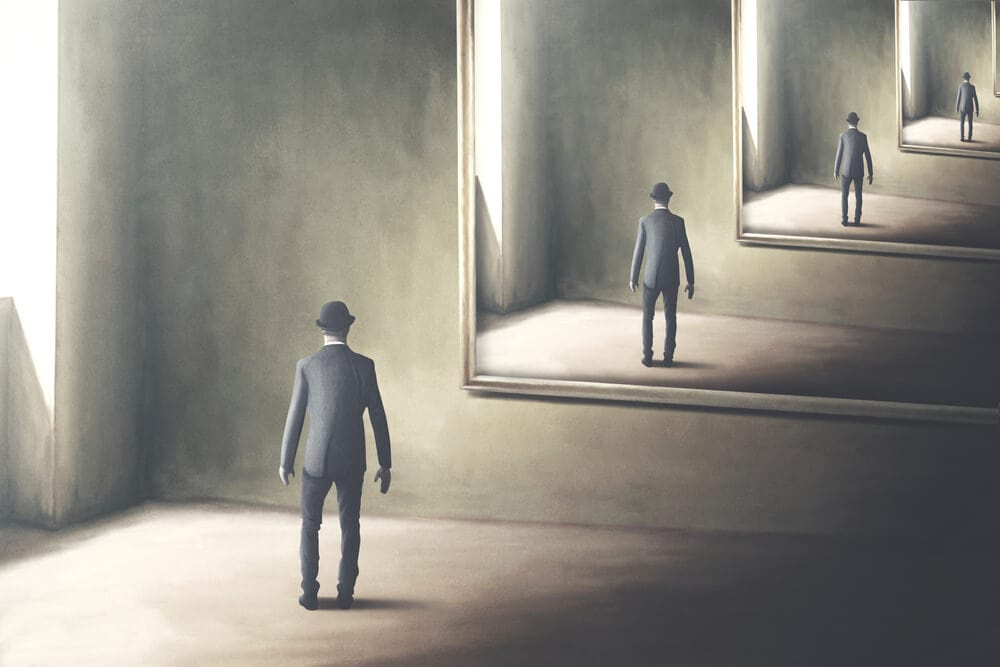
This dimension is a mirrored parallel universe scientists were shocked to discover. This is a pretty essential discovery because a mirror dimension to our own could play a role in time travel. Currently, we can only move forward in time while their universe could only move backward. However, being a mirrored universe, everything means the opposite.
Therefore, it is a universe where the left is right & up is down. On top of this, you have to look at the implications of such a place. If it is completely mirrored, that also means the people are mirror images. However, if everything is backward to us, does that mean the people and their lives are also backward? Does everyone have Benjamin Button syndrome here? Is everything in true reverse? Honestly, we don’t know….but doesn’t that make it all the more intriguing?

What This Means
What does this mean to us when discussing time travel? It means that if a mirrored universe exists and we can access it, we could follow their laws when it comes to physics. If they can only move backward and we can only move forward, there is a good chance that accessing it would allow us to go backward in time.
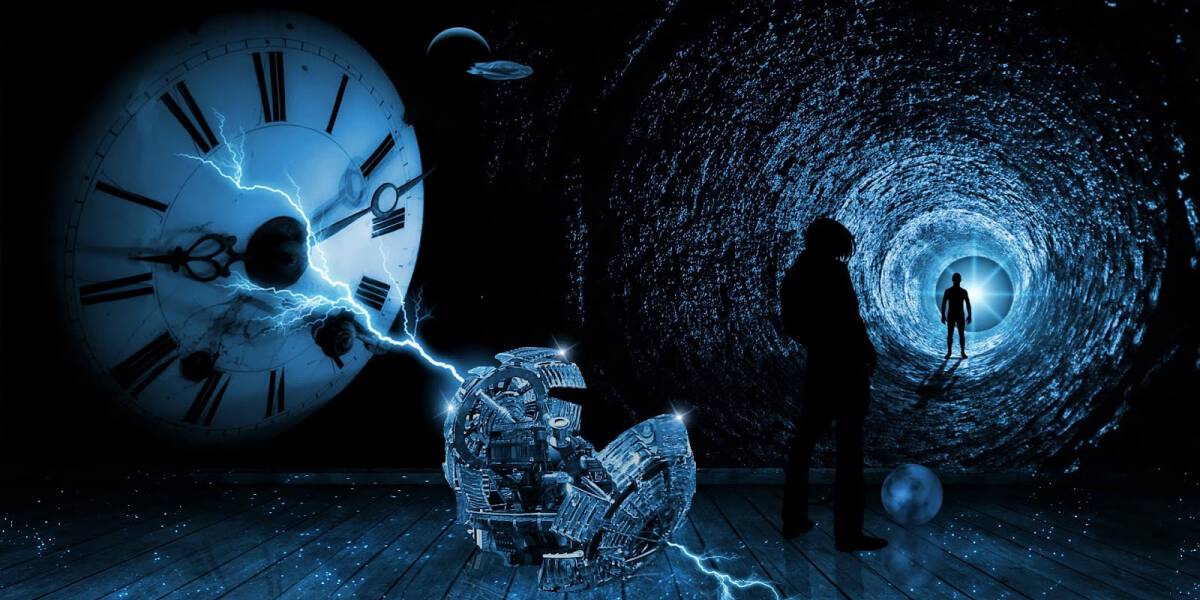
How can this be done? That’s the complicated part. There have been some who feel wormholes could be the best possible avenue, especially if we could create our own version that could be controlled. If this ever did happen, then connecting to a mirrored universe could be possible. However, this is the stuff of science fiction and not science fact as of yet. Theoretically though, if we could access this universe then we could possibly travel back in time.
As we could enter this wormhole and then exit into space. This allows us to remove any possible gravitational issues. If we can control the wormhole, then we could open it to pop back into our own universe at the exact time we wish to go back to. Since our mirrored universe goes only backward, we’d follow their laws of physics to the letter this way. Yet if we did this, there’s a lot to consider.

Cosmic Strings
Sometimes, you do not need to consider traveling through space or even focus on lightyears and speed. Perhaps, all you need to consider for time travel to be possible is Cosmic Strings . It is believed that these strings are tubes of energy that stretch across the entire length of our expanding universe.

This connects a lot of major concepts but time travel seems to be the most prominent here. Cosmic String fans believe this is possibly the best thing for time travel to be possible because these strings are leftover from the early cosmos. Since they likely contain huge amounts of mass, they could technically warp or fold spacetime around them.
It is assumed that Cosmic Strings are either infinite or they’re in never-ending loops. If two strings came close to one another, essentially parallel to the other, they’d bend spacetime so much and in such a particular way that time travel could be possible using them. Of course, this is just a theory for now as are a lot of String Theory concepts.

Timeline Theories
There are two sets of timeline theories to consider. The first is the one every science fiction movie and book seems to be based on. If you go back in time and do something, it could directly impact the time you go back to. Yet in other theories, this is not the case. Some believe that your past is constant, meaning it will never change.
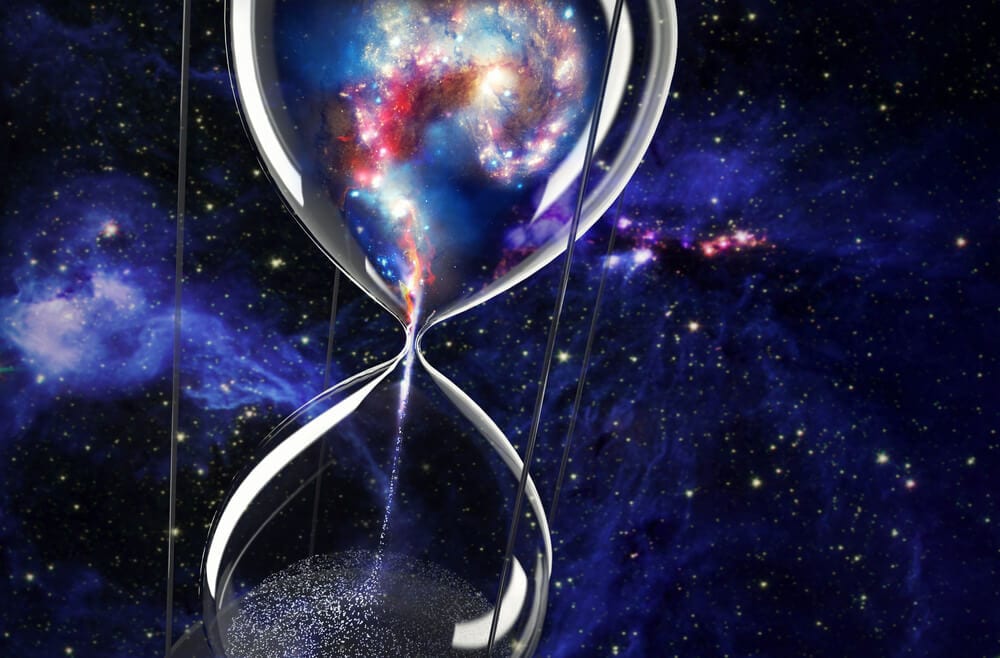
Let’s pretend you went back in time and killed Baby Hitler like you might hear people mention. If you did this, some believe it will result in the future never having heard of Adolph Hitler. Yet in this “past is constant” theory, you will go back to your own time and never see a change. Hitler always existed. This is due to the fact that you have not affected your own timeline but rather, invented a new timeline that will create essentially its own new universe.
Others believe that your timeline will still always exist but you might go back to your own time to experience the change because you were absorbed into this new universe you basically created by killing Baby Hitler. Let’s explore this a bit more through effects and paradoxes.

The Butterfly Effect
No, we’re not going to be discussing the Ashton Kutcher movie of the same name. However, they were pretty spot on with what this theory suggests. The Butterfly Effect is part of what is known as “chaos theory.” This theory is made up of a branch of math focusing on dynamic systems where random states of disorder and/or irregularities are often governed by deterministic laws that are sensitive to initial conditions. Basically, there are underlying patterns in randomness.
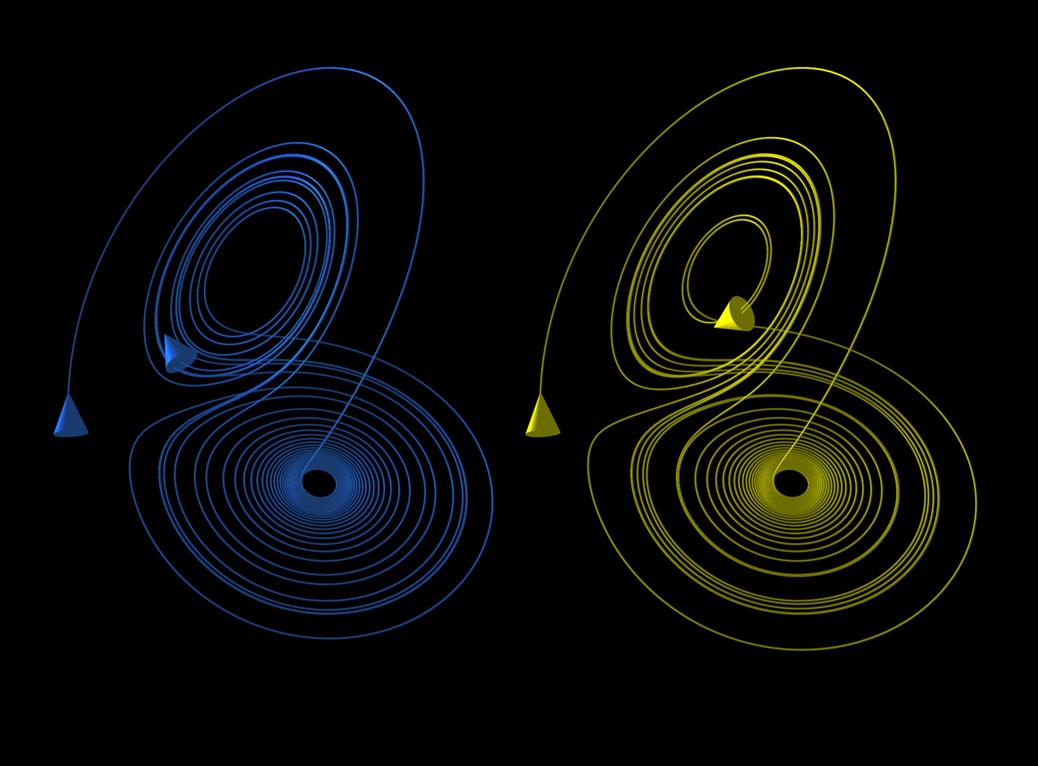
The Butterfly Effect comes originally from the work of Edward Lorenz. He came up with this concept revolving around tornado and how it is influenced by minor things. In this case, the flapping of the wings of a distant butterfly and how it could have caused the tornado weeks later. Lorenz based this concept on following weather models and how weather itself can be altered over minor changes in the environment.
This was already something that French Mathematician Henri Poincaré and American Mathematician & Philosopher Norbert Wiener. Lorenz’s theory was then used in the area of time travel by pointing to how little changes in the past could cause bigger changes down the line. Of course, this would be big to keep in mind if we indeed did affect our own universe when going back in time. As we could cause bigger problems than the type we might have stopped.

Grandfather Paradox
This is the one that has quickly become the most debated in time travel paradoxes. Called the Grandfather Paradox , one person might feel that they want to die. Perhaps they don’t though but they feel that their family was part of a lot of bad things throughout history.

They are willing to selflessly go back in time and kill their grandfather or great(x times you need) grandfather, all to ensure their family does not exist. This will sadly cause them to not exist either but by doing this, they run into a paradox. If they kill their grandfather, then technically they prevent themselves from ever existing.
Therefore, they could not have gone back in time to kill their grandfather. Basically, it means that it would be like they never went back in time at all. Now, another person could kill their grandfather as long as there was no family relation. However, they simply could not. Keep in mind that this paradox is not exclusive to grandparents but several changes one might make in the past when time traveling.


Let’s Kill Hitler Paradox
A lot like the Grandfather Paradox, the Let’s Kill Hitler Paradox works pretty much the same way. However, are some differences here too, especially when looking at the timeline theories. In this instance, a person perhaps is tired of living and wants to go back in time to kill themselves.

Apparently, they don’t have the nerve to kill themselves but could easily kill a baby that happens to be them from the past. It could be any younger version of them, however. This does not need to be a baby, technically. In any case, they go back in time but seem to fail every time they try to kill their past self. Why?
They cannot kill themselves, because they would not be alive to have done so. Yet they could cause possible damage, such as markings that they will experience. However, you too will experience them. Let’s say you shoot at your younger self but miss and shoot their arm. You could look at yourself and see a mark left by the bullet in your arm, as you were shot while you were younger by some strange man who looked a lot like you.

Bootstrap Paradox
The Bootstrap Paradox is thought to be the most respected theory in the connected timeline. Why? It follows all the rules of the constant past concept without breaking those laws. Basically, in this paradox, you experienced something in the past that was always going to happen. It is part of a casual loop.

In this format, one event causes the second event. Yet it was the second event that was actually the cause of the first. A great example of this can be seen in DC Comics’ The Flash character. Reverse Flash goes back in time to kill young Barry Allen but fails, then the Reverse Flash decides to instead kill Barry’s mother.
Barry got himself out of the home but could not save his mother. By going back in time to save his mother, he’d never become The Flash. Therefore, he has to let his mother die to become the hero the world needs. If she never does, he does not become a forensic specialist for the CCPD the night of a Particle Accelerator Explosion, which gave him his powers. Yet if he’s never The Flash, he cannot run back in time to stop himself from being killed either. Which creates a loop of needed actions.

Multiverse Theory
It’s interesting that we bring up The Flash in this scenario of time travel. He actually does go back in time to stop Reverse Flash from killing his mother in the Flashpoint Paradox story-arc. This is a key part of DC Comics that causes a few rifts in the multi-universe itself and ends up causing a Crisis Event.

In any case, when Flash does this he technically creates a new timeline and universe where his mother exists yet he is not The Flash. A lot of things are the same but many things are not. Bruce Wayne is killed instead of his parents, causing his father Thomas to become Batman while his mother actually becomes this universe’s Joker.
Superman does not land in a field but rather, in the center of the Metropolis. Wonder Woman and Aquaman have an affair leading to the death of Mera, the Queen of Atlantis. Thus causing a war that will wipe out the planet. This must be changed, so Flash finds a way to recreate the conditions that gave him powers, nearly killing himself to do so. All to go back in time. Yet this does not stop changes from happening because it still causes a rift where a third universe or timeline comes about.

Likely Parallel Universe Concept
If we did go back in time, it is most likely that we would end up being connected to the laws of the second timeline theory we proposed. This is the timeline where the past is constant and cannot technically be changed. When it does change, it would then create another universe branched off on its own.

Basically, if we kill Baby Hitler then we will not see the result of this in the timeline we return to. Hitler always existed in our timeline and always will. However, the interesting notion is to consider how we could end up remaining in this Hitlerless universe. One would conclude the only way to do this is to remain in the timeline we’ve gone back to.
Therefore, the changes you make would branch off a different timeline and you’d remain in it. However, you might not have to remain behind. It is interesting to note that if we did use the mirrored parallel universe to go back in time, to begin with, we’d likely be able to visit this new universe we created eventually. If we can access one universe, what stops us from accessing another? We just shouldn’t assume our time travel changes will affect our present timeline.

EDITOR PICKS

Is Time Travel Possible?
- Cosmology & Astrophysics
- Physics Laws, Concepts, and Principles
- Quantum Physics
- Important Physicists
- Thermodynamics
- Weather & Climate
:max_bytes(150000):strip_icc():format(webp)/AZJFaceShot-56a72b155f9b58b7d0e783fa.jpg)
- M.S., Mathematics Education, Indiana University
- B.A., Physics, Wabash College
Stories regarding travel into the past and the future have long captured our imagination, but the question of whether time travel is possible is a thorny one that gets right to the heart of understanding what physicists mean when they use the word "time."
Modern physics teaches us that time is one of the most mysterious aspects of our universe, though it may at first seem straightforward. Einstein revolutionized our understanding of the concept, but even with this revised understanding, some scientists still ponder the question of whether or not time actually exists or whether it is a mere "stubbornly persistent illusion" (as Einstein once called it). Whatever time is, though, physicists (and fiction writers) have found some interesting ways to manipulate it to consider traversing it in unorthodox ways.
Time and Relativity
Though referenced in H.G. Wells' The Time Machine (1895), the actual science of time travel didn't come into being until well into the twentieth century, as a side-effect of Albert Einstein 's theory of general relativity (developed in 1915). Relativity describes the physical fabric of the universe in terms of a 4-dimensional spacetime, which includes three spatial dimensions (up/down, left/right, and front/back) along with one time dimension. Under this theory, which has been proven by numerous experiments over the last century, gravity is a result of the bending of this spacetime in response to the presence of matter. In other words, given a certain configuration of matter, the actual spacetime fabric of the universe can be altered in significant ways.
One of the amazing consequences of relativity is that movement can result in a difference in the way time passes, a process known as time dilation . This is most dramatically manifested in the classic Twin Paradox . In this method of "time travel," you can move into the future faster than normal, but there's not really any way back. (There's a slight exception, but more on that later in the article.)
Early Time Travel
In 1937, Scottish physicist W. J. van Stockum first applied general relativity in a way that opened the door for time travel. By applying the equation of general relativity to a situation with an infinitely long, extremely dense rotating cylinder (kind of like an endless barbershop pole). The rotation of such a massive object actually creates a phenomenon known as "frame dragging," which is that it actually drags spacetime along with it. Van Stockum found that in this situation, you could create a path in 4-dimensional spacetime which began and ended at the same point - something called a closed timelike curve - which is the physical result that allows time travel. You can set off in a space ship and travel a path which brings you back to the exact same moment you started out at.
Though an intriguing result, this was a fairly contrived situation, so there wasn't really much concern about it taking place. A new interpretation was about to come along, however, which was much more controversial.
In 1949, the mathematician Kurt Godel - a friend of Einstein's and a colleague at Princeton University's Institute for Advanced Study - decided to tackle a situation where the whole universe is rotating. In Godel's solutions, time travel was actually allowed by the equations if the universe were rotating. A rotating universe could itself function as a time machine.
Now, if the universe were rotating, there would be ways to detect it (light beams would bend, for example, if the whole universe were rotating), and so far the evidence is overwhelmingly strong that there is no sort of universal rotation. So again, time travel is ruled out by this particular set of results. But the fact is that things in the universe do rotate, and that again opens up the possibility.
Time Travel and Black Holes
In 1963, New Zealand mathematician Roy Kerr used the field equations to analyze a rotating black hole , called a Kerr black hole, and found that the results allowed a path through a wormhole in the black hole, missing the singularity at the center, and make it out the other end. This scenario also allows for closed timelike curves, as theoretical physicist Kip Thorne realized years later.
In the early 1980s, while Carl Sagan worked on his 1985 novel Contact , he approached Kip Thorne with a question about the physics of time travel, which inspired Thorne to examine the concept of using a black hole as a means of time travel. Together with the physicist Sung-Won Kim, Thorne realized that you could (in theory) have a black hole with a wormhole connecting it to another point in space held open by some form of negative energy.
But just because you have a wormhole doesn't mean that you have a time machine. Now, let's assume that you could move one end of the wormhole (the "movable end). You place the movable end on a spaceship, shooting it off into space at nearly the speed of light . Time dilation kicks in, and the time experienced by the movable end is much less than the time experienced by the fixed end. Let's assume that you move the movable end 5,000 years into the future of the Earth, but the movable end only "ages" 5 years. So you leave in 2010 AD, say, and arrive in 7010 AD.
However, if you travel through the movable end, you will actually pop out of the fixed end in 2015 AD (since 5 years have passed back on Earth). What? How does this work?
Well, the fact is that the two ends of the wormhole are connected. No matter how far apart they are, in spacetime, they're still basically "near" each other. Since the movable end is only five years older than when it left, going through it will send you back to the related point on the fixed wormhole. And if someone from 2015 AD Earth steps through the fixed wormhole, they'd come out in 7010 AD from the movable wormhole. (If someone stepped through the wormhole in 2012 AD, they'd end up on the spaceship somewhere in the middle of the trip and so on.)
Though this is the most physically reasonable description of a time machine, there are still problems. No one knows if wormholes or negative energy exist, nor how to put them together in this way if they do exist. But it is (in theory) possible.
- What Is the Twin Paradox? Real Time Travel
- Time Travel: Dream or Possible Reality?
- Can We Travel Through Time to the Past?
- Einstein's Theory of Relativity
- Is Warp Drive From 'Star Trek' Possible?
- Closed Timelike Curve
- Understanding Time Dilation Effects in Physics
- An Introduction to Black Holes
- Wormholes: What Are They and Can We Use Them?
- Understanding Cosmology and Its Impact
- The History of Gravity
- Black Holes and Hawking Radiation
- Leonard Susskind Bio
- Amazing Astronomy Facts
- Learn How to Rotate Graphics in SVG
- To the Right, To the Right (The Coriolis Effect)
- The Inventory
All the Evidence that Time Travel is Happening All Around Us
This iconic footage of a person apparently talking on a cellphone in a Charlie Chaplin film is just one clue that time travel is happening all around us. People have seen the past, and the future — and there are tons of telltale photographs and films. Here are the clearest signs of real-life time travel.
Related Content
The mouberly-jourdain incident (or the ghosts of petit trianon) in the gardens of the petit trianon, a small château located on the grounds of the palace of versailles, france, august 10, 1901.
Two female academics, Eleanor Jourdain and Charlotte Anne Moberly allegedly experienced here a time slip, and saw Marie Antoinette, the Comte de Vaudreuil and some other people in the time of the French Revolution.
(via Myrabella and Wikimedia Commons )
An old woman using mobile phone in a short clip from the DVD extras of Charlie Chaplin's film The Circus, 1928, spotted only in 2010 by filmmaker George Clark
It could be a Siemens hearing instrument, patented in 1924 or a Western Electric Model 34A Audiphone Carbon Hearing Aid (pictured below).
And the same explanation for this video from 1938, showing a crowd exiting a factory in Massachusetts, 1938:
(via Hearing Aid Museum )
The time slip of Air Marshal Sir Robert Victor Goddard over the former Royal Air Force station Drem Airfield in 1935
"In 1935, while still a Wing Commander, he was sent to inspect a disused airfield near Edinburgh at a place called Drem. He found it in a very dilapidated state with cattle grazing on grass that had forced through cracks in the tarmac. Later that day, he ran into trouble while flying his biplane in heavy rain and decided to fly back to Drem to get his bearings. As he approached the airfield the torrential rain abruptly changed to bright sunlight. When he looked down he saw the airfield had been completely renovated and was now in use. There were mechanics in blue overalls walking around and four yellow planes parked on the runway. One of these was a model which, for all his aviation experience, he completely failed to recognize." – according to Time Travel: A New Perspective, by J. H. Brennan
Four years later, RAF began to paint their planes yellow and the mechanics uniforms were switched to blue.
(via Planes and Choppers and Scotlands Places )
The man often called Time Traveling Hipster from the reopening ceremony of South Forks Bridge in Gold Bridge, British Columbia, Canada, 1941
That type of sunglasses with leather side shields were used since the 1920s and he's wearing the sweater of a hockey team instead of a modern T-shirt, but it's still a cool photo!
(via Forgetomori )
The Philadelphia Experiment, 1943
There were no such experiments, of course, but some reports stated that U.S. Navy destroyer escort USS Eldrige travelled back in time for about 10 seconds on October 28, 1943.
(via Wikimedia Commons )
Henry Fonda and Shirley Temple checking their stagecoach route on an iPhone in the movie Fort Apache (1948)
We promise that they used Google Maps instead of Apple's Maps app.
The Fentz legend, 1950s
This urban legend is about a man in his early thirties named Rudolph Fentz, who was hit by a taxi and fatally injured at New York City's Time Square in mid-June 1950, dressed in the fashion of the late 1800s. In his pockets there were a copper token for a beer, a bill for the care of a horse and the washing of a carriage, a letter from 1876, 70 dollars and business cards, all without any signs of aging. A NYPD policeman found a person who was disappeared in 1876 in the age of 29.
The story originated in a 1951 sci-fi short story by Jack Finney, but the legend has been reported since the 1970s as an evidence for the existence of time travel.
(via Transpress NZ )
The Mountauk Project conspiration theory
The Montauk Air Force Station reportedly has a real time tunnel in its subterranean laboratory that allowed scientists to travel back to 1943. This story started with two men, the author Preston B. Nichols and Al Bielek in the 1980s, when they had begun to "recover repressed memories of working in the lab".
Time-traveler busted for insider trading, March 2003
The story originated with the Weekly World News, but appeared in some newspapers after Yahoo reprinted it two weeks later:
[…]"The fact is, with an initial investment of only $800, in two weeks' time he had a portfolio valued at over $350 million. Every trade he made capitalized on unexpected business developments, which simply can't be pure luck."
"The only way he could pull it off is with illegal inside information. He's going to sit in a jail cell on Rikers Island until he agrees to give up his sources." The past year of nose-diving stock prices has left most investors crying in their beer. So when Carlssin made a flurry of 126 high-risk trades and came out the winner every time, it raised the eyebrows of Wall Street watchdogs. […] Carlssin declared that he had traveled back in time from over 200 years in the future, when it is common knowledge that our era experienced one of the worst stock plunges in history. Yet anyone armed with knowledge of the handful of stocks destined to go through the roof could make a fortune. "It was just too tempting to resist," Carlssin allegedly said in his videotaped confession. "I had planned to make it look natural, you know, lose a little here and there so it doesn't look too perfect. But I just got caught in the moment." […] – according to a Yahoo Entertainment article, found in the Internet Archive here.
(via Engelcast and Snopes )
The story of John Titor
A man, appeared on some online bulletin boards in 2000 and 2001, and claiming to be a time traveler from 2036. He made numerous predictions about events after 2004 and often described his time machine .
None of those events have happened yet.
(via Stranger Dimensions )
The story of Håkan Nordkvist, who just met with an older version of himself, 2006
Nordkvist slipped through a wormhole in his kitchen and met an older man who had the same tattoo as Håkan. He just knew that no one's going to believe this — so he filmed the encounter.
As everyone later discovered, this was just part of an advertising campaign of the Swedish insurance company AMF, made by Forsman & Bodenfors.
(via Forsman&Bodenfors )
Paradox-Free Time Travel Proven Possible by Physics Student
I think this kid just earned himself an a+..
The Best Sci Fi Movies on Netflix

"In the coronavirus patient zero example, you might try and stop patient zero from becoming infected, but in doing so you would catch the virus and become patient zero, or someone else would. No matter what you did, the salient events would just recalibrate around you. Try as you might to create a paradox, the events will always adjust themselves, to avoid any inconsistency."
In This Article

IGN Recommends

Advertisement
Mathematics
The mathematician who worked out how to time travel.
Mathematics suggested that time travel is physically possible – and Kurt Gödel proved it. Mathematician Karl Sigmund explains how the polymath did it
By Karl Sigmund
5 April 2024

Gödel proved that, mathematically speaking, time travel is physically possible
Quality Stock / Alamy
The following is an extract from our Lost in Space-Time newsletter. Each month, we hand over the keyboard to a physicist or mathematician to tell you about fascinating ideas from their corner of the universe. You can sign up for Lost in Space-Time for free here .
There may be no better way to get truly lost in space-time than to travel to the past and fiddle around with causality. Polymath Kurt Gödel suggested that you could, for instance, land…
Sign up to our weekly newsletter
Receive a weekly dose of discovery in your inbox! We'll also keep you up to date with New Scientist events and special offers.
To continue reading, subscribe today with our introductory offers
No commitment, cancel anytime*
Offer ends 2nd of July 2024.
*Cancel anytime within 14 days of payment to receive a refund on unserved issues.
Inclusive of applicable taxes (VAT)
Existing subscribers
More from New Scientist
Explore the latest news, articles and features
Mathematician wins Turing award for harnessing randomness
Most accurate clock ever can tick for 40 billion years without error.
Subscriber-only
Single mathematical model governs primate brain shape across species
How one theory ties together everything we know about the universe, popular articles.
Trending New Scientist articles
- Celebrities
- Science & Tech
- Fashion & Beauty
- Food & Drink
- Home & Garden
- Sports & Fitness
- Travel & Outdoors
- Science & tech
- Conversations
Scientists have actually discovered how to time travel
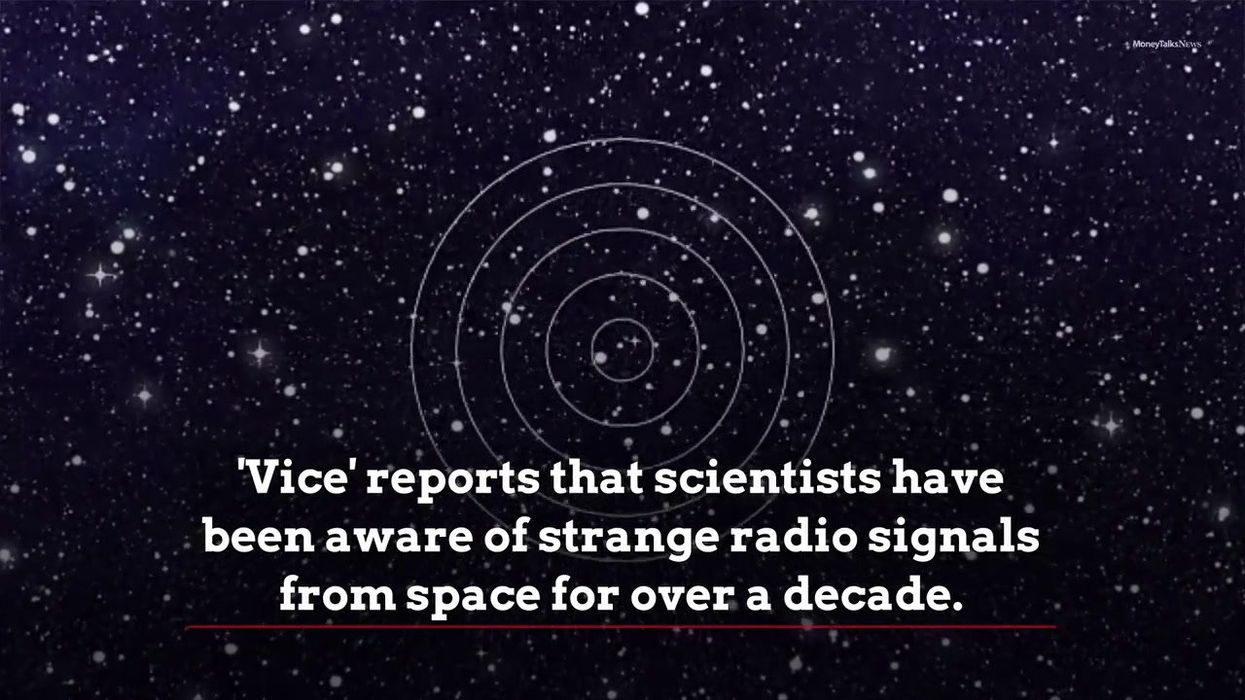
Ready to be a little bit confused by complex science? Ok, here we go…
Until now, time travel has only been possible in fiction (and on TikTok, according to some ), but it might not be as far away as previously thought.
Scientists delving into subatomic structures and quantum physics have claimed that the concept of time travel might actually be possible.
The concept of humans hopping back and forth through time is still exactly that – a concept.
However, scientists from the Austrian Academy of Sciences (ÖAW) and University of Vienna believe they’ve proven it’s achievable in the world of quantum physics.
Sign up for our free Indy100 weekly newsletter
In fact, in a series of papers over recent years, Miguel Navascués of ÖAW and Philip Walther of University of Vienna have been entertaining the idea of speeding up and reversing the flow of time at a subatomic level.
Speaking to the Spanish-language publication El País , Navascués attempted to explain the phenomenon by comparing it to watching a film.
“In a theater [classical physics], a movie is projected from beginning to end, regardless of what the audience wants,” he said. “But at home [the quantum world], we have a remote control to manipulate the movie. We can rewind to a previous scene or skip several scenes ahead.”
How do they do it? With a device called a “quantum switch”, which sounds more like something out of a Marvel movie than something in real life.
They use the device to ‘evolve’ a photon as it passes through a crystal. That way, the photon returns to its previous state before it completes the journey. The idea is to alter the states of quantum particles, which the scientists call “time translation”.
Humans going back and forth in time for now remains impossible, though, namely because human bodies contain so much information that it would take millions of years to process it all and make it work.
As you’d expect, the whole thing is incredibly complicated to track and observe even at a subatomic level. Just watching a system causes it to change. Once it changes, its progress through time can’t be recorded.
Explaining their method for going forward in evolutionary time, Navascués explained: “To make a system age 10 years in one year, you must get the other nine years from somewhere. In a year-long experiment with 10 systems, you can steal one year from each of the first nine systems and give them all to the tenth. At the end of the year, the tenth system will have aged 10 years; the other nine will remain the same as when the experiment began.”
Have your say in our news democracy. Click the upvote icon at the top of the page to help raise this article through the indy100 rankings.
Jake Paul finally makes key admission about Mike Tyson fight
Gta 6 - live updates as jason actor rumors emerge, sushi restaurant customers shocked after receiving bill, giant lake suddenly reappears 130 years after vanishing, surprising details undercovered in conjoined twin abby hensel's wedding documents, larry david’s 20 funniest ever curb your enthusiasm quotes, usain bolt's ancient running record destroyed by high-schooler, the rock turns on joe biden and refuses to endorse him for president, what is a 'honey trap', plants 'scream' while they're being harvested, internet finds husband who ghosted wife and kids in less than 24 hours, 'disgusting' diddy nickelodeon cameo resurfaces following house raid, the moon 'turned itself inside out' – and scientists now know how, all of the celebrities who have made claims about diddy.
10 Most Compelling Pieces Of Evidence That Prove Time Travel Exists
What we don't talk about when we talk about time travel.
What we talk about when we talk about time travel: going back to kill Hitler, Back To The Future, treading on butterflies causing irreparable damage to history, Doctor Who, whether or not it's ethical to use it to cheat on the lottery, and Bill & Ted's Excellent Adventure.
What we don't talk about when we talk about time travel: whether it actually exists. Or will exist. Or has existed. We don't know, this wibbly wobbly, timey wimey stuff kinda messes with our tenses a little.
The idea of being able to travel backwards or forwards through history has appeared in countless forms through pop culture, conversation, and daydreams for ages, but how come we don't discuss whether it'll actually ever be real? Does it just seem too beyond feasibility?
Well, we're here with good news! Not from the future, sadly, just in the grimly predictable present. A grimly predictable present that includes quantum physics, Higgs Bosons and other science-y things we don't quite understand but apparently have something to do with a conceivable way for us to travel through time. No less a genius than Stephen Hawking spent years looking for a reason that time travel couldn't exist, only to find the concept didn't contravene any laws of physics, eventually admitting "time travel may be possible, but it is not practical".
Plus, there's the fact that the history of time travel in our culture has frequently strayed into the non-fiction - so long as you're inclined to believe the possible crackpots that are discussing it - all of which adds up to some pretty compelling pieces of evidence that prove time travel is real.
Ten, in fact.
Tom Baker is the Comics Editor at WhatCulture! He's heard all the Doctor Who jokes, but not many about Randall and Hopkirk. He also blogs at http://communibearsilostate.wordpress.com/

FinanceBuzz
14 Proven Ways to Make Your Weekend Costco Trip Less Painful
Posted: October 3, 2023 | Last updated: October 3, 2023

Costco can be a great place to get deals, but the weekends are usually extra packed with shoppers like you who don’t have time during the week to get what they need.
One of the best Costco tips is to avoid shopping on a weekend. After all, time is money. But if you can’t find another time to go, here are a few ways to get through your trip unscathed.
7 genius hacks all Costco shoppers should know

Go at the least crowded times
You’ll inevitably run into weekend crowds at Costco, but some times are less busy than others.
Savvy shoppers know to get there first thing in the morning to beat the crowds that come later in the day. You can also consider going closer to closing time after most people have done their shopping.
Just make sure you give yourself enough time to shop and check out before Costco closes down.
Get expert advice on making more money - sent straight to your inbox.

Organize your shopping list
It’s a good idea to go into Costco with a shopping list to make sure you get everything you need or grab special deals.
Organize your list by grouping items together based on where they are located in the store. For example, put all your frozen items or vitamins and personal care items together.
This can help you get your shopping done quickly without having to go back for items later.

Add a lunch break
Costco has a great food court, so add it to your shopping experience to get more done with one trip. For instance, you can stop by after shopping for a hot dog and a drink for $1.50.
Pro tip: A great Costco trick is to order a pizza at the food court before you start shopping so it’s hot and waiting for you by the time you check out.
6 Genius Hacks All Costco Shoppers Should Know

Bring snacks
Costco is well known for its samples, but they can go quickly if you’re trying to grab a bite on the weekend.
Make sure you pack your own trail mix or toss some fruit snacks in your pocket before you go. Otherwise, you’ll be tempted to wait around for a fresh batch of samples and waste more time.

Pack some patience
There’s no doubt that Costco is going to be tough to navigate on the weekends, so pack some patience.
Be aware of carts around you as you make your way through the aisles and try not to get too frustrated by customer cart traffic. It’s also important to wait your turn to check out.

Make it quick
It’s easy to find yourself wandering the aisles of Costco looking at every little thing to decide what you want.
But if you’re there on the weekend, you should probably try to get through as quickly as possible.
Don’t linger in the aisles or wander aimlessly looking at any random things. Otherwise, you’ll get stuck in aisles or wait too long in line to check out later on.
5 Signs You’re Doing Better Financially Than the Average American

Organize your cart
It can be stressful to stand in line until it’s your turn to rush and unload your cart at checkout.
Consider being more mindful of how you’re packing your cart as you walk through the aisles. Try to keep certain things grouped together like frozen items or pantry items.
Keeping heavier or bigger items like toilet paper or drinks on the bottom of your cart can also make it easier for your cashier at checkout.

Schedule a pick-up
Don’t want to deal with the hassle of going inside a Costco on the weekend? Go online to Costco.com and put in an order for pick-up instead.
Pick-up is limited to only certain items, but it can be beneficial if you just want one or two things without dealing with the crowds.

Order online
Skip the weekend at Costco altogether by ordering items online instead. Costco has plenty of pantry items that it can ship to your home, including some refrigerated items.
You might also be able to get free shipping if qualifying items come to more than $75.
Earn up to 5% cash back when you shop with these leading credit cards

Take someone with you
Tackling Costco with a team may be able to help you get through the store quicker with one person pushing the cart while the others stock it up with Costco items.
One issue with this plan is if your team includes kids, which can slow you down. Bring snacks or something to keep them busy as you and your plus-one get through the aisles of Costco.

Get some gas
Stop by Costco’s gas station if you’re already there and you don’t mind waiting in line on the weekends. In many cases, Costco can help you save money on gas compared to other fuel stations.

Treat yourself
A weekend trip to Costco can be frustrating, and there’s nothing wrong with buying yourself a little reward for getting through the trip.
Check out Costco’s fresh flowers to find a bouquet that can brighten up your day or grab some Kirkland Signature wine. You may be surprised to find it’s just as good as name-brand bottles.
7 savvy moves when you have $1,000 in the bank

Limit your shopping list
You don’t have to buy everything at Costco, and there may be some items that you’re better off getting at your local grocery store than the warehouse retailer.
Items like fresh produce or bakery items may go bad if you don’t plan to eat the bulk-size of them quickly. You also may need spices or sauces in small quantities.
So cross those off your list before you go to limit how much you have to grab.

Order same-day delivery
Costco’s same-day delivery allows you to order your items online and set a delivery time. A personal shopper will pick up those items for you at the warehouse retailer and deliver them to your door.

Bottom line
Costco can be frustrating on the weekends, but there are ways to get through it if you go prepared.
Make sure you have your list and pack your best Costco credit card as well as your patience before you go.
That way you’ll have a successful trip through your favorite warehouse retailer any day of the week.
More from FinanceBuzz:
- 7 things to do if you’re barely scraping by financially.
- 12 legit ways to earn extra cash .
- Can you retire early? Take this quiz and find out.
- 9 simple ways to make up to an extra $200/day
More for You
Doctor shares what happens to our bodies moments before we die
KFC Is Changing Its Menu—Here’s What to Expect
Here's Everything Carrie Underwood Eats In A Day At 41—Including The Healthy Hacks From Her Own Backyard
If you use any of these 4 phrases you have higher emotional intelligence than most
These Are 10 Smells That Cats Absolutely Hate
Roku closes the barn door, badly, after a half-million accounts are compromised
Your senses will shut down in a specific order when you’re about to die

Pizza chain raises prices in California to offset new minimum wage law
‘Gladiator II' First Look Gets Thumbs Up & Loud Cheers From Exhibs At CinemaCon
'Pretty privilege' in job interviews is a real thing, say experts. But you have more control than you realize.
Hundreds of drugs in short supply, pharmacists warn
6 Foods You Should Never Feed Your Cat, According to Veterinarians
A key part of our bodies continues to live on years after we die
IRS used AI to access bank accounts of US citizens: Rep. Harriet Hageman
"None of them dudes wanted no smoke with Derrick Rose" - Rip Hamilton says superstars were scared of a prime Derrick Rose
Ted Cruz Gets Huge Boost in Texas
Meet the 55 newest dog breeds to get recognized by the American Kennel Club
Excellent used cars to buy today from just $1500
Jurassic World Star Joins Ben Affleck & Jon Bernthal in The Accountant 2
12 Concealed Kitchen Storage Hacks You’ll Want to Use Immediately
- Starting Up
- Growing a Business
- Inspiration
- For Subscribers
- Write for Entrepreneur
- Entrepreneur Store
- United States
- Asia Pacific
- Middle East
- South Africa
Copyright © 2024 Entrepreneur Media, LLC All rights reserved. Entrepreneur® and its related marks are registered trademarks of Entrepreneur Media LLC
Mumbai Metro Launches TapTap Wristband for Effortless Travel According to Mumbai Metro One (MMOPL) authorities, the TapTap band is made of an environmentally friendly silicone-based material, which makes it non-allergenic and kind to the skin.
By Entrepreneur Staff • Apr 11, 2024
You're reading Entrepreneur India, an international franchise of Entrepreneur Media.
Metro One (Versova-Andheri-Ghatkopar) in Mumbai has unveiled an inventive ticketing system that includes a wearable bracelet called TapTap. The purpose of this wristband is to improve passenger convenience by enabling contactless payments during metro rides.
Developed in partnership with Billbox Purewrist Tech Solutions, TapTap is a major advancement in transit technology. This inventive wristband delivers unmatched ease and dependability, along with lowering carbon footprints because it is made of eco-friendly materials and runs without batteries.
Commuters may now easily incorporate their journey experiences into their daily apparel, saying goodbye to the inconvenience of old ticketing methods with an initial offer of just INR 200.
All customer service centers at Mumbai Metro One stations offer recharging services. Currently, Mumbai Metro One operates 418 services with an average frequency of 3.4 minutes, serving approximately 4.6 lakh people daily on average.
In response to consumer demand, Mumbai Metro One launched TapTap and increased the number of ticketing alternatives it offers. These new options include return journey tickets, monthly unlimited travel passes, and WhatsApp e-Ticketing.
Entrepreneur Staff
Most Popular Red Arrow
63 small business ideas to start in 2024.
We put together a list of the best, most profitable small business ideas for entrepreneurs to pursue in 2024.
The 11 Best Self-Employed Jobs for Today's Market
Are you looking to step away from the normal workflow and become your own boss? Check out these 11 business ideas to become a boss today.
Pediatric behavioral Health Platform Butterfly Learnings Raises INR 32 Cr in Series A Led by Insitor Impact Asia Fund II and Enzia Ventures
The Mumbai-based platform aims to deploy the raised funds to scale its technology-enabled therapy programs to equip neuro-diverse children to integrate with society and manage their lives better.
This One Word Is a Giveaway That You Used ChatGPT to Write an Email, According to an Expert
"Delve" has increased its presence in written work since ChatGPT entered the scene.
Transforming Healthcare Through AI: Efficiency and Accessibility
If there is a way to actually be able to transfer technology from one single source and be able to benefit a lot of use cases at the same time. I think there is a lot of merit to how technology can be perceived, says Rohit MA, Managing Partner, Peer Capital and Co-founder, Cloudnine Hospitals.
Home Improvement Platform Arrivae Secures INR 21 Cr from Mithun Sacheti
With a mission to enable emotions through home design, the Mumbai-based platform aims to deploy the funding to expand its distribution further.
Successfully copied link
The best travel VPN in 2024
The best VPNs to use on your travel, according to our in-house tests

- Top 3 at a glance
- 1. Best travel VPN overall
- 2. Best cheap travel VPN
- 3. Best travel VPN for groups
- 4. Honorable mentions
- How to pick a travel VPN
- How we test
Top 3 travel VPNs at a glance 1. Best travel VPN overall: ExpressVPN 2. Best cheap travel VPN: Surfshark 3. Best travel VPN for groups: Private Internet Access 4. Honorable mentions How to pick a travel VPN How we test VPNs VPN FAQs
Along with your passport, sunblock, and phone charger, a VPN is a must-have item before you jet off abroad. It will safeguard your private information while you’re online and it’ll enable you to unblock all your favorite sites and services from back home. It’s especially useful if you’re headed to a destination that has strict internet censorship, such as China, North Korea, or Russia.
A quick online search will show you that there are plenty of VPNs that claim to be perfect for travel. But the truth is, not all of them are secure enough to protect your data, unblock streaming services, and go undetected by foreign governments. Luckily, we’ve compared dozens of VPNs to ensure they tick all these boxes for a fair price, while also delivering fast speeds and good customer service. So keep reading to find out our pick of the best travel VPNs.
The 3 best travel VPNs at a glance
If you’re looking for a quick recommendation for the best VPN for travel, take a look at our top three tried-and-tested travel VPNs:

1. <a href="https://go.expressvpn.com/c/4550836/1330033/16063?subId1=hawk-custom-tracking&sharedId=hawk&u=https%3A%2F%2Fwww.expressvpn.com%2Foffer%2Frecommended-deal%3Foffer%3D3monthsfree" data-link-merchant="expressvpn.com"" target="_blank" rel="nofollow"> Best VPN for travel: ExpressVPN
ExpressVPN is our number one choice for travel, thanks to its impressive fleet of secure servers around the world. No matter where you’re headed, ExpressVPN will keep your data safe with its market-leading security features. It’ll also allow you to unblock location-restricted content from anywhere.
It also has fast speeds that are ideal for streaming on the go. If you want to try it out, it has a 30-day money-back guarantee, so you can see if it’s right for you before you commit..

2. <a href="http://get.surfshark.net/aff_c?offer_id=61&aff_sub3=i%3Dbest&aff_id=1691&aff_click_id=hawk-custom-tracking&aff_sub2=hawk-article-url" data-link-merchant="get.surfshark.net"" target="_blank" rel="nofollow"> Fast speeds for a low monthly cost: Surfshark
If you’re looking for a fast VPN that won’t break the bank or compromise your security, Surfshark could be your ideal solution. In testing, we found it had the fastest speeds overall.
It can give you access to a huge range of geo-blocked streaming services, and it comes with unlimited simultaneous connections, so you and everyone you’re traveling with can use one subscription. You can test it out risk-free thanks to Surfshark’s 30-day money-back guarantee.

3. <a href="https://privateinternetaccess.com/offer/future_60e7q6mk5?aff_click_id=hawk-custom-tracking&aff_sub2=hawk-article-url" data-link-merchant="privateinternetaccess.com"" target="_blank" rel="nofollow"> Great for large travel parties on a budget: Private Internet Access
PIA has a massive selection of over 20,000 servers based around the world, and you can use them to unblock sites and services from other regions in seconds.
It offers unlimited simultaneous connections, so you and your travel buddies can all share one subscription. It’s also one of the cheapest reliable options around, so it’s ideal if you want to keep your costs low without skimping on security. You can test it out by using PIA’s 30-day money-back guarantee.
The best travel VPNs in 2024
Why you can trust TechRadar We spend hours testing every product or service we review, so you can be sure you’re buying the best. Find out more about how we test.
The best travel VPN overall: ExpressVPN
1. expressvpn.
The best travel VPN, and great for beginners
Number of servers: 3,000+ | Speed: Up to 750 Mbps | VPN locations: 160 in 105 countries | Maximum devices supported: 8 | 24/7 live chat: Yes | 30 day money back guarantee: Yes
✔️ You want to access sites and services from around the world while you’re traveling . ExpressVPN boasts 160 server locations across 94 countries, so you’ll have plenty of secure options that can unblock the content you want.
✔️ This is your first VPN and you want something that’s easy to use. ExpressVPN’s intuitive interface is ideal for beginners, and its 24/7 customer support is very reassuring and helpful.
✔️ You want a secure VPN with plenty of features. ExpressVPN comes with a sophisticated kill switch, DNS leak protection, and an auto-connect feature.
❌ You're on a budget. ExpressVPN is definitely one of the more expensive options out there. So you might want to look at Surfshark or PIA if you’re on a budget.
❌ You want the fastest speeds around. Although ExpressVPN shouldn’t slow you down for most everyday activities, if you game or stream a lot, you might be better off with NordVPN or Surfshark.
ExpressVPN is the best travel VPN around, thanks to its large fleet of secure servers, excellent security features, and ability to unblock region-restricted content from anywhere.
If you want the best VPN for travel, you’d struggle to find better than ExpressVPN. With an impressive fleet of over 3,000 servers across 160 locations in 94 countries, you’ll have plenty of options to choose from.
It even has servers in locations that have restrictive rules around VPNs, such as China, Iran, and Indonesia. This means that you can still protect your data while traveling to these countries without impacting your speed.
Speaking of protecting your data, ExpressVPN is one of the most privacy-focused VPNs on the market.
ExpressVPN can unblock location-restricted content from other parts of the world. It has the best coverage we’ve found in the US and Europe. And it has servers across 26 Asia-Pacific regions, giving you no end of options when it comes to accessing the content you want.
Unfortunately, ExpressVPN is one of the more expensive options out there, and it only comes with eight simultaneous connections, which is frustrating, considering the price, but this will probably be sufficient for a lot of users. It comes with a 30-day money-back guarantee, so you can try it before committing to a lengthy subscription.
The best cheap travel VPN: Surfshark
2. surfshark.
The best cheap travel VPN available
Number of servers: 3,200+ | Server locations: 160+ in 100+ countries | Maximum devices supported: Unlimited | 24/7 live chat: Yes | 30 day money back guarantee: Yes
✔️ You want the fastest speeds a VPN can offer. Surfshark is the fastest VPN we’ve tested, getting up to 950 Mbps. So you’ll be able to enjoy a smooth, lag-free experience.
✔️ You want a VPN solution for your whole travel party in one subscription. Surfshark offers unlimited simultaneous connections, meaning that everyone going with you will be covered on all their devices with the same subscription.
✔️ You’re after a cheap VPN that doesn’t skimp on features. Despite Surfshark’s low monthly cost, it comes stuffed full of security features, as well as unlimited simultaneous connections and unrivaled speeds.
❌ You feel the need for a particularly robust kill switch. Although it works reasonably well, we found it struggled under intense testing. If you need one that’s completely foolproof, NordVPN and ExpressVPN would suit you better.
❌ You have an older Windows device. Surfshark doesn’t support Windows versions below 8.1, and Windows users don’t get a free 7-day trial option.
Surfshark offers incredible value for money, with very reasonable low monthly subscriptions that come with unlimited simultaneous connections and access to 3,200+ servers across the globe.
If you want a solid VPN for travel without breaking the bank, Surfshark is an excellent choice, particularly if you’re going with a large group of people. That’s because Surfshark offers unlimited simultaneous connections, so you can all use the same subscription on all your devices at once.
It has a fleet of 3,200 servers in 143 locations across 100 countries. Although this isn’t the largest offering around, it’ll give you plenty of options while you’re traveling abroad.
It’s a particularly strong choice if you’re visiting a country where VPNs are restricted, such as China. This is thanks to Surfshark’s NoBorders mode, which switches on automatically whenever it detects restrictions on your network. It will then present you with a list of servers that are strong enough to bypass the restrictions.
Surfshark is also brilliant at accessing geo-blocked sites and services. Plus, if streaming is important to you, you’ll really appreciate Surfshark’s unbeatable speeds. You can try it out risk-free thanks to Surfshark’s 30-day money-back guarantee.
The best travel VPN for groups: Private Internet Access
3. private internet access.
A great travel VPN for group holidays
Number of servers: 20,000+ | Server locations: 84 countries | Maximum devices supported: Unlimited | 24/7 live chat: Yes | 30 day money back guarantee: Yes
✔️ You want a huge selection of servers to choose from. PIA boasts an incredible fleet of 20,000+ servers. So wherever you are in the world, you’ll be sure to find plenty of options nearby that you can connect to.
✔️ You’re looking for one VPN subscription for everyone you’re traveling with. PIA gives you unlimited simultaneous connections, which means that everyone going on holiday with you will be able to use the same subscription.
✔️ Your privacy is important to you. PIA operates a strict zero logs policy, which has been proven in court twice now, So you can trust that PIA really is as secure as it claims to be.
❌ This is your first VPN and you want something user-friendly. PIA has lots of customizable options, which is great if you know what you’re doing. But it’s not the easiest one to use if you’re not used to VPNs.
❌ You want to watch 10Play. While PIA is great at unblocking most region-restricted content, we weren’t able to use it to access 10Play.
Private Internet Access offers fantastic value for money, with low monthly costs and unlimited simultaneous connections.
If you’re after a VPN while you’re abroad, you won’t go far wrong with PIA. With over 20,000 servers across 84 countries, you’ll never be far away from a server. It even has a server in every single US state, making it a fantastic choice if you’re traveling around the US.
Even though it doesn’t have servers in quite as many countries as some of the other providers on our list, it has them in many locations where VPNs are restricted, such as China and Turkey. However, if you’re traveling to Iran, Cuba, Syria, or Myanmar, PIA won’t be able to bypass the restrictions. So make sure you check it works in your destination before you sign up,
PIA comes with unlimited simultaneous connections. So you and your travel companions can all use it on as many devices as you like while only paying for one subscription. Considering how cheap PIA is, this gives you excellent value for money.
Sadly, it’s not as fast as NordVPN or Surfshark. But its speeds are adequate for most online activities, including streaming. Speaking of which, PIA was able to bypass region restrictions on every streaming service we tested, apart from 10Play.
If you want to try it out, PIA offers a free 30-day money-back guarantee.
Other quality travel VPNs I've tested
The very best VPN I've tested
Number of servers: 6,000+ | Server locations: 140 in 110+ countries | Maximum devices supported: 6 | 24/7 live chat: Yes | 30 day money back guarantee: Yes
✔️ You want robust security. NordVPN is one of the most privacy-focused VPNs on the market, with features like Double VPN, Onion over VPN, and built-in antivirus protection.
✔️ You want to unblock region-restricted content while you’re traveling. Whatever you want to watch, NordVPN will help you access the content you want in seconds.
✔️ You need fast internet speeds. Thanks to NordVPN’s own NordLynx protocol, you’ll be able to enjoy fast and reliable speeds that are ideal for streaming and gaming.
❌ You want to access servers from the largest range of countries. Although NordVPN has servers in 60 countries around the world, Surfshark and ExpressVPN offer significantly more options.
❌ You need unlimited simultaneous connections . A NordVPN subscription only comes with six simultaneous connections. So you’ll need to pay for more than one subscription if you’re traveling in a large group or sign up to Surfshark or PIA instead.
NordVPN is one of the most reputable VPNs on the market, and with its outstanding security features, strong unblocking capabilities, and consistently fast speeds, it more than lives up to its reputation as being one of the best all-round solutions.
NordVPN might be the perfect travel VPN for you but it depends on where you’re going. Due to the fact it has servers in a comparatively small number of countries, it may not suit your plans. So make sure you check your destination is covered before choosing NordVPN.
However, if you’re happy with the list of server locations, NordVPN is a fantastic choice. Its obfuscated servers make it a perfect VPN for China, Iran, and other locations where VPNs are restricted. It works by disguising VPN traffic to make it look like regular traffic, so it can go undetected. This also makes it ideal for unblocking region-restricted content.
Elsewhere, it delivers consistently fast speeds thanks to NordVPN’s unique Wireguard-based protocol, NordLynx. If you’re traveling solo or with one or two others, it’s a strong and reliable solution that won’t let you down. You can try it out before committing, thanks to its 30-day money-back guarantee.
5. CyberGhost
A good travel VPN with a long money-back-guarantee
Number of servers: 9,700+ | Server locations: 91 countries | Maximum devices supported: 7 | 24/7 live chat: Yes | 45 day money back guarantee: Yes
✔️ You want time to make up your mind. While most providers offer 30 days, CyberGhost gives a generous 45-day money-back guarantee. This gives you plenty of time to try it out before deciding if it’s the right provider for you.
✔️ You’ve never used a VPN before. CyberGhost is easy to use with plenty of tutorials and handy guides to help you get to grips with all CyberGhost has to offer.
✔️ You’re on a tight budget. Price-wise, CyberGhost is comparable with other great-value solutions, such as Surfshark and PIA. It also offers plenty of features, giving you great value for money.
❌ You want a wide selection of streaming options. In testing, CyberGhost struggled to bypass region restrictions on some of the most popular streaming services, such as the UK versions of Netflix and Disney Plus.
❌ You want one subscription for your whole travel party. Unless you’re traveling alone or with one or two other people, you might find that CyberGhost’s seven simultaneous connections aren’t sufficient for you. Instead, you might be better off with Sufshark or PIA
CyberGhost is a brilliant travel VPN for beginners as it’s easy to use and is a very affordable solution.
If you’re looking for your first travel VPN, CyberGhost is a solid choice, thanks to its simple, intuitive interface, cheap price plans, and generous 45-day money-back guarantee. On top of this, it offers a huge selection of 11,700+ servers in 91 countries, so you’ll almost certainly be able to access secure servers at your destination.
Despite its low monthly cost, CyberGhost has some of the fastest speeds around, beating the likes of ExpressVPN and PIA. Better yet, CyberGhost can unblock local banking apps with ease, which means you can do secure online banking without worrying about hackers.
However, it’s not quite as adept at unblocking location-restricted streaming services. In our testing, we found that it struggled to unblock the UK versions of Disney Plus and Netflix.
It also doesn’t have the most reliable customer service, unlike NordVPN and ExpressVPN. It’s pretty good for the price, however, and if you want to try it out, you get a full 45-day money-back guarantee, giving you plenty of time to decide.
How to choose the right travel VPN
When choosing the best travel VPN, you’ll need one that will successfully spoof your true IP address and make it appear as though you’re in a different location. This will prevent third parties, including foreign governments, from being able to see your online activity or restrict your internet usage. Therefore, you’ll want a VPN with plenty of robust security features to prevent anyone from being able to view any of your data.
It’s also important to check whether or not it has a good range of secure servers at your destination. If you’re headed somewhere that restricts VPNs, such as China, Iran, or Russia, you’ll also need one that has obfuscated servers so you can access the content you want without detection.
On top of this, a good travel VPN will be able to unblock region-restricted sites and services from around the world. If you’re traveling as part of a large group, it’s a sensible idea to pick a provider that offers enough simultaneous connections for everyone.
How we test travel VPNs
Before recommending the best VPNs for travel, we put all the market-leading providers through a rigorous testing process before selecting the best options.
Our expert team of in-house testers try out a huge range of options and decide on the best ones. We trial desktop and mobile apps on all major operating systems and check all of the settings in each app to ensure it works well.
We also run further tests every six months to keep our findings completely up to date and to ensure we’ve tested out any new features. And we test each VPN to see if it can consistently unblock all the major streaming services.
For more details, see our full methodology on how we test VPNs .
Travel VPN FAQs
Where is using a vpn legal.
VPNs are legal in most places around the world, including the US, Europe, Canada, and Australia. However, there are some countries that prohibit the use of VPNs, such as China, North Korea, and Iraq. If you’re caught using a VPN in one of these locations, you could risk a heavy fine or even imprisonment.
Is using a VPN safe?
Yes, using a VPN is extremely safe. In fact, provided you choose a reputable VPN, it will radically improve your online security by spoofing your real IP address and protecting your data from being viewed by third parties.
Should I use a VPN while travelling?
Yes, it’s a very sensible idea to use a VPN while traveling because it will keep your data private and allow you to access sites and services from other parts of the world. It’s particularly helpful if you’re visiting a country that restricts internet usage, such as China, Russia, or Iran.
We test and review VPN services in the context of legal recreational uses. For example: 1. Accessing a service from another country (subject to the terms and conditions of that service). 2. Protecting your online security and strengthening your online privacy when abroad. We do not support or condone the illegal or malicious use of VPN services. Consuming pirated content that is paid-for is neither endorsed nor approved by Future Publishing.
Are you a pro? Subscribe to our newsletter
Sign up to the TechRadar Pro newsletter to get all the top news, opinion, features and guidance your business needs to succeed!

Olivia joined TechRadar in October 2023 as part of the core Future Tech Software team, and is the Commissioning Editor for Tech Software. With a background in cybersecurity, Olivia stays up-to-date with all things cyber and creates content across sites including TechRadar Pro , TechRadar , Tom’s Guide , iMore , Windows Central , PC Gamer and Games Radar . She is particularly interested in threat intelligence, detection and response, data security, fraud prevention and the ever-evolving threat landscape.
- Catherine Hiley Freelance Writer
Gaming while using a VPN—the pros and cons
How to set up port forwarding with PureVPN
Google Cloud CEO — when it comes to AI, we are the most open cloud around
Most Popular
By Barclay Ballard February 28, 2024
By Barclay Ballard February 27, 2024
By Krishi Chowdhary February 26, 2024
By Barclay Ballard February 26, 2024
By Barclay Ballard February 24, 2024
By Barclay Ballard February 23, 2024
By Barclay Ballard February 22, 2024
- 2 I’m ready to throw out my iRobot Roomba in favor of Samsung’s new Jet Bot Combo AI robot vacuum
- 3 Your aging Roku TV is about to get a beautiful, free update
- 4 Android phones finally get their first AirTag-style trackers – here's how they work
- 5 Windows 11’s next big update is here – these are the top 5 features introduced with Moment 5
- 2 This new app brings Netflix and Prime Video in 4K with Dolby Atmos to Apple's Vision Pro
- 3 The iPhone 16 may not be much faster than the iPhone 15 Pro, and I couldn’t care less
- 4 Austrian Audio's The Composer headphones are crashing the high-end audio party

COMMENTS
In Summary: Yes, time travel is indeed a real thing. But it's not quite what you've probably seen in the movies. Under certain conditions, it is possible to experience time passing at a different rate than 1 second per second. And there are important reasons why we need to understand this real-world form of time travel.
Albert Einstein's theory of relativity says time and motion are relative to each other, and nothing can go faster than the speed of light, which is 186,000 miles per second. Time travel happens ...
Time Travel Theoretically Possible Without Leading To Paradoxes, Researchers Say In a peer-reviewed journal article, University of Queensland physicists say time is essentially self-healing ...
Scientists are trying to figure out if time travel is even theoretically possible. If it is, it looks like it would take a whole lot more knowledge and resources than humans have now to do it.
The simplest answer is that time travel cannot be possible because if it was, we would already be doing it. One can argue that it is forbidden by the laws of physics, like the second law of ...
Time traveling to the near future is easy: you're doing it right now at a rate of one second per second, and physicists say that rate can change. According to Einstein's special theory of ...
A Student Just Proved Paradox-Free Time Travel Is Possible. Now we can all go back to 2019. Time travel is deterministic and locally free, a paper says —resolving an age-old paradox. This ...
An observer traveling at high velocity will experience time at a slower rate than an observer who isn't speeding through space. While we don't accelerate humans to near-light-speed, we do send ...
Whether or not Hawking has the final say, the concept of time travel has proven phenomenally productive. Within physics, Gleick captures some of the intellectual ferment in his account of the ...
Time travel, a longstanding fascination in science fiction, remains a complex and unresolved concept in science. The second law of thermodynamics suggests time can only move forward, while Einstein's theory of relativity shows time's relativity to speed. Theoretical ideas like wormholes offer potential methods, but practical challenges and ...
Time Travel and Modern Physics. First published Thu Feb 17, 2000; substantive revision Mon Mar 6, 2023. Time travel has been a staple of science fiction. With the advent of general relativity it has been entertained by serious physicists. But, especially in the philosophy literature, there have been arguments that time travel is inherently ...
Wild New Physics Theory Explains Why Time Travel Is Impossible. An artistic depiction of a wave encountering an exponentially curved spacetime. (Matias Koivurova) Sliding care-free through the complete emptiness of space, light covers a constant 299,792,458 meters every second. No more, no less.
In fact, it is due to this knowledge of time and gravity that time travel is even possible at all for a human being to do in a major form. Yet lightspeed and lightyear knowledge helps when understanding that speed and time are also connected. This was proven in the Airplane experiment and many others over the years.
Time travel is the hypothetical activity of traveling into the past or future. Time travel is a widely recognized concept in philosophy and fiction, ... In any specific instance where FTL has been claimed, more detailed analysis has proven that to get a signal, ...
Time and Relativity . Though referenced in H.G. Wells' The Time Machine (1895), the actual science of time travel didn't come into being until well into the twentieth century, as a side-effect of Albert Einstein's theory of general relativity (developed in 1915). Relativity describes the physical fabric of the universe in terms of a 4-dimensional spacetime, which includes three spatial ...
The proven process of time dilation is the culprit of real-lifetime travel that has already happened. Like the situation with Astronaut Scott Kelly, Cosmonaut Sergei Krikalev has traveled through ...
The Fentz legend, 1950s. This urban legend is about a man in his early thirties named Rudolph Fentz, who was hit by a taxi and fatally injured at New York City's Time Square in mid-June 1950 ...
The rules of time-travel have been debated by scientists and sci-fi fans alike for years but now a student physicist has been able to "square the numbers" to show how paradox-free time travel is ...
Gödel proved that, mathematically speaking, time travel is physically possible. Quality Stock / Alamy
Until now, time travel has only been possible in fiction (and on TikTok, according to some ), but it might not be as far away as previously thought. Scientists delving into subatomic structures and quantum physics have claimed that the concept of time travel might actually be possible. The concept of humans hopping back and forth through time ...
Experts have calculated the speed of light at 186,282 miles per second. This equates to 299,792 kilometres per second or an incredible 670,616,629 mph. In theory, there is nothing that travels faster than light. But if we turn to Einstein's special theory again, we know that time is not a single construct for everyone.
The story of Rudolph Fentz is an urban legend from the early 1950s and has been repeated since as a reproduction of facts and presented as evidence for the existence of time travel. The essence of the legend is that in New York City in 1951 a man wearing 19th-century clothes was hit by a car. The subsequent investigation revealed that the man ...
No less a genius than Stephen Hawking spent years looking for a reason that time travel couldn't exist, only to find the concept didn't contravene any laws of physics, eventually admitting "time ...
Costco has a great food court, so add it to your shopping experience to get more done with one trip. For instance, you can stop by after shopping for a hot dog and a drink for $1.50.
According to Mumbai Metro One (MMOPL) authorities, the TapTap band is made of an environmentally friendly silicone-based material, which makes it non-allergenic and kind to the skin.
Top 3 travel VPNs at a glance 1. Best travel VPN overall: ExpressVPN 2. Best cheap travel VPN: Surfshark 3. Best travel VPN for groups: Private Internet Access 4. Honorable mentions How to pick a ...